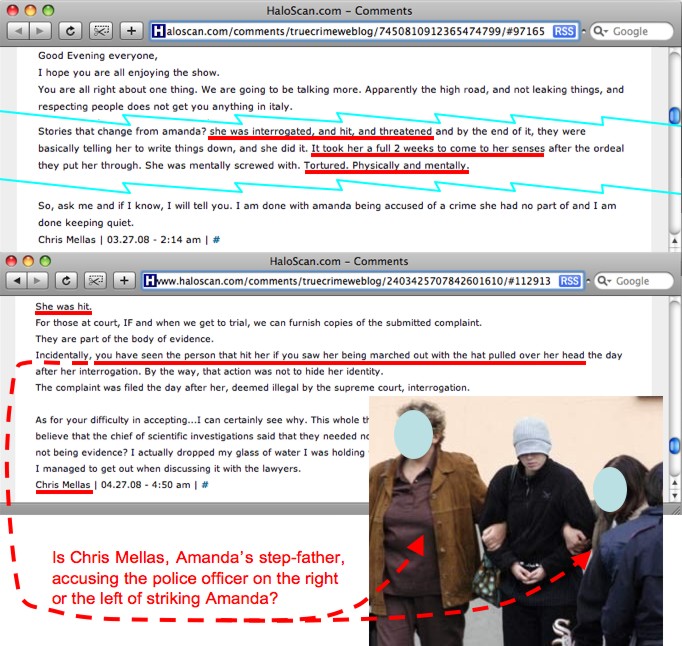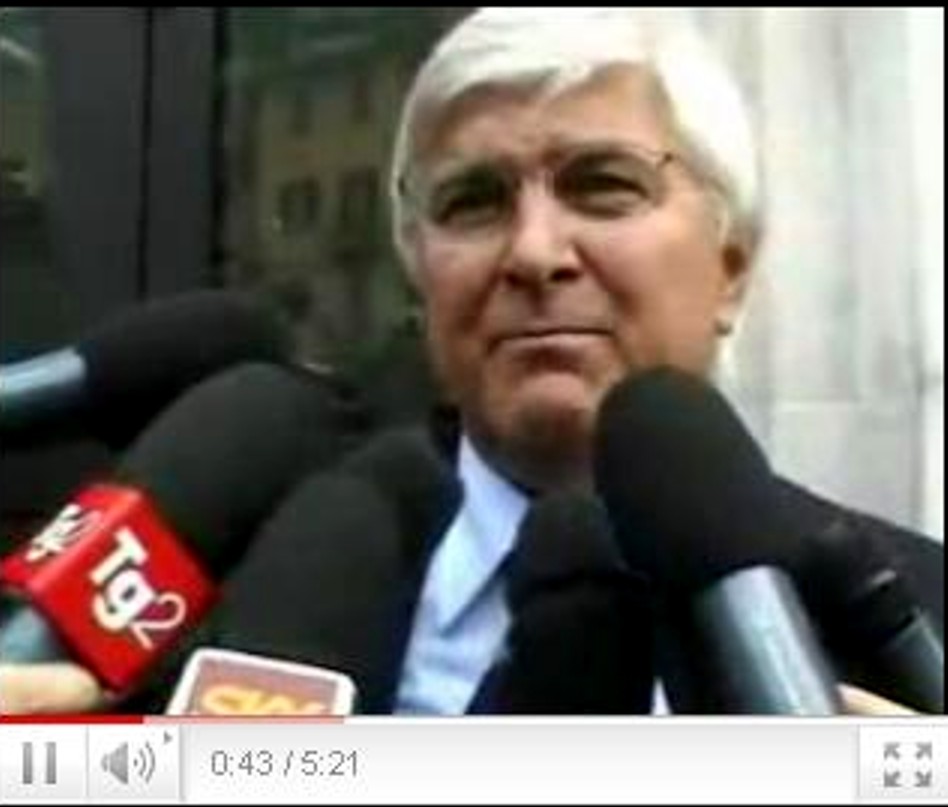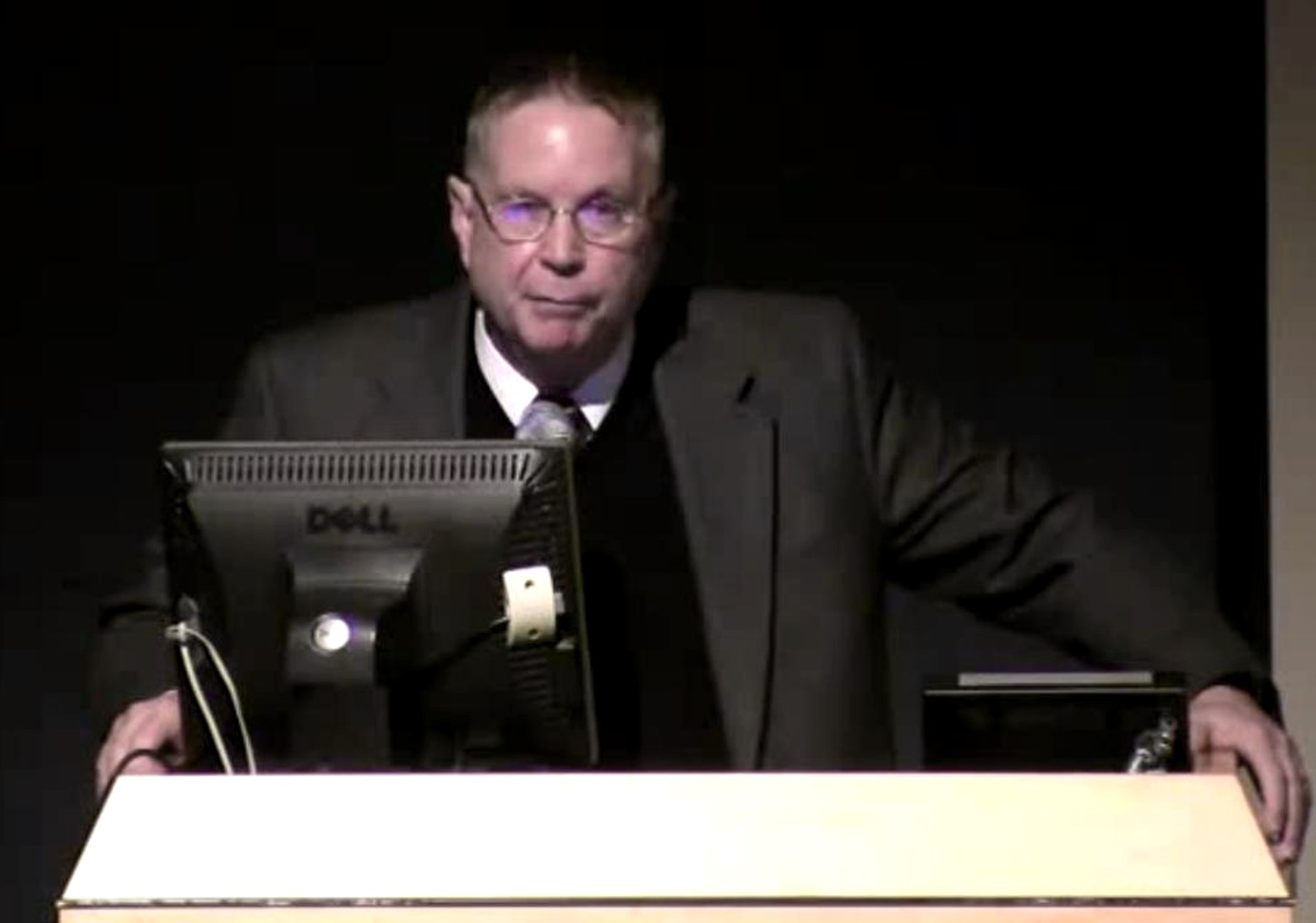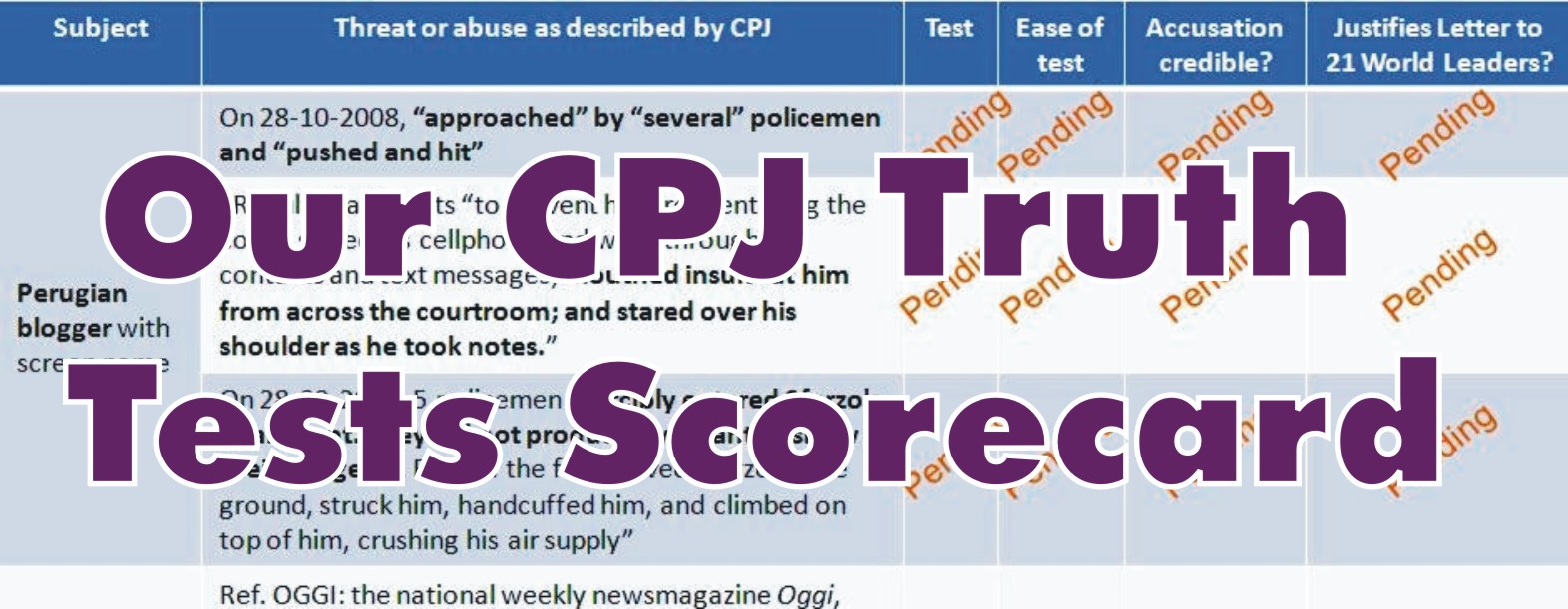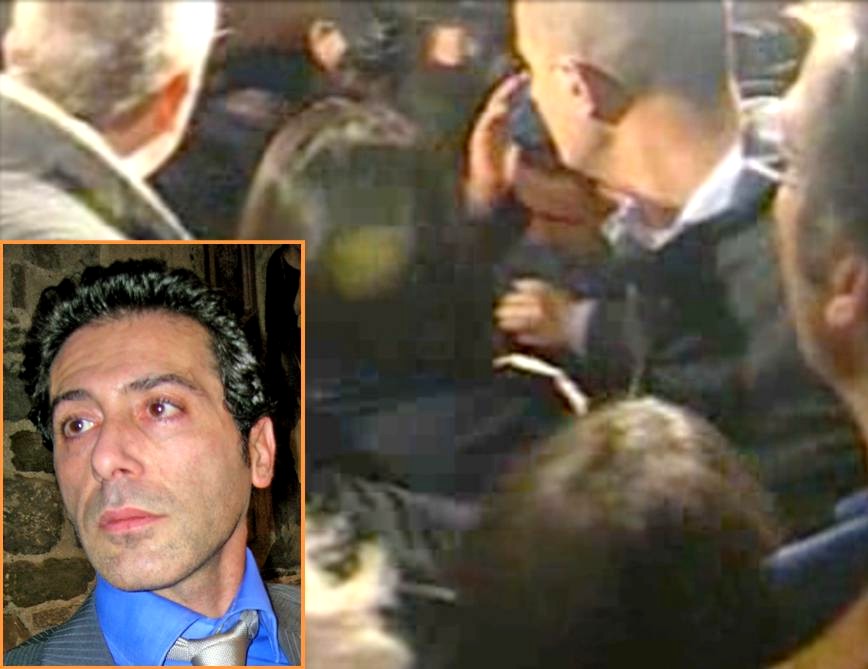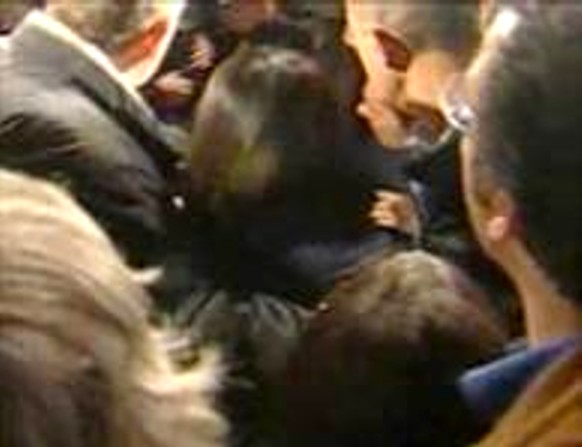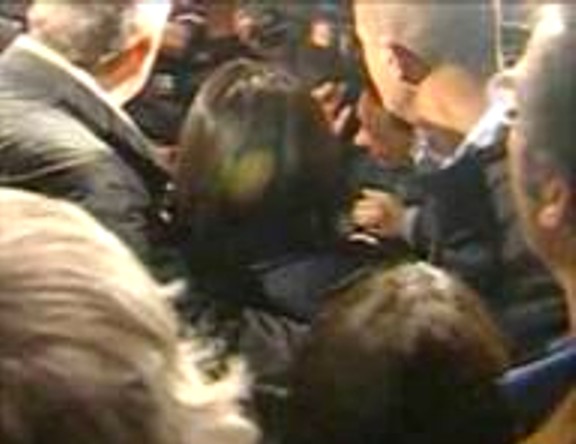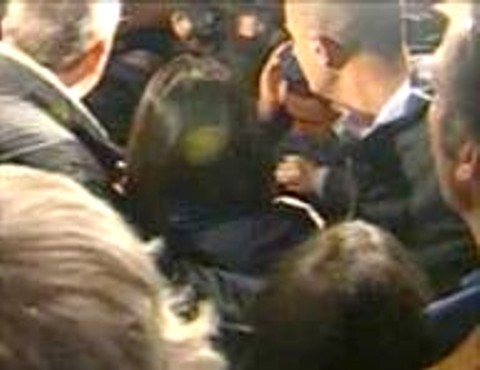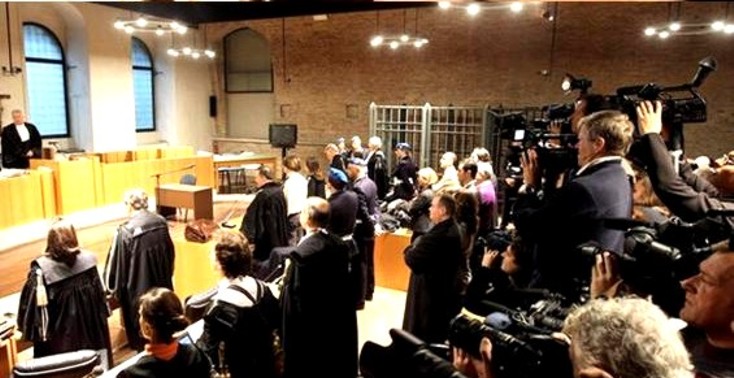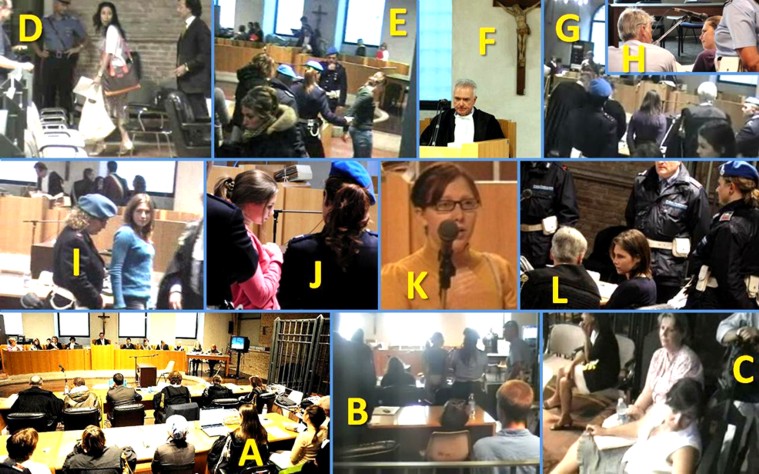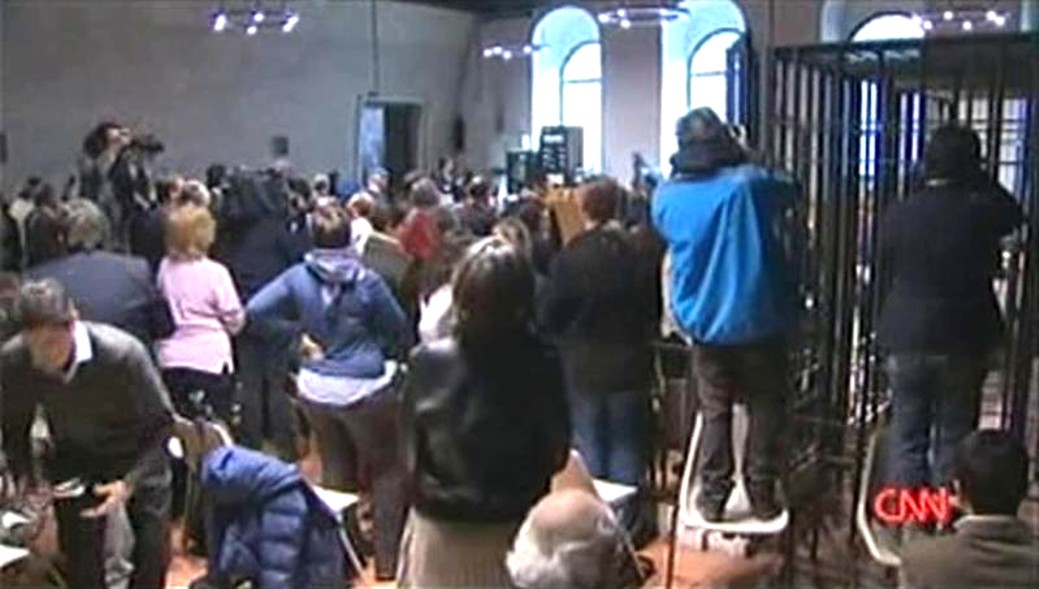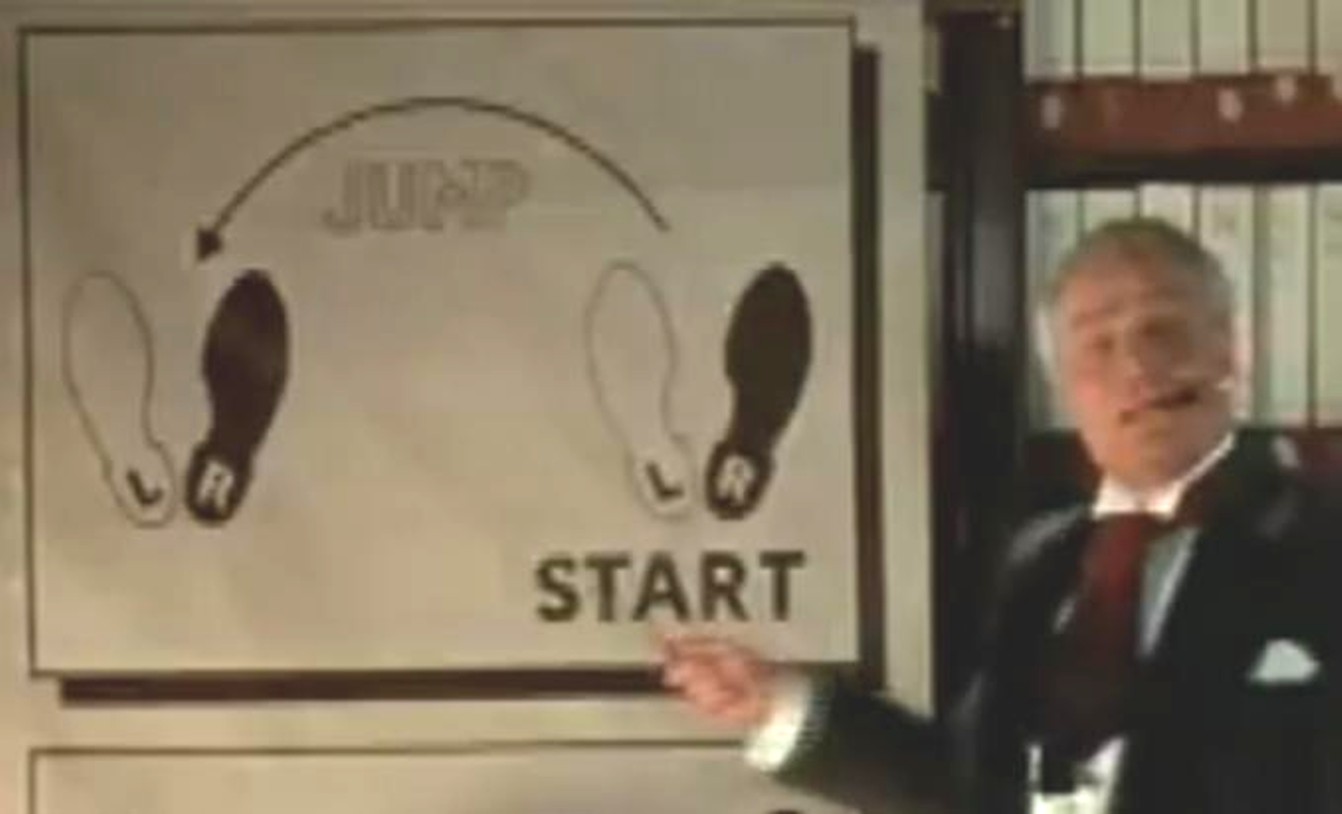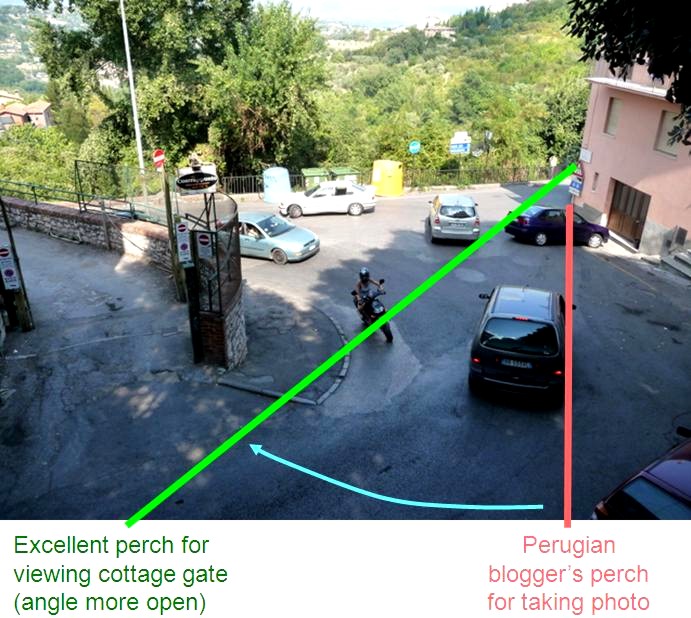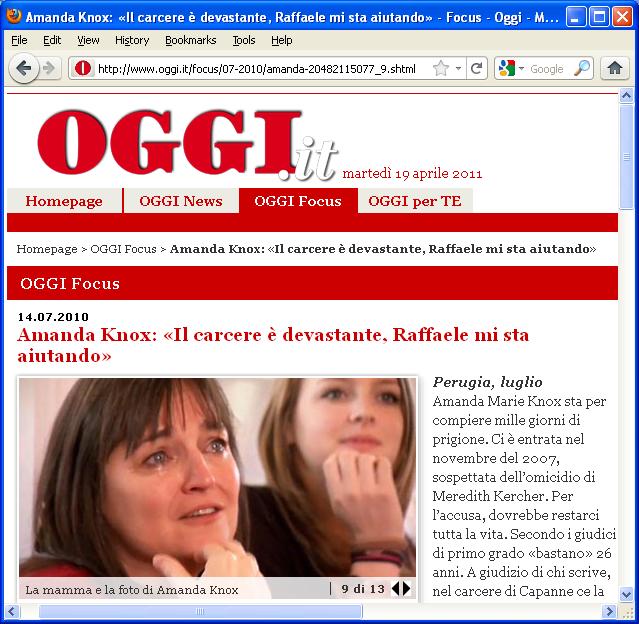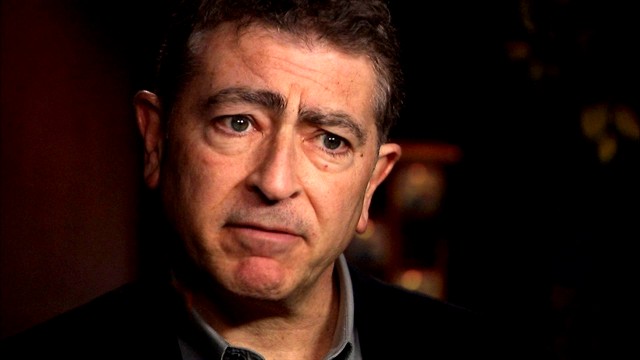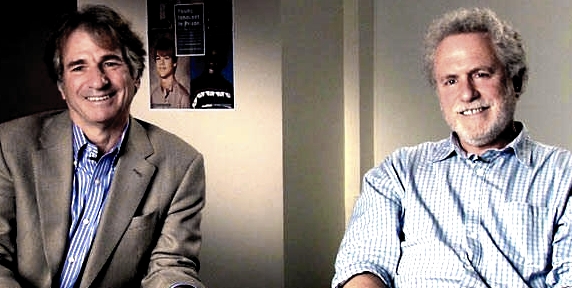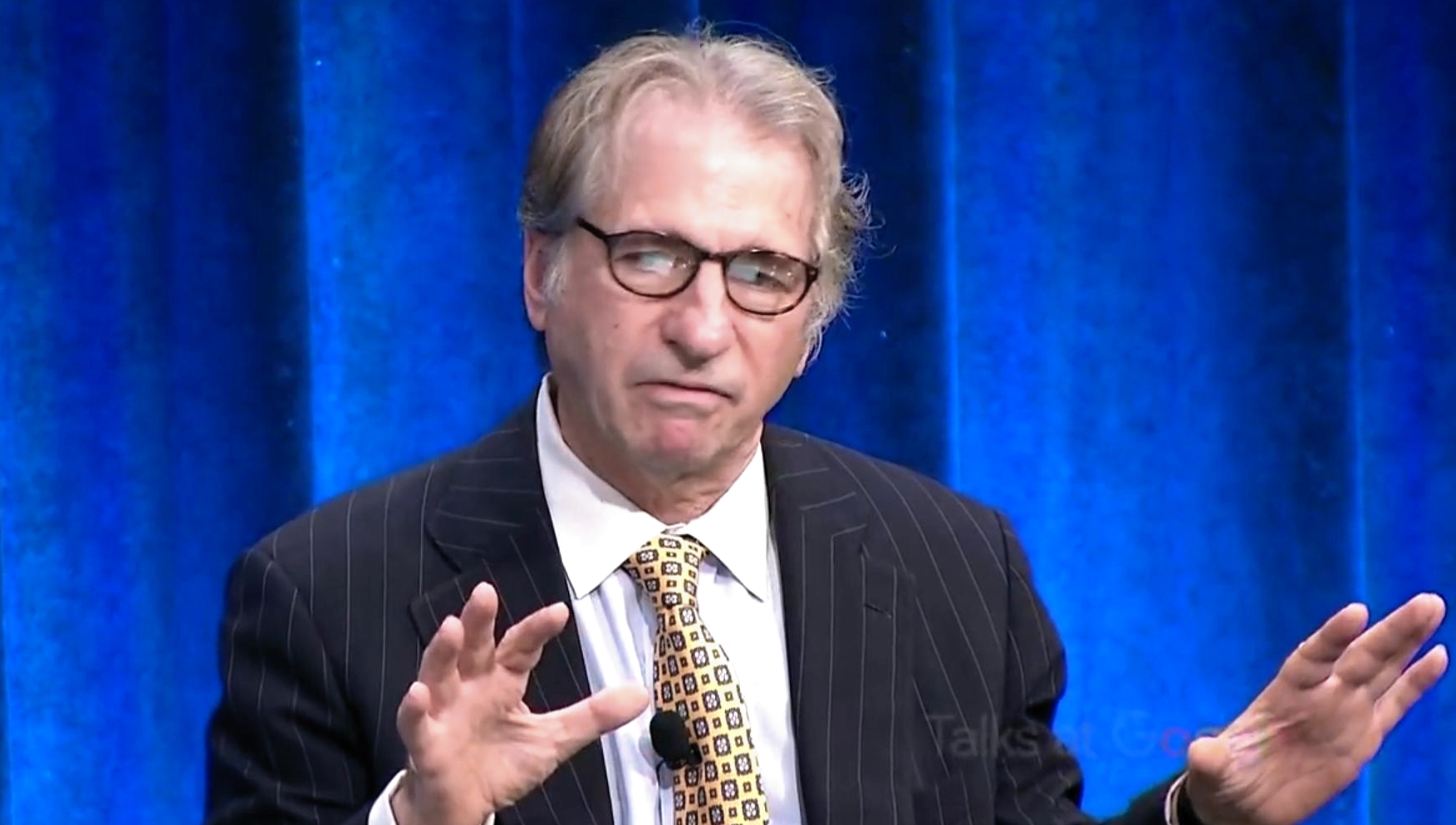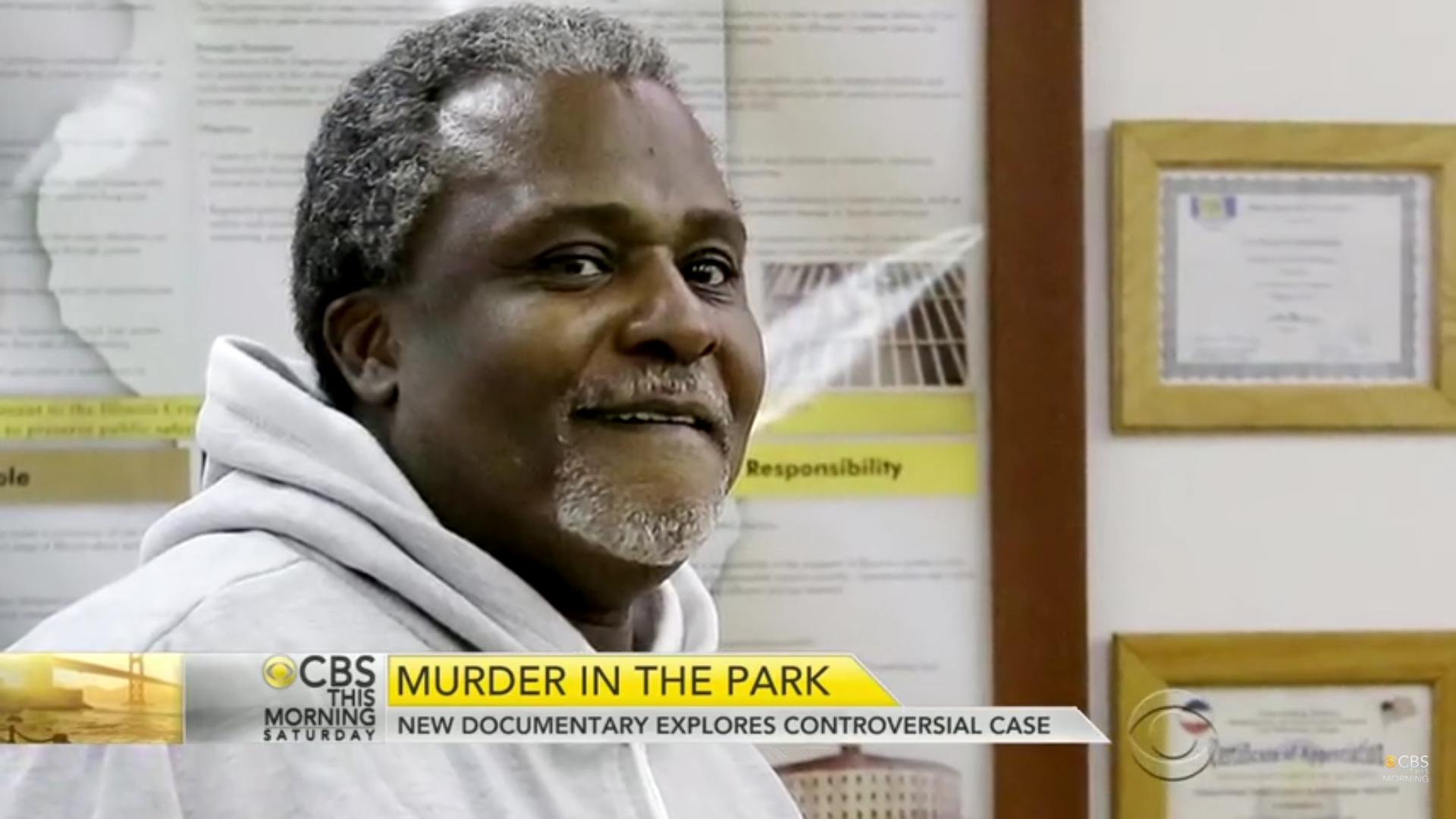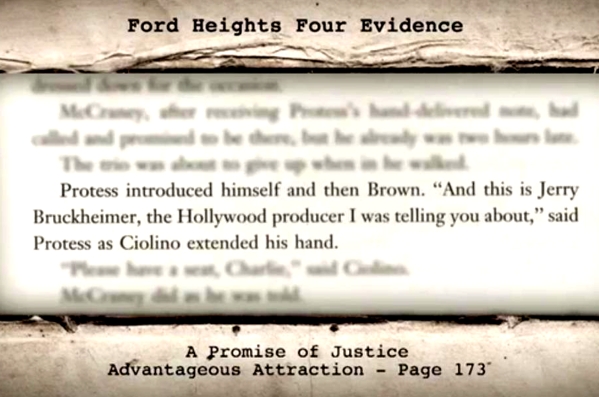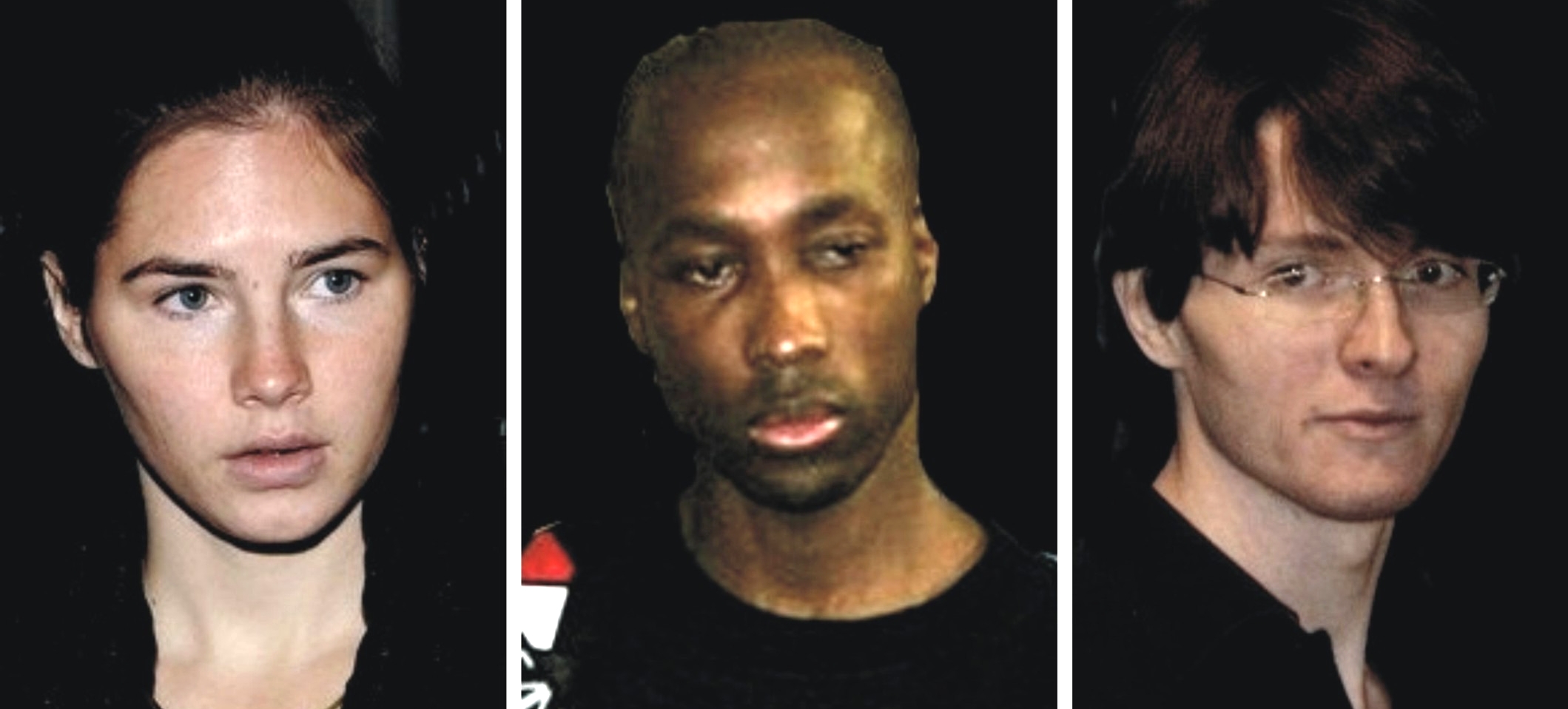
Open Letter To CPJ’s Joel Simon In New York: This Is The Fact Finding YOU Really Should Have Done
Posted by Kermit
Attn. Mr. Joel Simon
Executive Director, Committee to Protect Journalists
330 7th Avenue, 11th Floor, New York, NY 10001
Dear Mr. Simon,
Concerning CPJ’s letter to Italian President Giorgio Napolitano on press freedom
One week ago the Committee to Protect Journalists emailed an open letter to the President of Italy on press freedom in the Meredith Kercher case. This letter was copied to a number of other notables worldwide and also it was put online.
I believe this letter is factually highly inaccurate, is ill-researched, and is very unfair and possibly libelous to the officials in Rome and Perugia that it criticises. It is likely to do a lot more harm than good, and may come to blemish the CPJ’s fine reputation.
I am extremely familiar with this case. I live in Europe and visited Perugia very soon after Meredith Kercher’s sad death. I have long participated in online discussions seeking justice for Meredith and some closure and peace for her suffering family. I post under the name of Kermit. You can see my 13 TJMK posts here which have received many media mentions. I use Kermit as an online ID to maintain my personal life separate from my on-line life. I am NOT a journalist and so my real name is a minor issue.
Your open letter was dedicated to a large extent to detailing supposed abuse suffered by an anonymous blogger who you appear to believe is an impartial and credentialed journalist. You say this was at the hands of Italian national police officers who you seem to indicate follow illicit orders of an Umbrian prosecutor, Mr Giuliano Mignini, instead of their own superiors in the national police (Polizia di Stato). You also accuse Mr. Mignini of being the source of various threats to this anonymous blogger and real journalists, citing what you think are valid examples.
In fact, as we will see, all of the supposed threats in your examples are either vague or cannot be associated with Mr. Mignini. In some of your cases the “reporting” Mr Mignini takes exception to is the publishing of unsubstantiated accusations, for example concerning his state of mental health.
I’m surprised that in investigating one specific alleged case of abuse against a local Perugian blogger, that you haven’t noticed a massive, very nasty, highly misleading and well oiled campaign to malign and vilify Perugian and Rome authorities and to some extent Italy in general. Nowhere do you mention that specific persons directly and indirectly associated with that campaign seem to have something to gain by taking down Mignini and by setting free the convicted murderers of Meredith Kercher (pending appeal). Nowhere do you mention that REAL journalists like Andrea Vogt and Barbie Nadeau have received enormous heat and online libels for simply trying to report facts impartially from the court and from Seattle.
I would make a request that the staff of the Committee to Protect Journalists research further the points I bring up, and I would ask that if this research paints a picture different from what has been described in your text of last April 19, then you issue a followup letter to clarify these points, sending the followup email to the same 21 receivers of the first text.
Perhaps most importantly, you could contact Mr. Mignini himself and get his side of it. Others including the BBC have managed to do so and you should be aware of this BBC report. Mr Mignini has already publicly denied through Italian and international press publications some of the accusations which you are making in your letter, such as that Douglas Preston will be arrested if he returns to Italy. He states clearly that is not true.
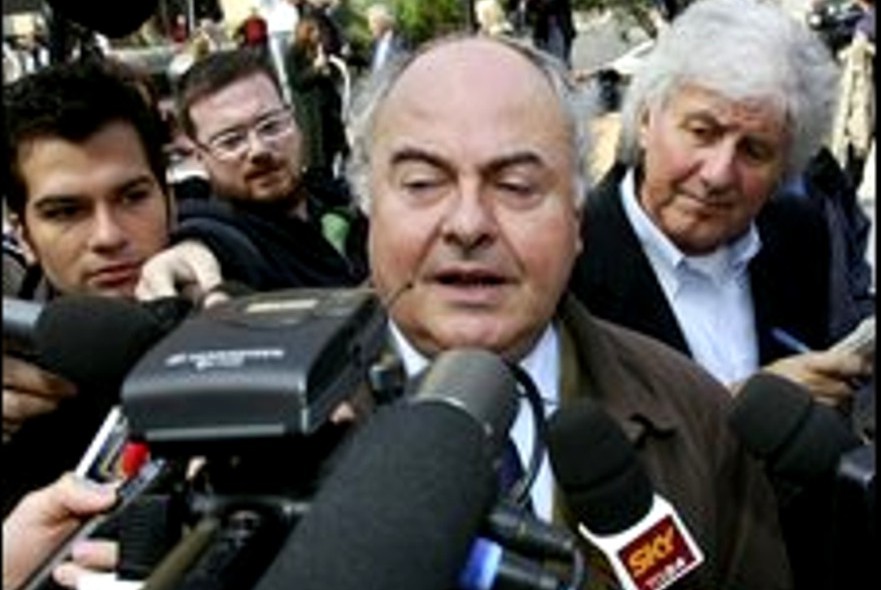
[Above: The forgotten fact in the CPJ text: When did this journalistic organisation contact Mr. Mignini, in order to contrast the accusations against him by a blogger who lives behind a pseudonym? (Photo credit: BBC)]
In the rest of this open letter I intend to examine below one by one the disputed points in the CPJ letter to the President of Italy. This statement is the first.
From the CPJ letter to the President of Italy and 20 other European and International figures:
“Dear President Napolitano,
The Committee to Protect Journalists, an independent, nonpartisan organization dedicated to defending the rights of journalists worldwide, is deeply concerned about local authorities’ harassment of journalists and media outlets who criticize the official investigation into the November 2007 brutal murder of British exchange student Meredith Kercher in the central Italian city of Perugia.”
The international network of followers of the Meredith Kercher case and its pre-trial investigation are not aware of any harassment of journalists by Mr. Mignini (or police agents who may have received instructions from him when the investigation was underway), from the moment of the crime, until the investigative report was delivered to the court in June 2008.
The allegation of harassment is news to us, in a case which over the course of almost four years has already gone through the lower court (three suspects each convicted of murder and other crimes) and is currently in the appeals stage.
The legal action taken by Mignini (or threatened action) in the case cited of the West Seattle Herald reporter Steve Shay writing that “some in both the American and Italian legal field believe Mignini is mentally unstable” doesn’t surprise me. Most people would see that not as a legitimate criticism of the official murder investigation as the CPJ states in its letter to the President of Italy, but rather as an unsubstantiated low blow without any professional journalistic contrasting of that claim. Mignini’s response is not an aggression to silence the West Seattle Herald, but rather a question of defending one’s personal honour and reputation. Mignini’s legal action would be taken on a personal level, not as an element of the Meredith Kercher murder case.
Or are legal professionals’ personal freedom and constitutional rights suspended in the light of unsubstantiated press claims? Is Mr. Mignini unable to defend himself against false accusation? Can the press make unsubstantiated and uncontested claims about anyone’s state of mental health without being subject to redress?
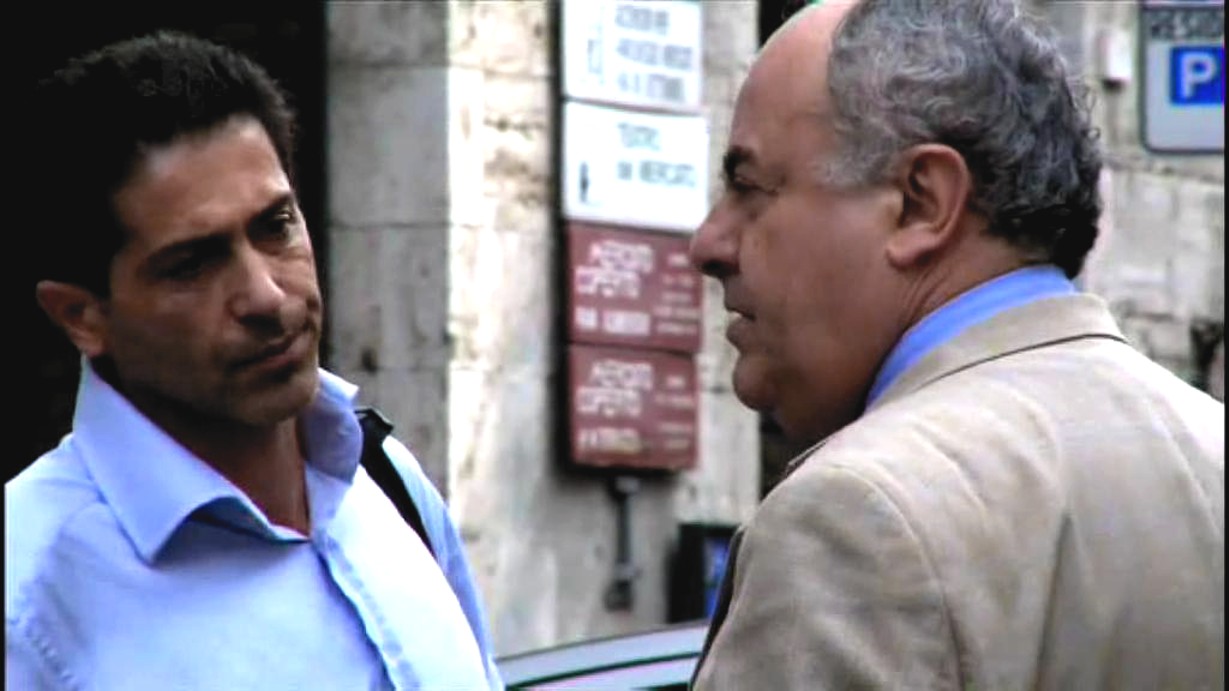
[Above: The Perugia blogger dispatching with Prosecutor Mignini, at a date believed to be after the start of the alleged harassment supposedly carried out under orders of Mignini. They seem to be interacting without any problem. (Photo credit: UK Channel 4)]
From the CPJ letter to the President of Italy and 20 other European and International figures:
“The Kercher murder investigation was headed by Mignini and conducted by a Perugia police unit known as the Squadra Mobile. Mignini was also in charge of the latest investigation into the unsolved murders of eight couples in Tuscany between 1968 and 1985, collectively known as the Monster of Florence killings”
Out of three affirmations in the preceding paragraph, only one is true, the first. Mr. Mignini was indeed the head of the investigation into the murder of Meredith Kercher.
The second affirmation is partially true. The Italian national police (Polizia di Stato - not “Perugia police” as you state) in Perugia was substantially involved in the Meredith Kercher murder investigation, be it Squadra Mobile units, medical examiners, local forensic and technical experts, as well as specialist forensic units brought in from Rome. These people report to their own chiefs and superiors in the hierarchical structure of the national police, although they would have carried out specific approved investigative actions within the framework of this investigation under the instructions of Mr. Mignini (and the next day they would be carrying out investigative actions for other prosecutors in other cases).
The third affirmation is false. Mr. Mignini is a prosecutor in Perugia, in the region of Umbria. As the nickname indicates, the “Monster of Florence” killings were carried out around Florence, in the region of Tuscany with the same .22 Beretta pistol between 1968 and 1985 (it is debatable whether the first crime of 1968 was done by the same perpetrator of the following string of murders, but they are clearly decades old crimes).
Various Florentine prosecutors participated in the investigations and trials related to the murders done by the Monster of Florence. Mr. Mignini was never “in charge” nor even involved in those investigations. It was a different time and different place.
The last of the police investigators in this Florentine case (so important and complex that instead of having a prosecutor control the case, there was a sort of super-cop who oversaw and directed all investigations, requesting prosecutors to authorize certain investigative actions) was called Michele Giuttari. It was under his analysis and investigation that the theory relating the Monster of Florence killings to occultism was developed.
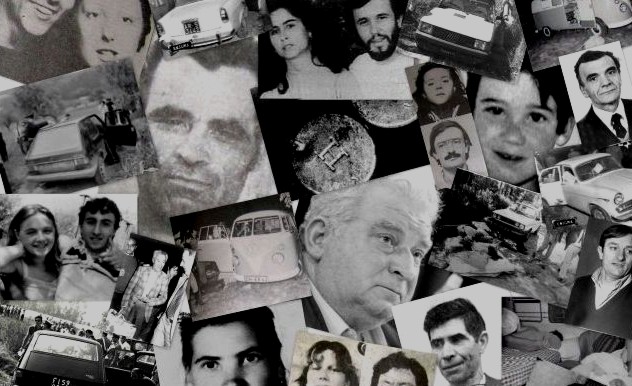
[Above: The Monster of Florence’s Beretta pistol killed 8 couples between 1968 and 1985. Mr. Mignini was uninvolved in the main investigations and trials of these decades old crimes, as he lives and works in Perugia, in a different location and in a different time frame. (Photo credit: Insufficienzadiprove)]
In a separate action, years later in 2001, Mignini reopened the investigation into the death of Dr. Francesco Narducci, initially thought to have drowned in a lake near Perugia. There were potential links between Narducci’s death and the perpetrators of the Florence murders.
Actually, if you want to understand better the Narducci case (from it being reopened in 2001) and understand its relation to the Monster of Florence case, please read the Perugian blogger’s summary on his blogspot page.
This mixing up of the facts of the Monster of Florence case is not new. I fear that American author Douglas Preston ““ who has substantial financial interest in the book sales and movie royalties related to his book The Monster of Florence (and who is also a financial supporter of CPJ ) - may have had direct or indirect input into the sculpting of this imprecise CPJ missive, which doesn’t really link Mignini to any of the events the Perugian blogger in question is supposed to have suffered (this is just an opinion).
Why? Preston is exploiting his own run-in with Mignini years ago, when the latter interviewed him concerning his activities and knowledge relating to shared elements and suspects of the Narducci and Monster of Florence cases.
For authors Mario Spezi and Douglas Preston researching the Monster of Florence case in Florence, super-cop Michele Giuttari was the source of much of their criticism of the case. In spite of being shaken up in early 2006 due to his interview with Mignini, Preston said a few months later in an interview with The Altantic:
Question: “Do you think that the investigation has become personal for (police investigator Michele) Giuttari?”
Preston: “I think even more than for Mario and me “¦. Giuttari really doesn’t have anything beyond the Monster case. His entire career rides on this case and solving it””or at least not making a fool of himself while he investigates “¦. So yes, it is personal. I think that everyone in Italy acknowledges that Giuttari seems to carry a great personal animosity against Spezi.”
Question: “Judge Giuliano Mignini, the public prosecutor who interrogated you, is another important player in the case. Was Mignini just doing his job? How much weight do you give to the idea that Mignini had it in for Spezi and you?”
Preston: “”¦. As for Mignini himself, I think he’s a sincere man and an honest and incorruptible judge. I don’t think that he’s a bad man “¦. I think he was doing his job the best he could. I think in many ways he was badly misled by Giuttari, the police officer who was running the investigation.”
Now there’s something I don’t understand. All the bad things we’re hearing about Giuliano Mignini since late 2007, in particular from Doug Preston seem to have been cut and pasted from Preston’s comments about Michele Giuttari, the chief investigator in the last legs of the Monster of Florence investigation, and these bad characteristics have been assigned to Mignini.
Preston has simply “cut” (not pasted!) the name Michele Giuttari from any mention ““ the once bad-ass investigator of the Monster of Florence as a larger-than-life persona is gone from his recent writings on the case.
And Mignini has been reassigned Giuttari’s nefarious role, even though Mignini is from Perugia and he investigated the Narducci death. The link (albeit important link) to the Monster of Florence, is that since Narducci could have been associated ““ according to initial investigative data in 2001 ““ with persons related to Giuttari’s old Monster of Florence theory, therefore Mignini assumed the Monster of Florence occultism theory developed in the Florence investigations.
Preston’s switch-a-roo has happened even though Preston had good words for Mignini in 2006 after his questioning at the hands of this prosecutor.
What happened? Well my opinion is that with literally dozens of books out about the Monster of Florence, someone realized that yet another book by Preston and Spezi would need some commercial umpah, especially if it was to be taken to the English-speaking market (Spezi had already written one book on the case, now he was writing another ““ Giuttarri had also written books on the case, in addition to many other authors).
The terrible murder of Meredith Kercher, and the fact that Giuliano Mignini was on duty as prosecutor on that All Saints long-weekend was what was needed. The English-speaking press has covered the murder on an on-going basis since then. Amanda Knox’s family hired a PR firm which uses that PR contract as a case study on their website, explaining proudly how “Gogerty Marriott’s work for the (Knox-Mellas) family has brought them in touch with all major U.S. news networks ““ ABC, CBS, NBC, CNN and Fox News, as well as independent programs such as Oprah Winfrey and a host of national and international magazines and newspapers”. (Source: Gogerty Marriott website.)
My theory is that with Amanda Knox being arrested and tried for the murder of Meredith Kercher, the latest book on The Monster of Florence had found a great, long-term PR strategy to latch on to. All that was required was to change the hated satanic-obsessed, rogue investigator figure of Giuttari into the civil servant Mignini, a prosecutor in the sleepy town of Perugia who has never published a book in his life. This focus requires that one stops talking about Giuttari. Done. And that one talks a lot about Mignini and his satanic theories, Perugian Mignini the lead prosecutor of the Monster of Florence (well, if you say it loud enough and long enough and put it into a Hollywood film, that’s what people will remember). Done.
From the CPJ letter to the President of Italy and 20 other European and International figures:
“The anti-press actions of Squadra Mobile under Mignini’s supervision, coupled with Mignini’s longstanding record of harassment of journalists who criticize his conduct on the job, cause the press to stay away from sensitive subjects, including important developments in the Kercher case such as the appeal of two defendants in the case.”
Who told you that the Squadra Mobile police unit is under Mr. Mignini’s supervision? You would do well to consult sources other than those who helped you draft your text.
The investigation of the murder of Meredith Kercher lasted from the moment of discovery of her body by the Italian telecommunications police who appeared at the victim’s home to inquire about a lost mobile phone on 2 November 2007, until Mr. Mignini presented his investigative report in June 2008.
As previously mentioned, different police investigative and forensic units would have received specific and / or ongoing instructions during the course of the investigation to carry out individual tasks in gathering evidence, but outside those tasks and in particular since the closing of the investigation in June 2008 the national police work at the central police station (“Questura”) and report in their daily work to other police officers, while Mr. Mignini works in his magistrate’s offices and has his own reporting hierarchy.
According to the CPJ the alleged harassment of the Perugian blogger started in October 2008, long after the close of the investigation into Meredith Kercher’s murder. (It should be underlined that since then, the only driving force behind advancing the legal proceedings against the three persons accused and convicted of murdering Meredith Kercher is not the prosecution ““ specifically Mr. Mignini - but rather the judges who are hearing the different levels of trial and appeals.)
The CPJ seems to be insinuating ““ no, more than that, it is accusing Mr Mignini of having extra-official links to police officers who allegedly harass a local Perugian blogger, as if Mignini had some sort of personal “hit squad” or goons at his beck and call.
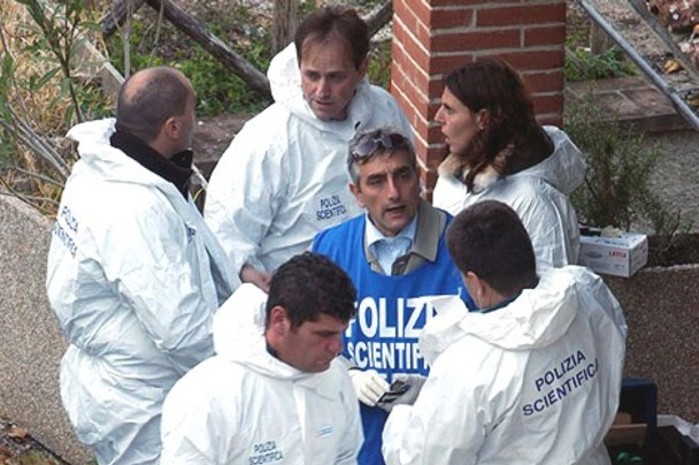
[Above: These are some of the police investigators whom Mignini was able to use as a part of the investigation into the murder of Meredith Kercher. CPJ may want to pass this photo to the Perugia blogger, to see if he is able to identify some of the police officers who allegedly attacked him three years after the crime, two years after Mignini’s investigation ended, and almost one year after the first level trial ended and Judge Massei and the judicial jury found Amanda Knox and Raffaele Sollecito guilty of murder.]
The CPJ letter to the President of Italy also refers to “Mignini’s longstanding record of harassment of journalists”. CPJ probably acted correctly within its terms of reference when it sought to bring attention to the plight of Mario Spezi in 2006 when he was arrested by Mignini (whether that arrest was justified or not). What other examples of does CPJ have of Mignini’s historical “record” of supposedly harassing journalists? Suing because reporter Steve Shay writes an unsubstantiated mention of Mignini being mentally unstable?
From the CPJ letter to the President of Italy and 20 other European and International figures:
“CPJ is particularly concerned about the impact Perugia authorities’ repressive actions have on local reporters and individual bloggers, who lack the support and backing of major publications”.
“CPJ is particularly concerned” “¦ Why did the CPJ get concerned? Can I ask how the CPJ became aware of the supposed harassment of the Perugian blogger by Mignini, and who has developed the “case” presented against Mignini in the CPJ letter?
Has the CPJ questioned the motives of the person(s) who helped develop this document and their potential “stake” in having the CPJ accuse Mignini of harassment? Will they gain by further book sales or movie royalties by creating a media interest in a supposedly rogue Italian prosecutor?
“Perugia authorities’ repressive actions have on local reporters and individual bloggers” “¦ Please be clear: are there other Perugian authorities beyond Mignini involved in this harassment , i.e. is there a conspiracy involved? Or is the situation the opposite, that the “Perugia authorities” are individual policemen who may have bothered the blogger in question, and so someone in CPJ decided to make a dotted-line to Mignini ““ if so, on what basis is this dotted line made? Who made it?
You refer to “local reporters”. Beyond the blogger, who are the local reporters who have suffered at the hands of Mignini? Is there anyone?
On one hand, have any local reporters, or on the other hand has the blogger in question made any formal complaint about the alleged abuses suffered? If he (or they) haven’t felt comfortable presenting a complaint in Questura in Perugia, they could go to the Carabinieri or other locations to present such a complaint. If no formal complaints have been made by the blogger in two and a half years of harassment, why not?
I agree with you that in general terms, news outlets that are limited in circulation and critical mass are more at risk to suffer harassment from authorities. In this regard, I encourage you to contact a couple of the local newspapers in Perugia such as Il Giornale dell Umbria (editor: Giuseppe Castellini) or Corriere dell Umbria (director: Anna Mossuto).
Ask them about possible harassment by Mr. Mignini. Even better, while you’re at it, why don’t you do a peer check, and ask them about the local blogger you have become concerned about?

[Above: The CPJ should make immediate contact with local newspapers in Perugia such as these, in order to evaluate in situ the possible harassment of local reporters by Mr. Mignini.]
From the CPJ letter to the President of Italy and 20 other European and International figures:
“Of the cases that have come to CPJ’s attention, one stands out because of the abusive actions employed by members of Squadra Mobile to punish a critic of the official Kercher murder inquiry. Local freelance reporter Frank Sfarzo (real name Sforza) created his English-language blog Perugia Shock in 2007, days after Kercher’s gruesome murder.”
You say that it was Squadra Mobile police officers who “punished” this critic of the investigation. Can those Squadra Mobile officers be identified? (I imagine so). What is the link between those Squadra Mobile officers and Mr. Mignini? Do the direct superiors of those officers in the national police know of this supposed secret relation? Or are those direct superiors of the national police part of the conspiracy too?
(If you don’t mind a slightly ironic comment on my part, if you go all the way up the national police structure, you may find that President Napolitano as well as parliamentary judicial committees where one of Raffaele Sollecito’s defense lawyers is present are also part of the irregular reporting lines of the Mignini conspiracy.)
By the way, it’s not important to this question, but just to be clear, I believe that the Perugia Shock blog page was established just prior to the murder of Meredith Kercher, and may have been destined for some other purpose when the murder occurred and the blogger in question decided to reorient the blog. The blogger in question also has web pages dedicated to buying Italian products such as truffles, not to mention a blog devoted to the Italian version of Who Wants to be a Millionaire.
In fact, while the blogger writes under the name of “Frank Sfarzo”, this appears to not be his real name. He seems to have indicated different backgrounds to different persons, including to newspaper reporters who have had contact with him. For example, he has described himself as a film professor to reporter Jonathan Martin of the Seattle Times.
To the BBC’s Julian Joyce he described himself as a journalist.
It’s not a major issue for me, but does the CPJ protect anyone who says they are a journalist, or only journalists with credentials, or members of a professional organization with a code of conduct? I just post comments on blogs and once in a while add my own research to the topics being discussed “¦ could I too as Kermit request protection from the CPJ if I deemed it necessary, say I received threats from a certain persons involved in a court case I was discussing?
Would you write a big letter to presidents and cabinet ministers and senators around the world? Or do you only do that when a well-off, best-selling American author is part of a personal feud with an investigative magistrate?
Pro-victim blogger Skeptical Bystander and other posters of the Perugia Murder File board could potentially be in need of such assistance, given the sorts of threats that she has received and that often goes untouched for days or weeks when posted on the Perugia Shock blog comments page.
From the CPJ letter to the President of Italy and 20 other European and International figures:
“Sfarzo told CPJ his troubles started on October 28, 2008, the day Knox and Sollecito were indicted and a third defendant was convicted of murdering Kercher. Several members of Squadra Mobile, Sfarzo told CPJ, approached him just outside the city court (Corte di Assise di Perugia) and started to push and hit him. “You are pissing us off!”—they told him, referring to his coverage.”
As mentioned, by October 2008, the investigation was out of Mignini’s hands and as a case was in the hands of the different judges who have tried Rudy Guede, Amanda Knox and Raffaele Sollecito. No police officers would be receiving investigative instructions from Prosecutor Mignini, unless if he had an extra-official relation to them that bypassed normal communications channels between the judiciary and the police.
I am not in a position to say that the person who blogs under the name “Frank Sfarzo” wasn’t pushed by policemen on 28 October 2008. However, you say that this happened due to his “coverage” of the case.
If you read the Perugia Shock blog pages, especially from the fall of 2008, you will see that they are written in broken English, and that the blog’s following at the time was limited. Did Mignini or the police officers read the blogspot page in English?
Your description of the alleged events outside the Corte di Assise (“several members of the Squadra Mobile “¦ approached (the blogger) just outside the city court and started to push and hit him”) bears little resemblance to the blogger’s own video of the event. I URGE YOU to view the video of the alleged aggression of the Perugian blogger (please click on link and scroll to end of post).
In the video, viewers see the family of the murder victim ““ Meredith Kercher ““ exiting the courthouse in the middle of a media scrum. There is jostling and pushing amongst the dozens of reporters on the scene.
The blogger struggles for a good angle and seems to be walking backwards as he tapes his video. Meredith’s sister is easily identifiable. The blogger tumbles. Was he pushed? Maybe. Was it a policeman or another reporter in the media scrum who bumped into him? Maybe one or the other, or maybe the blogger simply stumbled in his awkward backwards walk.
Did someone say something rude to him? Maybe. If something rude was said, was it due to his “coverage” of the case? Or simply because in the moving crowd the backwards walking blogger was getting in the way?
In any case, at no point do we see “several members of the Squadra Mobile” approach the blogger and “push and hit him”.
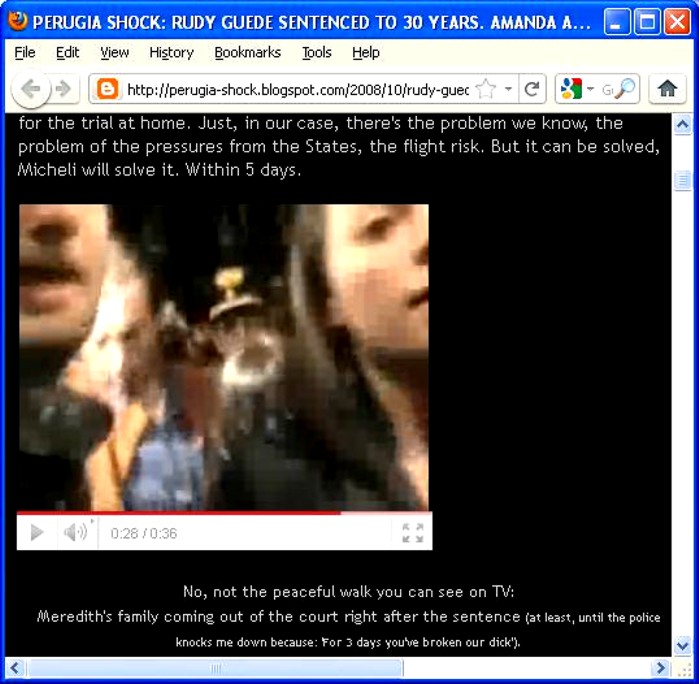
[Above: The Perugia blogger’s own video on 28 October 2008 of one example of the “aggression” which has provoked a letter from the Committee to Protect Journalists to the Italian President and 20 other international figures. Moments afterwards, he falls backwards, into the media scrum. Were he to have been attacked by “several members” of the Squadra Mobile, Stephanie Kercher ““ Meredith’s sister pictured at front on the right ““ would have been a point-blank witness to the crime. He had his camera aggresively in her face.
In addition, all of the Italian and international news cameras following the Kercher family from behind would have taped the perpetrators of such an aggression, if any. CPJ could use its contacts with media outlets present that day (there were dozens of journalists) to obtain video of the aggression, filmed from just a couple of metres away.]
From the CPJ letter to the President of Italy and 20 other European and International figures:
“When the trial of Knox and Sollecito began that December, Squadra Mobile continued to harass him. They regularly tried to prevent him from entering the court”
What are the requirements for entering a court session in Perugia? What priorities are assigned for press access? What press credentials have to be produced? What press credentials did the Perugian blogger have in December of 2008? Did he have any? Was this harassment witnessed by other journalists in Perugia to report on the trial?
Has the CPJ contacted other journalists covering the court sessions to inquire as to access procedures, or whether they saw the Perugian blogger being given a hard time (maybe he tried to access extra-early before other journalists ““ in order to get a good spot ““ and there were no other witnesses to the access harassment he suffered in these over-capacity court sessions).
From the CPJ letter to the President of Italy and 20 other European and International figures:
” . . . mouthed insults at him from across the courtroom; and stared over his shoulder as he took notes. “˜This was done in the presence of the judge, the Carabinieri [the military police], and the court guards, but they would do nothing,’ Sfarzo told CPJ.”
In all the images that I have seen of the courtroom in the trial of Amanda Knox and Raffaele Sollecito, the reporters are at the back, against the wall. Was there a “safety lane” which police officers patrolled behind the reporters and which they used to spy on the blogger over his back?
Did the police officers spy on any other reporters? Did any other reporters notice the alleged spying carried out on the blogger, or was it done in such a surreptitious manner that no one realized what was going on?
Please! Look at photos of the press area in the Perugia courtroom! It seems physically difficult for anyone but other reporters to be looking over reporters’ (or bloggers’) backs.
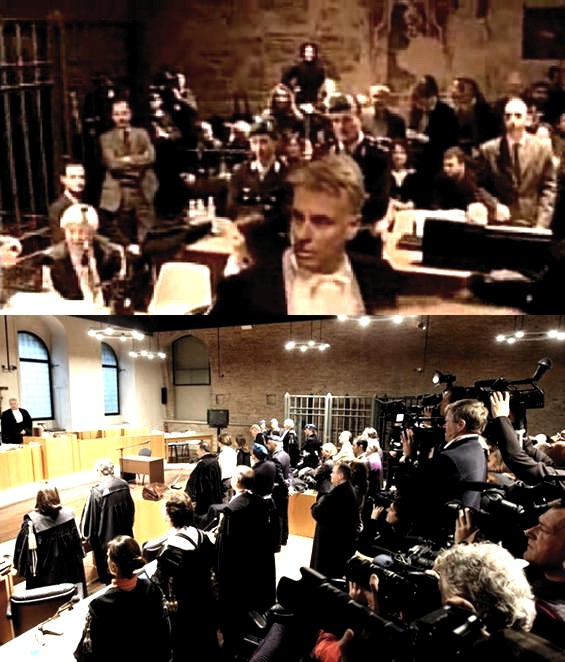
[Above: The Perugian courtroom where Amanda Knox and Raffaele Sollecito were tried. At the back behind the railing and against the wall: the press. In front of the railing: defendants’ family members and other authorized parties. In front of family members: guards. Finally, in the foreground, the defendants and their lawyers. For the national police to have looked over the blogger’s shoulder as he made notes, they would have to have elbowed their way through the press to an indiscrete and obvious positioning behind him (or, he would have had to been in a location not assigned to the Press, such as the defendants’ family zone, which could be a possibility). Have you asked the Perugian blogger about his relation to the Knox-Mellas family both in and outside of the courtroom? Is it limited to simply interviewing them from time to time, or is this relationship much closer with individual members of the family, beyond a traditional reporter-subject relationship?]
By listing the complicit passivity of the judges, the Carabinieri and the court guards in addition to the Polizia di Stato, CPJ does seem to have swallowed quite a large conspiracy, where Prosecutor Mignini not only is pulling the strings of three different police forces, but also the presiding judge of the case. The only way to make this bigger-than-life Evil Mignini Conspiracy into something bigger would be to turn it into a Hollywood movie.
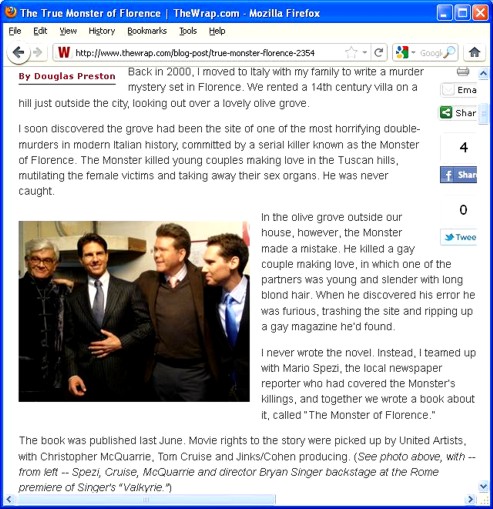
[Above: The Monster of Florence movie rights have been purchased by Tom Cruise. Any and all ways of stirring up and mixing up the English-speaking press’s coverage of Mignini’s Narducci investigation from 2001 onwards, and linking it and the high profile trial of American Amanda Knox to the decades old 1970’s and 1980’s Monster of Florence murders is free publicity for the book and movie” (Photo source: The Wrap)]
From the CPJ letter to the President of Italy and 20 other European and International figures:
“The harassment reached its peak on September 28, 2010, when five officers of Squadra Mobile forcibly entered Sfarzo’s apartment. They did not produce a warrant or show their badges, Sfarzo told CPJ. Four of the five shoved Sfarzo to the ground, struck him, handcuffed him, and climbed on top of him, crushing his air supply, he told CPJ.”
Has the CPJ made any attempt to validate these claims of mistreatment? One thing I don’t understand is where is the link between the blogger’s alleged mistreatment and Mr. Mignini?
If any blogger in Perugia feels that he or she has been bothered by the police, can they get the CPJ to intervene against Mignini even if there is no direct link that we can see?
Has the CPJ contacted the Questura (main police station) of Perugia to inquire as to the reason the team of officers was sent to the blogger’s home? Who was the police chief who sent them? Did Mignini just pick up his phone in his magistrate’s office, call the Questura and ask his policeman friends to go over and rough up a local blogger?
From the CPJ letter to the President of Italy and 20 other European and International figures:
“Next, the officers took Sfarzo to the Perugia city hospital, where they claimed he had attacked them; they persuaded a doctor to issue a medical report for the injuries Sfarzo was alleged to have caused. In addition, the Squadra Mobile officers brought Sfarzo before a psychiatrist, demanding that she issue him a certificate of insanity.”
Again, has the CPJ made any attempt to validate these claims? Has it been in contact with the doctors at the hospital who examined the blogger?
From the CPJ letter to the President of Italy and 20 other European and International figures:
“From the hospital, the officers brought a handcuffed and injured Sfarzo to their headquarters, where, in the blogger’s words, they “displayed me as a trophy,” referring to him as “the bastard who defends Amanda [Knox].” The officers refused Sfarzo’s requests to call his lawyer or his relatives, and put him in a cell for the night.”
Has the blogger’s lawyer taken any action to sue the police officers who allegedly attacked him? The normal starting point would be a formal complaint: has the CPJ requested confirmation that this incident legally exists from the blogger’s point of view, specifically that a complaint was filed at the time it allegedly occurred? If it exists, has the CPJ examined this complaint and inquired with police authorities as to the progress achieved in resolving it?
The truth of the matter is that this is reminiscent of one aspect of the Meredith Kercher murder case, where Curt Knox and Edda Mellas, parents of convicted killer (pending appeal) Amanda Knox were interviewed by John Follain of The Times of London. “Curt says: “˜Amanda was abused physically and verbally’” during her questioning on the night of 5 November 2007.
Now it may be that the same standards that the CPJ applies to Mignini also apply to the police who questioned Amanda on that evening, namely that they can be accused of crimes (beating a suspect) without the accusers having to provide anything to substantiate the accusation. However, in reality, as you can imagine (and probably as you or I would do), those police officers are suing Amanda’s parents for slander. Alas, in the days (and weeks and years) after Amanda’s arrest, it seems that no complaint of police brutality was ever actually filed with the police.
Above: The Knox-Mellas family members have repeated claims that Amanda was physically abused in her interrogation which started after 11 p.m. on the night of 5 November 2007 and was stopped at 1:45 a.m. They are in their rights to do so, but the OPJ should also recognise that police officers who are the targets of such accusations have the right to respond using the law to defend their honour and reputation. Or is that not so? (Source of posts: discussion board of the original Steve Huff True Crime Weblog)
In fact, Amanda’s lawyer Luciano Ghirga even denied at one point that she had been poorly treated, as the Perugian blogger informed the world on his site.
[LETTER CONTINUES below in the next post. Click here. Please post any comments under that post.]
Open Letter To CPJ’s Joel Simon In New York: This Is The Fact Finding YOU Really Should Have Done #2
Posted by Kermit
Concerning CPJ’s letter to Italian President Giorgio Napolitano on press freedom (#2)
[Above: Knox lawyer Luciano Ghirga stated on 21 October 2008: “Amanda wasn’t hit. There were pressures from the police, sure, but we never said she was hit.” Well into Amanda’s trial, and shortly after her stepfather’s arrival in Perugia, she unexpectedly stated in court that she had been hit by police during her questioning. Watch the whole video yes at the Perugian blogger’s site.]
From the CPJ letter to the President of Italy and 20 other European and International figures:
“Sfarzo (real name Sforza) was released pending a trial in May. He faces up to six years in prison if convicted. “˜The police can count on the complicity of judges,’ Sfarzo told CPJ”
Now I’m confused: I thought that it was Mignini who utilized and had the complicity of the national police in his nefarious actions against the Perugian blogger. Now it seems that the blogger (or CPJ) is saying that the national police manipulate the judiciary to advance some terrible agenda, with the complicity of judges. Please clarify, for the sake of sanity, is it Mignini or the national police who are the source of the harassment that the blogger suffers?
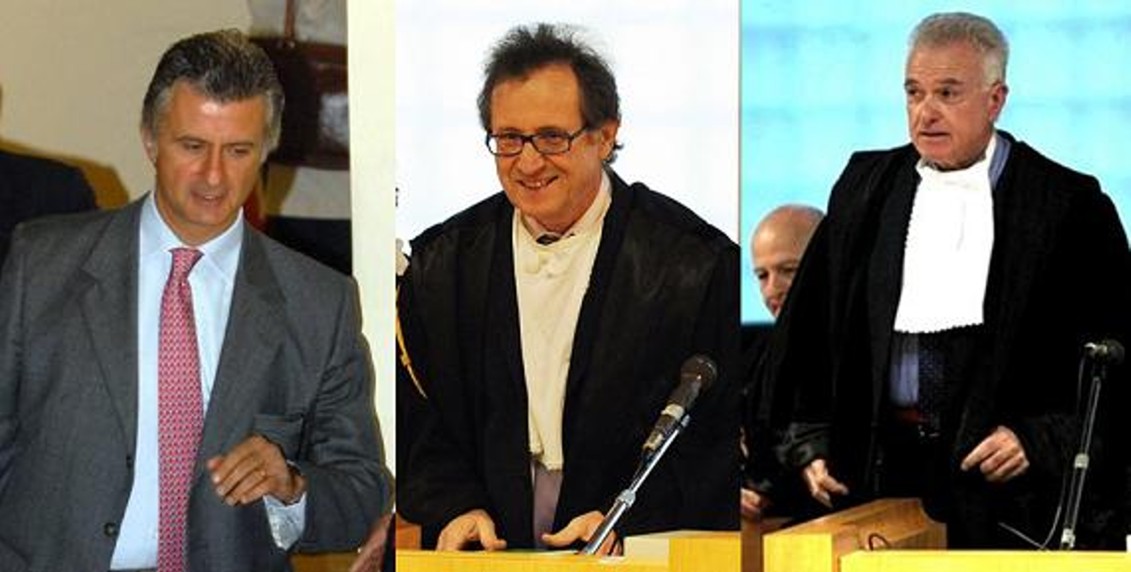
[Above: Now let me get this straight: Amanda Knox hearing and trial judges such as Paolo Micheli (left), Giancarlo Massei (centre), or Claudio Pratillo Hellman (right) are beholden to members of the national police? Where will the Evil Conspiracy stop?]
Although motive is not necessary to any crime, having one helps to understand a criminal action. This alleged harassment makes no sense. Mignini presented his investigation report three years ago. A guilty conviction was obtained, and the defendants are now in appeals, with different judges and new legal processes.
The case has for some time been out of Mignini’s investigative hands and is following its natural progression through different courts, under the guidance of the corresponding judges.
In the case of the national police, they don’t have any particular relation with the blogger as regards the Meredith Kercher murder case. Quite another possibility is that he has some other legal problem. Have you asked the blogger if he has any other legal question open, under his real name?
One question: if the blogger had been abused by Mignini or the Italian national police between October 2008 and September 2010, why is it only now that noise is being made about it?
In order to check out the blogger’s emotional state in the time frame of the alleged police attack, I took a look at his blogspot page for posts and comments in that time period.
The blogger’s last post before the alleged attack was on 10 September 2010. This post generated 586 comments, mostly before, but also some following the supposed attack on 28 September 2010 including comments by the blogger himself.
His first post following the alleged police attack was just a couple of days later on 1 October 2010. He writes “The mini media circus around the Meredith Kercher case materialized again in Perugia, surprisingly, for a closed door hearing “¦. Luciano Ghirga described her as showing a shorter haircut and as being concerned “¦”
In the 361 comments which this post generated, including comments by the blogger, I didn’t detect any indication that he had been through a harrowing experience at the hands of police officers who in some yet-to-be-defined-manner are remotely controlled by the prosecutor Mignini.
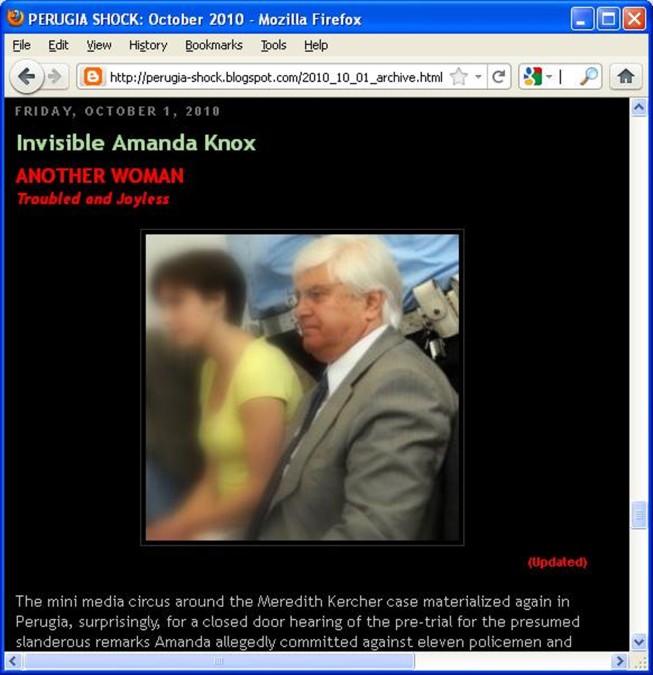
[Above: Business as usual. It’s 1 October 2010, just 48 hours after the supposed brutal attack which required the blogger to receive medical attention in the hospital. Yet his recovery is swift, and his texts don’t reflect the suffering he has gone through. (Image: Perugia Shock blog)]
From the CPJ letter to the President of Italy and 20 other European and International figures:
“Oggi editor Umberto Brindani also received two “notices of investigation” that year—dated July 24 and September 2—in relation to the magazine’s coverage of the Monster of Florence case, CPJ confirmed.”
If the CPJ was able to confirm a couple of notices of investigation against the well established national magazine Oggi, why didn’t the CPJ also try to confirm any of the alleged abuse against the vulnerable Perugian blogger who is the main point of the CPJ text? You indicate that you had direct contact with him.
For example, you could have asked the blogger to show you a copy of a complaint concerning the alleged attack by national policemen on 28 September 2010. Or the CPJ could have spoken with the hospital psychiatrist who supposedly examined the blogger following that alleged attack.
From the CPJ letter to the President of Italy and 20 other European and International figures:
“Preston, Spezi’s co-author who suffered harassment by Mignini himself in 2006—and eventually was forced to leave Italy for fear of imprisonment—told CPJ he was still afraid of going back. He has been unable to clarify his legal status in Italy. In the summer of 2008, Mignini told third parties that he would have Preston arrested if the writer returned, Preston writes in the Afterword to The Monster of Florence paperback edition, published in 2009.”
If Preston was “forced to leave Italy for fear of imprisonment” in February of 2006, then why did Preston go to Italy with an NBC “Dateline” filming crew in October 2006, just months after leaving under an alleged “threat” by Mignini, and four months after his interview in The Atlantic where he called Mignini “a sincere man and an honest and incorruptible judge”.
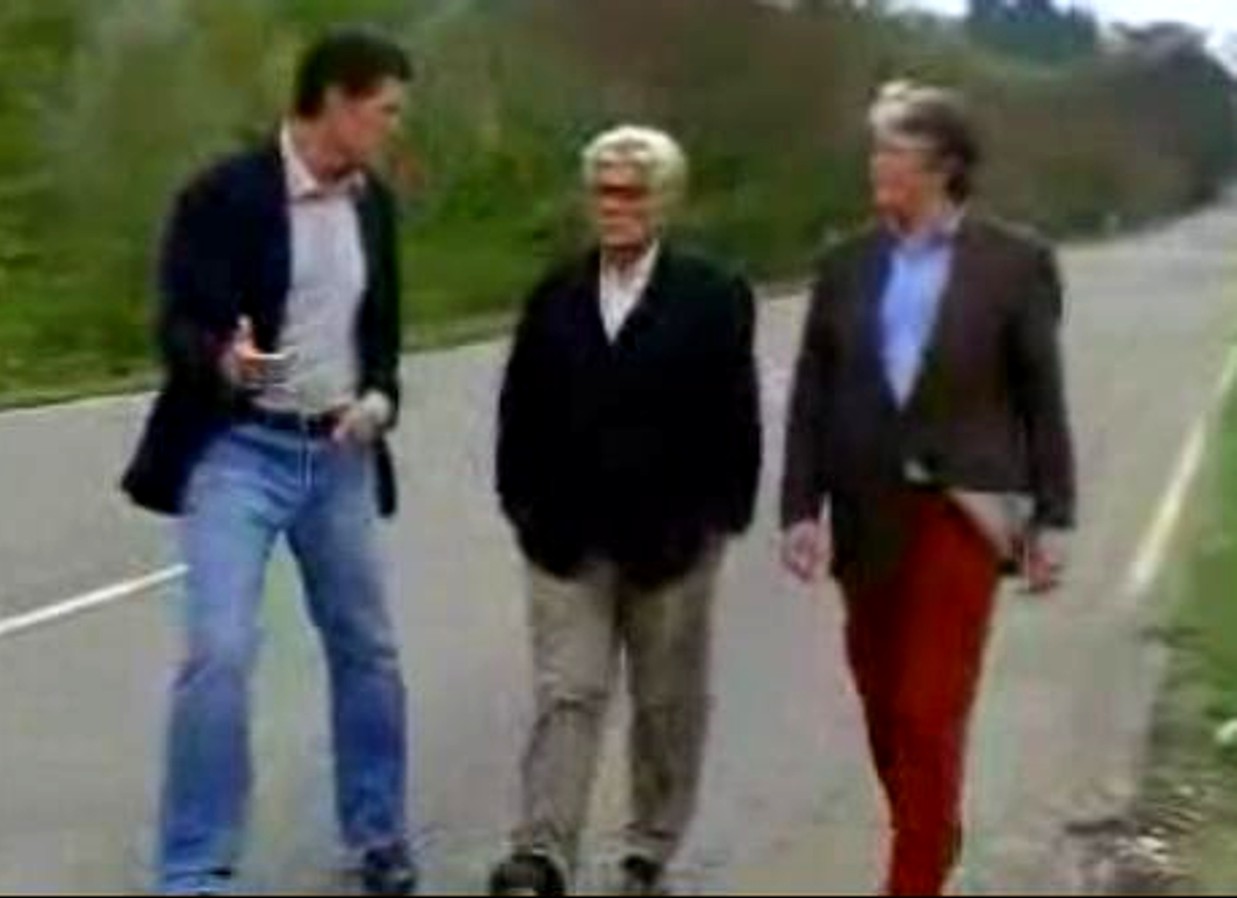
[Above: Many people are led to believe that Preston hasn’t been to Italy since his hasty departure after meeting Mignini in early 2006. In fact, he has returned with Dateline NBC to tape a show on The Monster of Florence. (Photo credit: Original source. And an alternative link to same story.]
Barbie Nadeau, an excellent and recognized reporter for Newsweek and The Daily Beast, wrote in a well researched article on Preston that he “also says that Mignini ordered him to leave Italy. Mignini says that he never asked Preston to leave the country, but instead suggested that Preston didn’t understand Italian and that he should get a lawyer.”
If you do further Googling, you will see that it appears that the only person who says that Preston can never go back to Italy (in spite of having gone back to Italy) seems to be Preston himself.
What Preston says he hasn’t been able to clarify, Mignini has repeated in a number of articles in the Italian and English-speaking press.
From the CPJ letter to the President of Italy and 20 other European and International figures:
“We ask you to ensure that the politically motivated lawsuit against Perugia blogger Frank Sfarzo is immediately scrapped and that outside investigators are assigned to conduct an investigation into the September 28-29, 2010, abusive actions of Squadra Mobile officers against him.”
On what basis can you affirm that the alleged abuse suffered by the Perugian blogger is “politically motivated”? What link is there between the national police officers who allegedly committed said abuse and the prosecutor of the first trial against Amanda Knox and Raffaele Sollecito which ended almost a year prior to said abuse?
Who is this Perugian blogger, if he isn’t “Frank Sfarzo”? Is he a journalist? Or in fact is he closely associated with “opinion-makers” for the Amanda Knox cause?
I have no interest in knowing the Perugian blogger’s real-life name, but I would hope that as part of its investigation, the CPJ would have ascertained whether the blogger’s real life persona may explain why the event of 28 September 2010 occurred (and what motivated the visit of the national police) better than linking it without any real proof to the prosecutor who so enraged Doug Preston (at least from the end of 2007 onwards, following Meredith Kercher’s murder and the intense media coverage of this sad event).
One of the most well known members of the Amanda Knox on-line lobby is an American, Jim Lovering. He appears on many websites where the case against Knox is discussed, sometimes posting in his own name and sometimes under the pseudonym “Charlie Wilkes” (a 19th century American naval explorer linked to Puget Sound).
It is telling that Lovering-Wilkes is cited as one of the two collaborators that the Perugian blogger works with on his site.
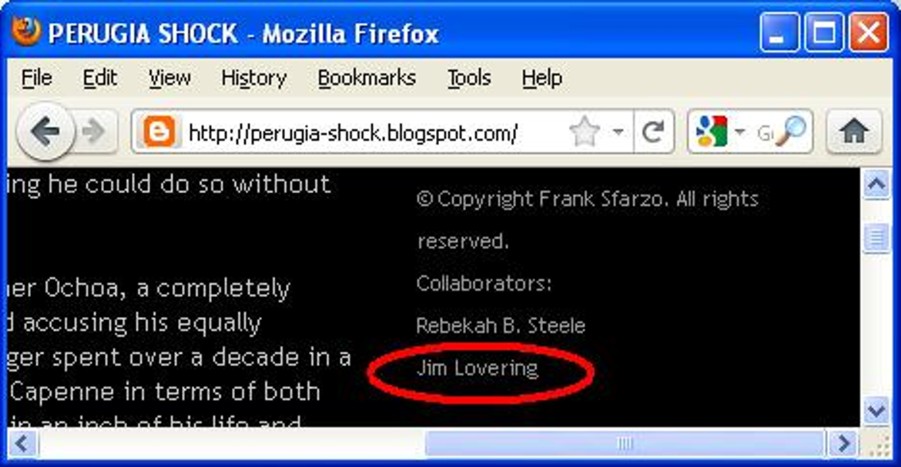
[Above: The Perugian blogger counts on Jim Lovering (also known on-line as “Charlie Wilkes”) as one of his two collaborators. Lovering is one of the most prominent figures in the “Friends of Amanda” pro-Knox activist group.]
If you do some basic Google research (“Jim Lovering” “Friends of Amanda”), you will find that Jim Lovering is the moderator of the “Friends of Amanda” website.
Here below is the Perugian blogger and Chris Mellas, presenting the Friends of Amanda website:
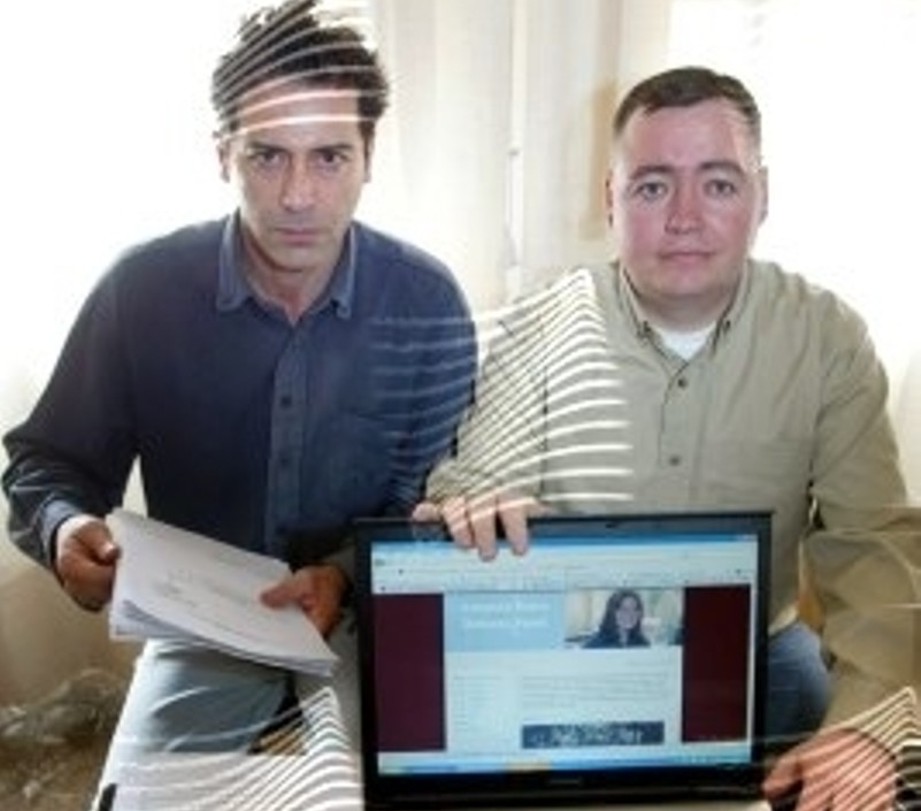
[Above: The Perugian blogger and Chris Mellas ““ Amanda Knox’s stepfather ““ presenting the Friends of Amanda website.]
Lovering/Wilkes has made himself famous in the pro and con discussion boards of this case for his anything-goes pro-Amanda stand.
This includes the manipulation with a Photoshop-type program of an image of a footprint of Rudy Gudy, found guilty together with Amanda Knox and Raffaele Sollecito of Meredith Kercher’s murder.
The manipulation adjusted the size of the Guede print taken in prison to the dimensions of a footprint made in blood found on the bathmat of the cottage where Meredith was brutally murdered (the matching of the footprints would support the “lone-wolf” theory of the Knox defence, that only Rudy was involved of the group of three young people found guilty, and therefore that Amanda should go free).
A simple gauging of the size of the print seems to show that when Lovering/Wilkes resized it, the print ended up much smaller than what it should be.
For further information consult this presentation with the satirical title: “Mr. Marriott, I Shrank the Black Kid”. Or review the on-line discussion of the issue by Googling: Rudy Guede “hobbit foot”.
Although the Friends of Amanda Knox group declares on its webpage that “We are not affiliated with her family”, some of its most prominent members are close friends to the Knox-Mellas family, as they themselves publish on Internet sites such as Facebook.

[Above: In this Facebook posting from September, poster “Charlie Wilkes” (Knox activist Jim Lovering) writes of his photo: “At the table are (Washington State Judge) Mike Heavey, Mark (Waterbury) and Michelle (Moore, wife of ex-FBI / ex-university security man / screenwriter Steve Moore). Chris (Mellas) is seated at the table in the background. I’m not sure who he is talking to. Christina Hagge and Edda (Mellas ““ Amanda’s mother) are standing on the right “¦. It was a very enjoyable gathering”. (Photo credit: Facebook ““ Perugiamurderfile.org)]
Judge Michael Heavey of the Superior Court of the State of Washington is a neighbour of the Knox-Mellases and has been involved with lobbying efforts for the family from early on (he now seems to not be a formal activist of FOA, although informally ““ as we see in this photo ““ he continues to support the cause).
In August of 2008, he wrote a letter to the Italian judicial council that regulates the activity of the country’s judiciary, decrying:
“”¦.On June 16, 2008, Judge Giuliano Mignini, The Public Minister of Perugia, closed his investigation concerning the horrific murder of Meredith Kercher.
“¦. Since November 6, 2007, the conduct of the prosecutor, police and prison employees has been to supply false information to the press to inflame public opinion against Amanda Knox, Rafaele Sollecito and Patrick Lumumba.
“¦. the prosecutor’s office (Kermit: ie. Mignini’s), police and prison employees have made illegal and false statements to the press.
“¦. Amanda Knox’s lawyers have no knowledge of my request to the distinguished and honorable members of the Consiglio Superiore della Magistratura.”
The English text and Italian original were published for a number of weeks in 2008 on Seattle celebrity lawyer Anne Bremner’s webpage. Bremner is another original member of the Friends of Amanda group. Source: this webpage which has since been redesigned)
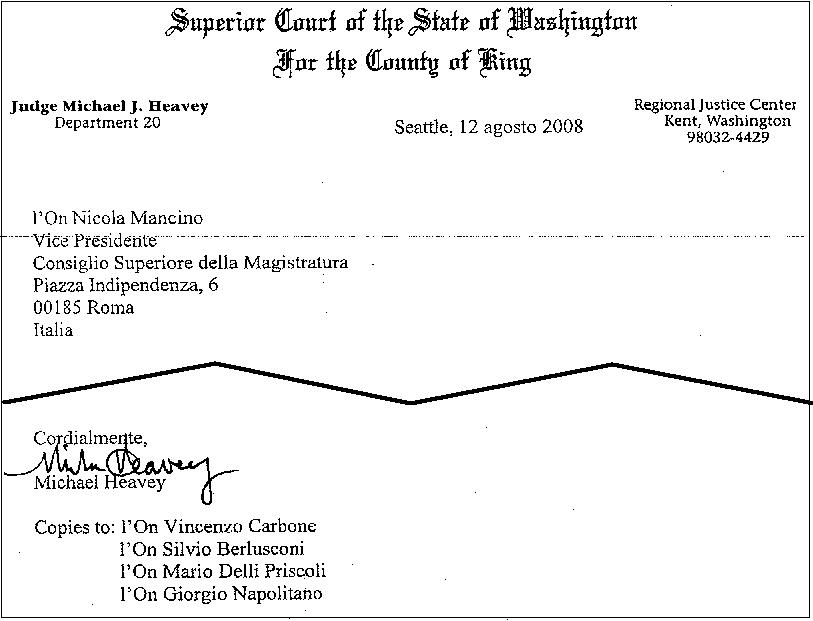
[Above: Heavey wrote a neither substantiated nor proven extra-judicial opinion of grave illegalities he ascribed to the investigators of the murder of Meredith Kercher, naming specifically the prosecutor, Giuliano Mignini. His opinion was sent to Nicola Mancino, vice-president of the Italian Judicial Council, and four other persons, including Italian President Giorgio Napolitano and Prime Minister Berlusconi.]
This unofficial, private lobbying done on Washington State Superior Court stationery didn’t go over well, as you can imagine, with the Washington State Commission on Judicial Conduct, which proceeded to charge Heavey:
“[Mr. Heavey is charged with] violating Canons 1, 2(A)and 2(B) of the Code of Judicial Conduct by writing letters on official court stationary to Nicola Mancino, Judge Claudia Matteini, and Giuliano Mignini (members of the Italian judicial system) on behalf of criminal defendant Amanda Knox; utilizing court staff to type those letters; and speaking publicly on several occasions about that same pending criminal case in an attempt to influence the proceeding.” (Source: Washington CJC)
The CJC’s investigation later concluded that Heavey had violated the judicial code by:
“using his status as a judge to attempt to influence a criminal proceeding in another country, thereby exploiting his judicial office for the benefit of another.
“¦. Respondent agrees he will not retaliate against any person known or suspected to have cooperated with the Commission, or otherwise associated with this matter; that he will not repeat such conduct in the future; and that he will promptly read and familiarize himself with the Code of Judicial Conduct in its entirety.”(Source: Washington CJC)
[Above: In spite of his reprimand in 2010 from the Washington State Commission on Judicial Conduct for - amongst other things - “speaking publicly” about the Amanda Knox case, it seems that Judge Michael Heavey has found a way to make this sort of activity compatible with the sentence of the Commission, and he continues to appear on her behalf (on his own time?). Recently on 4 April 2011 he appeared at Seattle University with other speakers aligned with the Amanda Knox cause to present the case for her innocence.] (Source: Youtube video uploaded by West Seattle Herald)
What is curious is Heavey stating in his letter to the Italian authorities that he was doing this without the knowledge of Amanda Knox’s Italian lawyers.
She has two heavyweights as her main lawyers: Luciano Ghirga ““ a well”“known and experienced Perugian lawyer ““ and Carlo Dalla Vedova ““ also experienced, and suggested by the American Embassy in Rome. In addition, there are all the experts in a number of areas that these two lawyers have introduced to the case as it has proceeded.
They will know what’s best for Amanda, and if she or her family have any questions about the legal strategy, then they should change the team. It’s inconceivable of persons close to her family taking extra-judicial measures to “help” her when those measures aren’t vetted first by her legal team beforehand in order to decide if it really does help or hinder the cause.
But that does seem to be the case here.
Between actions like Heavey’s and the not-stop media onslaught with programs such as the CBS 48 Hours series produced by Doug Longhini (starring Private Investigator Paul Ciolino who travelled to Perugia and tried to get a witness to the crime to open her door at night to talk to him ““ he has recently called that witness “crazy” from the safe distance of a Seattle auditorium) which questioned the correctness of the investigation, there was so much noise coming from America that Knox’s lawyer Luciano Ghirga actually had to go to prosecutor Mignini’s office and disassociate himself and Amanda’s defence from these opinion-making actions:
“There are people around the figure of Amanda who have no formal role in the student’s defence team, which is formed by myself together with my colleague Carlo Dalla Vedova. These people are not only not helping our client in the difficult judicial process in the Corte d’Assise in which we have to defend her, but on the contrary, they are harming her judicial position.”
(Source: La Nazione 3 February 2009- Alternate translation link here.)
Why in the world would anyone participate in an extrajudicial strategy of attacking a legal process, unapproved by the defendants own lawyers? The first answer that comes to my mind is that the party involved doesn’t have much faith in being successful in the legitimate legal process.
Paul Ciolino, the Private Eye who went to Perugia for Doug Longhini’s 48 Hours, recently participated in a seminar in Seattle University dedicated to Amanda Knox (co-speakers included Friends of Amanda founder Tom Wright, ex-FBI / ex-university security officer / screenwriter Steve Moore, and “¦ State of Washington Superior Court Judge Michael Heavey).
Mr Ciolino, I believe, more or less sums up the extra-judicial strategy for dealing with Amanda’s predicament by stating:
“She’s not going to come out of there because the Italians are nice guys and they’re going to admit that they made a horrible mistake and that the prosecutor yes indeed he is crazy but ... she may come out, she’ll come out in a year or two, that’s my best guess, okay, but she’s going to come out because the State Department is going to get involved, it’s going to become political.”
(Source: At 1:48:23 in the Youtube video uploaded by the West Seattle Herald)
I’m not saying that the Perugian blogger is a member of the Friends of Amanda group (which in any case doesn’t seem to be a “card-carrying” type of association “¦ it’s more a question of who wants to be publicly associated with it. Judge Heavey was “publicly” with the group until he decided to not be publicly associated with it.)
But it would be hard for the blogger to deny that he’s very, very, very close to this influence/lobby group, what with blog bed fellows such as his blog’s main collaborator Jim Lovering - the Friends of Amanda Knox website moderator - and what appears to be a personal relationship with members of the Knox-Mellas family.
I honestly believe that the Committee to Protect Journalists does fine and commendable work protecting journalists, who risk so much all around the world trying to do their work and keep people informed through a free press.
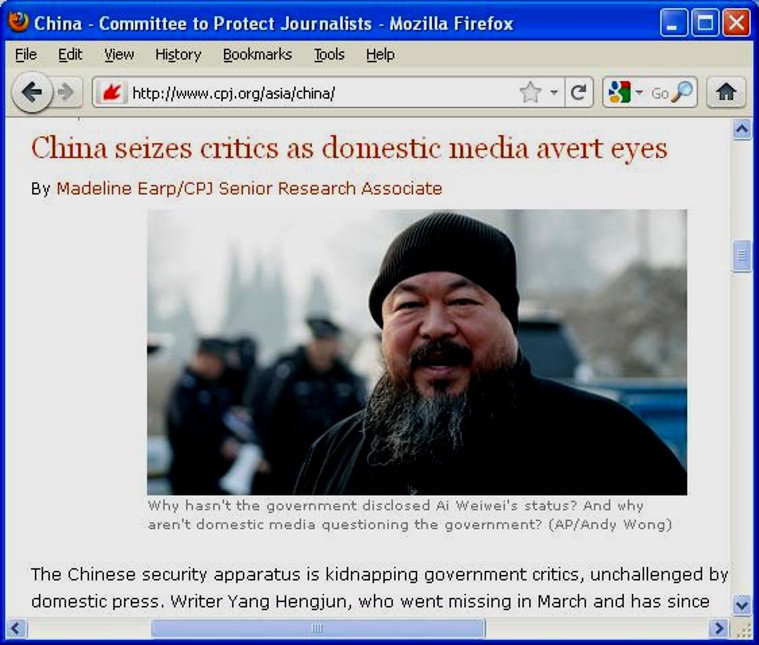
[Above: Truly threatened journalists around the world benefit from the support and awareness activities of CPJ. Bravo. (Photo credit: Committee to Protect Journalists)]
However, I encourage the CPJ to do further research concerning the news and blog personalities surrounding the Meredith Kercher murder case, and the alleged injustices they may have suffered.
Particularly worrisome for the preservation of balanced reporting by independent journalists is the hiring by the Knox family of the Gogerty Marriott public relations firm. This contract has been so successful that this PR firm uses their Amanda Knox campaign as a case study on their website.
“At Gogerty Marriott we apply campaign strategies, disciplines and tactics to public affairs problems to help our clients achieve their goals “¦. We consider every project individually and assemble a team to suit the client’s specific needs. We then develop and implement a plan; usually integrating a range of tactics such as earned and paid media, community outreach, ally development, and government relations among other ways of reaching important audiences.” (Source: Gogerty Marriott website.)
It is ever so important for the CPJ to protect journalists around the world who are struggling in dangerous situations to maintain their independent voice and to promote free press.
However, a PR campaign which uses “earned and paid media” could perhaps, be analysed further before sending alarmist communications to high-profile international authorities and potentially wasting the scarce resources of your organisation.
From the CPJ letter to the President of Italy and 20 other European and International figures:
“It is unacceptable that journalists, bloggers, and writers on both sides of the Atlantic should censor themselves by staying away from subjects of public interest such as the Meredith Kercher murder case and the Monster of Florence killings because of Prosecutor Mignini’s inability to tolerate the scrutiny that comes with public office.”
If you read the thousands or tens of thousands of articles and blogposts written on the Meredith Kercher murder case, you will quickly find that few persons censor themselves or hold back in their comments, starting off with the Perugia blogger.
Please do go to the blogger’s site. Compare it to this True Justice for Meredith Kercher site, which has a different, victim oriented focus, or to any other of the many sites, and newspaper articles which have been dedicated to this case.
Each one has its angle which it has freely developed. You’ll see that the only censoring carried out is the prudent censoring of unsubstantiated libelous claims which once in a while must be done to guarantee the ongoing unhindered success of the sites.
A study of the Perugian blogger’s posts and his own comments (in addition to the people who comment on his site) doesn’t lend credence to the belief that his voice has been somehow repressed or threatened.
Let me wind up with the words of Andrea Vogt, an objective, bilingual reporter who has been providing great coverage on the Meredith Kercher case, writing about both things positive and negative for Amanda Knox:
“In real life, prosecutor Giuliano Mignini is not at all as he’s been portrayed in the mainstream American media. He’s been vilified as a conspiracy theorist out to get anyone who dares criticize him. I’ve done it (in print and in person) and he’s been professional and dignified, even when he heartily disagreed.”
(Source: the New York Post.)
You can not imagine the abuse received by that reporter (and other valiant journalists who dare have an open opinion on the Knox-Sollecito-Guede trials) from certain pro-Knox sectors of the online world. In a separate story, this same reporter provides us with insight concerning threats pervading the discussion of this case:
“Police are investigating complaints from a Seattle woman who says she was intimidated and threatened online because of comments she made about the Amanda Knox case.
The unredacted Seattle Police Department report, obtained by seattlepi.com, names a primary suspect and quotes the woman as saying that that the suspect “˜is engaging in tactics meant to intimidate,’ along with “˜the tacit consent’ of Knox’s stepfather, Chris Mellas.
“¦. Perugia Shock is hosted on a California server and financed by an American firm, according to the Perugia-based blogger who covers the case and operates the site under the alias “˜Frank Sfarzo.’While fans say his blog poses alternative theories rarely discussed in the mainstream media, critics say his minimalist moderation results in an out-of-control comment section where posters “out” those who wish to remain anonymous, track their ISP addresses to reveal their physical locations, pose as people they are not—someone posted as Meredith Kercher, the victim, once—and make threatening posts about each other, as well as about the major players in the case, including Knox, her family, journalists, lawyers and prosecutors.
“¦. A similar address, .(JavaScript must be enabled to view this email address), which is cited in the police report, was also used to send two vulgar messages to a Newsweek reporter covering the case in Perugia. The message, sent from a Blackberry device, ended with the postscript, “˜You sound like you were abused as a child.’
“¦. (True Crime blogger Steve Huff) has been particularly surprised by the network newsmagazines’ “˜pro-active efforts’ to smear the prosecutor while painting Knox as “˜some innocent pixie college girl.’ “˜There’s some larger statement afoot in that about American views and our culture of looks over authenticity, in my opinion,’ Huff said. Huff said his opinion about guilt or innocence in the case is still flexible—he can see both sides and thinks the case could go either way, but the vicious online harassment—present from the onset but particularly intense just prior to the start of the trial—prompted him to dial back his participation.
“˜It was so pervasive and distasteful to me that as a blogger and now as a journalist I’ve all but washed my hands of covering the case,’ Huff said.”
Read more on the Seattle PI website.
Now that surely is interesting. Maybe you should talk to longtime professionals like Steve Huff, and learn why the threatening environment of this case ““ specifically from the pro-Knox camp ““ made him decide not to continue covering it.
Contact independent, credentialed, widely read, knowledgeable, bilingual (English-Italian) journalists such as Andrea Vogt (Seattle Post-Intelligencer, New York Post and other publications) and Barbie Nadeau (Newsweek, The Daily Beast) who have been at most or all of the Amanda Knox trial sessions.
Read their work and you will see balance in the information provided, including both that which supports Amanda’s cause and that which is not favourable. Ask them about their take on the judicial and reporting scene in Perugia concerning this trial. Ask them about the threats or abuse they have received. Consider offering them protection if they request it (I have not contacted them on this, take it as a tip).
Beyond these two journalists in particular, you will be able to find more.
I think you will see that you will have to rectify your letter of last 19 April 2011, or at least comment that in the media circus surrounding this sad, sad case of a bright young English girl beloved by her family who was brutally murdered, there is more than meets the eye.
I will conclude by stating that:
- In spite of collaborating on his website with Jim Lovering, one of the prominent leaders of the Friends of Amanda opinion-making lobby group, the Perugia blogger isn’t necessarily a member of that group, if the group actually has formal membership. I am in no position to state that (nor deny it). However, with Lovering/Wilkes by his side on his own blog, the Perugian blogger is very, very, very close to them.
- nor is there evidence that the Perugia blogger is an element of the Gogerty Marriott pro-Knox PR campaign, a campaign which may use “tactics such as earned and paid media”.
- However, in case that the Perugian blogger is an opinion-maker, or is simply caught up in an opinion-making framework, is he still to be protected by the CPJ? Can journalists ““ if the blogger claims to be a journalist ““ be lobbyists, or associated with lobbies and still benefit from the protection of the CPJ, if they actually are threatened? Would the CPJ protect FOA leader Jim Lovering / Charlie Wilkes who helps the Perugian blogger with his posts, if Lovering/Wilkes claimed that Mignini had sent police to beat him up due to writings on the blogger’s Perugia Shock blog where Lovering/Wilkes is a collaborator?
- of the examples you gave in the CPJ text concerning the supposed threats and abuse suffered by the Perugian blogger, the blogger’s own video of the event on 28 October 2008 seems to contradict your description of several national policemen approaching him and hitting him and pushing him (in front of Meredith Kercher’s family and preserved by the cameras of the press in the media scrum?). The example of national policemen looking over his notes in the press area at the back of the courtroom doesn’t seem to jive with the physical layout of the courtroom. The example of the Perugian blogger supposedly being beat up by policemen on 28 September 2010 may have happened (or it may have happened in another manner), but there is information lacking as to why these policemen showed up at the blogger’s door and which superior of theirs in the national police sent them. I see no link to Mr. Mignini there nor have you shown any. As far as motive is concerned, Mignini closed his investigation case file on the murder of Meredith Kercher three years ago. The case is out of his hands and now is at different levels of appeals in the courts. Why would he send a goon squad after the blogger? (If anyone tells you that Mignini is an evil, satanic-obsessed, rogue prosecutor, then please tell them that they are mistaken, that role was assigned by a famous American writer years ago to an Italian policeman who the famous writer doesn’t talk about anymore.)
- the insinuations that Mr. Mignini has some sort of private police force at his beck and call don’t fit in with the procedure-based workings of the relations between the Italian judiciary and the different police forces.
I would ask you that you reopen your investigation of this matter. I would exclude contact with persons who have a financial or any other interest in Mignini being painted in a specific light. And ““ as a good journalist ““ I would seek out “the other side” of this story.
I thank you for your time and attention. Please feel free to contact me if you require any further information or if I may be of assistance as you become more familiarized with this case.
Very sincerely,
Kermit
A Main Poster on TJMK (.(JavaScript must be enabled to view this email address))
Copied to:
His Excellency Giorgio Napolitano, President of the Italian Republic
Angelino Alfano, Ministro della Giustizia
José Manuel Barroso, Presidente della Commissione Europea
Herman Van Rompuy, Presidente del Consiglio Europeo
Baroness Catherine Ashton, Vice-Presidente della Commissione Europea e Alto Rappresentante dell’EU per gli
Affari Esteri e la Politica di Sicurezza
Viviane Reding, Vice-Presidente della Commissione Europea e Commissario per Giustizia, Diritti
Fondamentali e Cittadinanza
Neelie Kroes, Vice-Presidente della Commissione Europea e Commissario per la Digital Agenda
Jerzy Buzek, Presidente del Parlamento Europeo
Heidi Hautala, Presidenza del Sottocomitato sui Diritti Umani del Parlamento Europeo
Jean-Marie Cavada, Presidenza dell’Intergruppo per i Media del Parlamento Europeo
Thomas Hammarberg, Commissario del Consiglio d’Europa per i Diritti Umani
Ferdinando Nelli Feroci, Rappresentante Permanente dell’Italia presso l’EU
Hillary Rodham Clinton, U.S. Secretary of State
Michael Posner, U.S. Assistant Secretary of State for Democracy, Human Rights, and Labor
Philip H. Gordon, U.S. Assistant Secretary, Bureau of European and Eurasian Affairs
John Kerry, Chairman of the U.S. Senate Foreign Relations Committee
Richard Lugar, Ranking Member of the U.S. Senate Foreign Relations Committee
Ileana Ros-Lehtinen, Ranking Republican Member, U.S. House Committee on Foreign Affairs
Howard L. Berman, Ranking Democratic Member, U.S. House Committee on Foreign Affairs
Giulio Terzi di Sant’Agata, Ambasciatore Italiano presso gli Stati Uniti
David Thorne, U.S. Ambassador to Italy
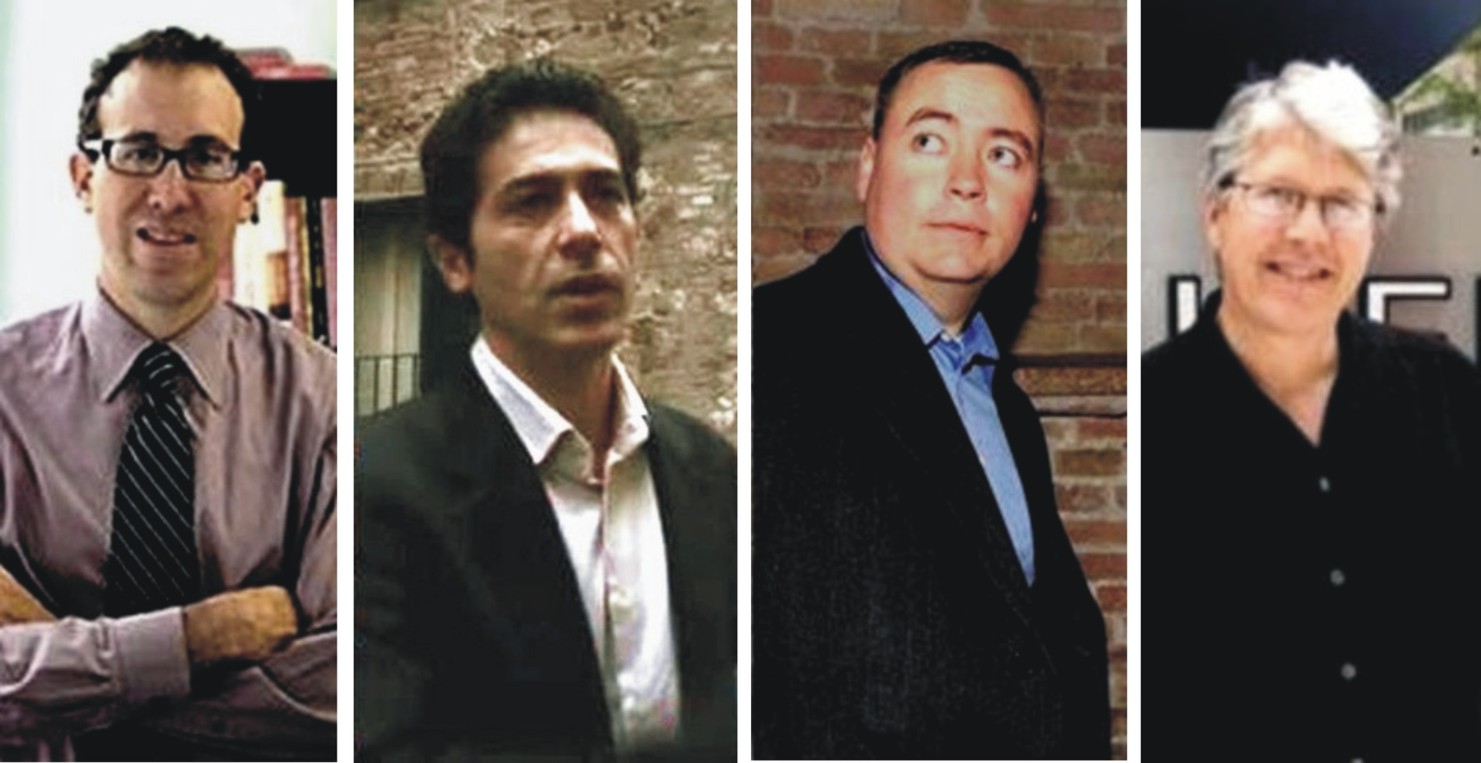
[Above: Joel Simon of the CPJ, left, with “Frank Sfarzo”, Chris Mellas, and Doug Preston]
Open Letter To Joel Simon Of CPJ: Not Even One Anti-Mignini Accusation Withstands Careful Testing
Posted by Kermit

Mr. Joel Simon
Executive Director, Committee to Protect Journalists
330 7th Avenue, 11th Floor, New York, NY 10001
Dear Mr. Simon,
More on your potentially libelous open letter, sent unchecked to 21 world leaders, and your first attempt at a response.
As previously with Open Letter #1 of April 26, this will have to occupy several posts, because the evidence against your unsubstantiated or misleading accusations against Umbrian Prosecutor Giuliano Mignini is so voluminous.
[Above: Joel Simon of the Committee to Protect Journalists is stepping into the same slippery terrain of unsubstantiated accusations against Mr. Mignini as Friends of Amanda activists such as Judge Michael Heavey have done in the past, and which Amanda Knox’s lawyers have had to disassociate themselves from. Is this just a procedural slip-up by Mr. Simon which he will quickly seek to correct, or is he consciously introducing himself and his organisation as a proxy player in a potential attempt to pervert the course of justice?]
As a public notice, your own open letter definitely has a potential impact on his reputation and career in the professional realm, and on his good name and honour as a person. No demonstrative proof was offered for those accusations. My own skepticism concerning the soundness of your accusatory text was underlined by what seemed to be the only and entire basis for this splashy letter, an aggressive international PR campaign fraught with risk for the CPJ’s reputation:
- Sfarzo told CPJ “¦
- Preston told CPJ “¦
- Cottonwood told CPJ “¦
- Editor Ken Robinson said “¦
There was no apparent fact-finding, no contrasting of opinion, no double checking, no collecting of documents. Not even evidence of the slightest, minimal effort to contact the subject of these grave accusations, Mr. Mignini (not even a “he didn’t reply to our email” or a “we tried to call his office at midnight but no one answered”).
This is shameful coming from a journalistic organisation, in an industry where every professional worth his salt checks a source before publishing to avoid credibility and legal problems further along.
My letter raised a number of questions about how and why your open letter to the world was prepared, and I made a number of requests or suggestions in order to understand better the basis for the accusations against Mignini.
Some of the red flags which result from my questions are:
- Did the CPJ simply accept the accusation of certain persons against Mr. Mignini without even minimal, Google-based fact checking?
-> If so, then Red Flag
- Having realized that basic fact checking was not carried out, has the CPJ proceeded to do so?
-> If not, then Red Flag
- Does the tipster who set you on this issue also stand to gain something by painting Mr. Mignini in a certain light?
-> If so, then Red Flag
- Is the tipster or one of the subjects of the letter a financial backer of your organisation?
-> If so, then Red Flag
- Could one or more of the subjects that the CPJ sought to protect in its missive be less a journalist seeking to report news freely, and more an element of a lobby group in an open criminal case?
-> If so, then Red Flag
- Do you know that the principal subject who you sought to “protect” in your Letter to the World is actually a screen name, used by the blogger?
-> If so, then Red Flag
- Having realized (thanks to our first reply to you here on TJMK) that you were seeking to protect a screen name, did you proceed to identify the real-life person behind the screen name, and check what provoked a police visit to his home and what he is actually charged with, and if said charges can be in any way linked to Mr. Mignini, who closed his investigation of the murder of Meredith Kercher almost three years ago?
-> If not, then Red Flag
- Upon realizing that your accusations are neither substantiated nor relevant, is it possible that the CPJ could be used as a party to pervert the course of justice in two open criminal cases?
-> If so, then Red Flag
- Have you included as justification for action in your letter to the world the supposed threat to persons who aren’t journalists or reporters?
-> If so, then Red Flag
- As a result of the CPJ Letter to 21 World Leaders, could the until now untarnished reputation of the Organization to Protect Journalists be put into question, favouring the abuse perpetrated against journalists by those in power around the world who actually do threaten the work of journalists?
-> If so, then Red Flag
With the acknowledgement that just one of these red flags (any one of them) is raised, the CPJ should have taken a step back and thought through how and why it ended up issuing its Letter to the World of 19-04-2011, identified internal control issues and external damage caused (both to the organisation’s reputation and to third parties), and taken steps to correct the cause of the red flag and ensure that it doesn’t happen again in the future.
There is negative impact that has already occurred to the Committee to Protect Journalists. However, it will continue to grow as more as more journalists, public agencies and the public in general become aware of and concerned about what is fast becoming the CPJ’s Abusive Accusations Against the Perugian Prosecutor Affair.
Instead of stepping back and reflecting on how to resolve this problem elegantly, only two days after publishing our first reply to you the CPJ posted a note, not on its front page but revealingly hidden away on the institutional blog page on its site.
Frankly, I was astounded that the CPJ seemed to sweep the questions I raised in my first letter under the CPJ’s own carpet by stating that “we stand by” the first Letter to 21 World Leaders on 19-04-2011.
Instead of trying to de-construct what it has created, the CPJ seems to be making the monster grow.
I should say that we ““ the international followers of progress in the case concerning the murder of the English student Meredith Kercher in Perugia on 1 November 2007 - recognize and are thankful that at least the CPJ did give the reply to our letter, and that comments have been open on that page. We do thank you for that.
However, to some extent, both your reply and some of the comments posted on the CPJ site actually increase our concern surrounding the CPJ’s recent actions and the obvious lack of due diligence applied in the preparation and sending of your Letter to the World. Had it occurred because of a procedural slip up, the normal reaction of an organisation such as yours would be to suspend the Letter to the World and perform detailed (or even basic) fact checking.
But you haven’t.
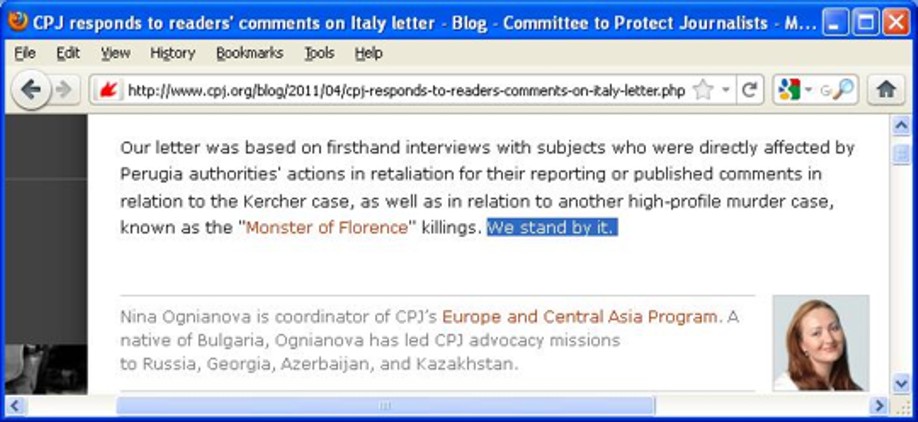
[Click above for a larger image]
[Above: CPJ coordinator Nina Ognianova takes the heat on behalf of Joel Simon, admitting that the Letter to 21 World leaders was only written on the basis of accusatory statements offered or requested of “victims” of Mignini, with no fact checking whatsoever.]
The CPJ reply to our letter states: “CPJ has received a number of emails in reaction to our April 19 letter “¦ which details cases of harassment”.
What details? Your April 19 letter didn’t detail anything.
The CPJ reply to our letter states: “CPJ takes no position as to the alleged guilt or innocence of either of the defendants in the Kercher case”
This comment has nothing to do with either your original letter or our response, and I don’t know why you have included it in your reply. We all assume a priori that the CPJ has no position on the case of the murder of Meredith Kercher. What we are concerned about is that CPJ does not provide any detail or checking to its grave accusations against Mr. Mignini.
The CPJ reply to our letter states: “Those in positions of power must understand that scrutiny and criticism, including the harshest of kind, comes with the office.”
We could not agree more with that no-brainer. What is missing in the framework of your open letter to world leaders about Mr. Mignini is what must be said in the next breath, the missing second half of that equation, which is that in addition, the Press (from individual reporters to the sectorial press associations which represent them such as yours) must act in a responsible manner, striving to publish and communicate truthful facts which have been thoroughly contrasted. To not achieve that level of responsibility means a drift towards the Press publishing news and “facts” à la Janet Cooke and Jimmy’s World.
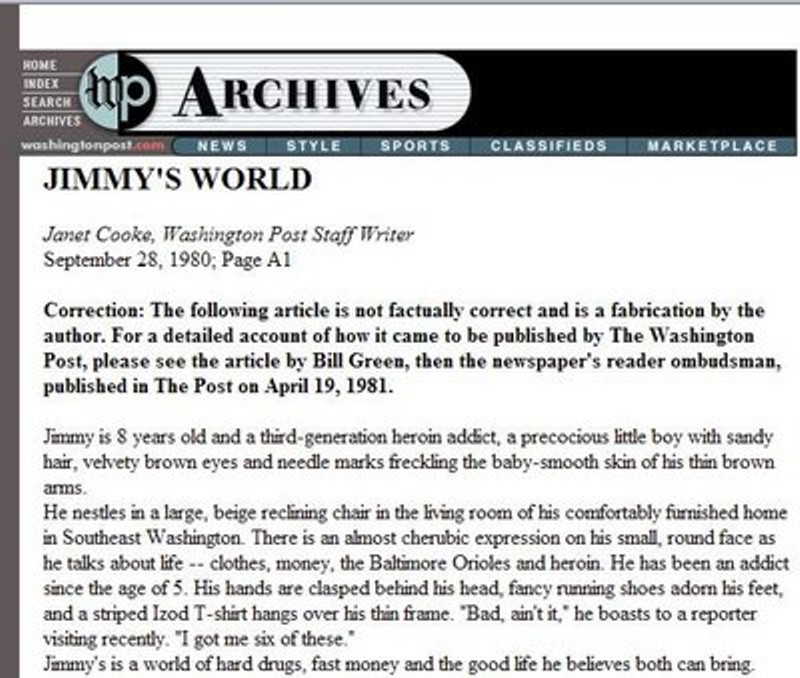
[Click above for a larger image]
[Above: Let’s hope that the CPJ can help avoid a 21st century Jimmy’s World. Does the CPJ have an Ombudsman service when regular channels of complaints provide no adequate reply?]
In my opinion (and that of many persons who have written me, and I’m sure many persons who have written you), that is exactly how the Committee to Protect Journalists is appearing.
When you say that in spite of the extremely serious issues that we raise about your document accusing Mignini “We stand by it”, you are really saying two things:
1) you continue to support the highly doubtful veracity of the unsupported accusations against Mignini
2) you are not planning to do any further checking of the facts, as effortless as that may be. (Instead of “further” checking of the facts, it’s really a question of “initial, basic” checking of the facts)
If that is what you stand by, then the overall reputation of CPJ is called into question, and those who truly should respond for the abuse of real journalists in tough situations around the world know that they can ignore your calls of support for personal freedom and freedom of press, calling into question the integrity of your organisation.
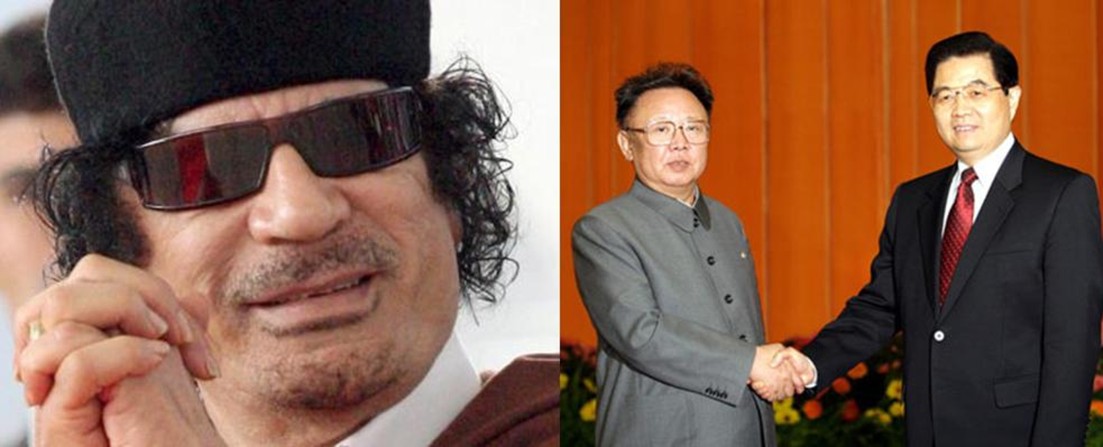
[Click above for a larger image]
[Above: World leaders on all continents who are directly responsible for the abuse of journalists and the free press in general, or who are in a position to improve the conditions of journalists have their life made easier when organizations such as the CPJ are seen as frail or lacking in the very principles that they promote.]
I can understand that from the CPJ’s point of view, you are in a tight position. Your reputation is at stake. You have published a high-profile letter containing grave accusations, which as it actually gets examined beyond the words of the accusers starts to unravel very quickly and evaporate, and by no means justifies a letter of alert to world leaders.
At the same time, the most visible of the persons who supposedly has suffered at the hands of Mignini is on the list of the CPJ’s significant financial benefactors. “Preston “¦ suffered harassment by Mignini himself in 2006 ““ and eventually was forced to leave Italy for fear of imprisonment ““ told CPJ “¦.”
And Douglas Preston is now going his own way promoting and “improving” your letter and claiming that you have carried out an “independent investigation”, when that seems to not be the case. Preston has said in the last few days:
“the Committee to Protect Journalists “¦ has made public the results of their own, independent investigation into the actions of Mignini and the police, prosecutors, and judges in Perugia, Italy.
Their conclusions are shocking. The report details what appears to be an organized campaign to harass, intimidate, and physically threaten Italian and American journalists covering the case. CPJ discovered that in at least on case police in Perugia assaulted a journalist who had criticized Mignini, trumped up charges against him, and then tried to get him certified “insane”””all with Mignini’s knowledge and cooperation.
The CPJ investigation also detailed how Perugian authorities extended their harassment campaign into the United States, threatening American journalists, writers, and newspapers with criminal charges in a gross attempt to extend Italian criminal laws on to American soil and interfere with the freedoms we enjoy in our own country.
The Committee to Protect Journalists was so concerned with their findings that yesterday they sent a strong letter of protest to the President of the Italian Republic, asking for action to end this abuse and calling on him to take steps to protect journalists in Perugia. The letter reads like a horror novel.”
(Source: Doug Preston promoting something he calls The Monster of Perugia)
Mr. Simon, I have highlighted certain expressions of Preston in bold. Is it of your opinion that this financial backer of the CPJ is using expressions and style that actually reflect the content of the CPJ letter which you signed, and how you prepared that letter? If not, what do you think explains the gap?
Could it be the close proximity of the genesis of the 19-04-2011 letter to Preston himself, to him promoting “my nonfiction book, The Monster of Florence, written with Italian journalist Mario Spezi, and currently being made into a movie” that Preston claims will star George Clooney?
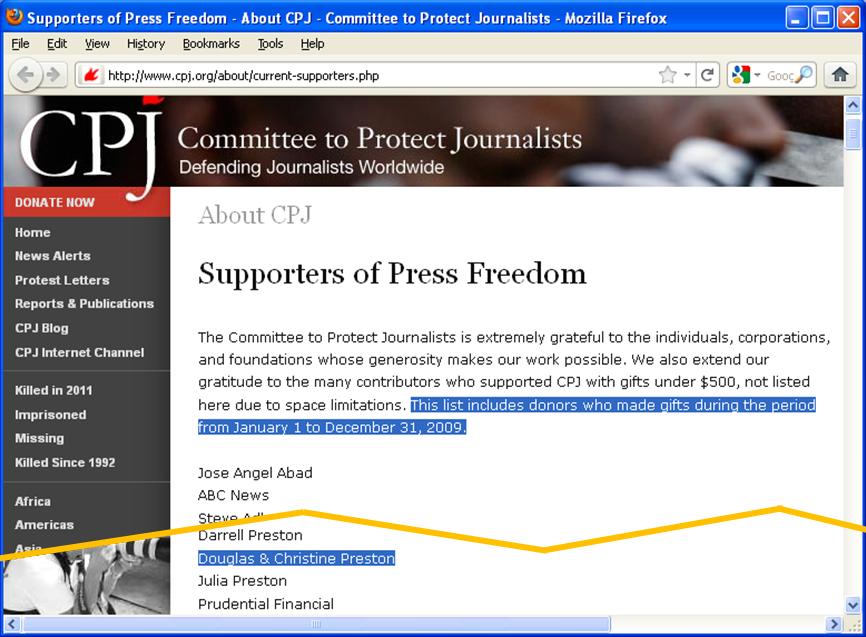
[Click above for a larger image]
[Above: In the name of transparency, it would be appropriate for the CPJ to reveal the financial contributions that Douglas Preston has made to the organisation, as well as to detail the communications and attached documents that Preston has exchanged with the CPJ with regard to the Letter to the World of 19-04-2011. This is what honest Governance is all about.]
I have received a number of emails in the last few days, as I’m sure you have too, and the message people are telling me is that something has gone amiss with the CPJ letter to 21 World Leaders about a local Italian prosecutor in the hills of Umbria.
Let me help you out.
I want CPJ to work. I am not looking for it to be humiliated, as it is a very needed organisation which has done great work. However, respect must not just be earned but it must be maintained. In the case of the CPJ letter of 19-04-2011, I honestly believe that something went wrong in the internal control procedures of the CPJ. Those should be relatively easy to review, revise and use in the future to improve the quality of your activity.
However, in addition to correcting its internal procedures with regard to the future, a wrong committed must be righted. Journalism is not about sweeping things under the carpet.
As regards the latter, it is the CPJ who should decide the action it will take. I suppose that writing a new open letter copied to 21 world leaders, admitting that the CPJ got bamboozled (which is honestly what I think happened), is expecting too much.
However, why don’t you contact Mr. Mignini’s office and give him fair time to respond on your webpage? That would be just, fair and elegant, especially after the lack of elegance shown in your world letter.
Are you even aware if he knows about the supposed incident of 28-09-2010 suffered by the Perugia blogger? My bet is that he learned about it on 19-04-2011 upon reading your letter about what a bad guy he is, and that whatever reason that the police may have gone to the home of a guy who uses the screen-name “Frank Sfarzo” (real name Sforza) has more to do with that blogger’s real-life persona than his blog posts related to the Meredith Kercher case.
Did you even know that “Frank Sfarzo” is only a screen-name? Please, please tell me that you didn’t first learn that fact only once the critical emails started to arrive after your 19-04-2011 post.
If so, that would be a serious pie-in-your-face: a letter to the world to protect a screen name against totally unsubstantiated accusations of physical abuse by police, which even if they occurred show no dotted line to a prosecutor whom some unrevealed OPJ tipster has decided to denounce (although we all have a pretty good idea of who that tipster is).
Let me help out by working to set things straight, and shed some contrasting and revealing light on the grave accusations poured on Mignini in the CPJ’s letter.
Thanks to Google, we are able to contrast the accusers’ words against .... their own words, photos and deeds as documented on Internet. These are mostly made available by themselves in their own posts and comments.
It is truly shocking that the CPJ didn’t exert the minimal effort which I present below in the Annex to this letter, and which allowed me to get a completely different understanding of how shallow the recent attack is against Mignini. To be honest, the CPJ should have seen the bamboozle coming a mile away.
If the CPJ won’t do a basic, minimal, obvious, fast, easy, needed-to-avoid-a-libel-accusation, beginner journalist’s exercise of checking the facts in a high-profile accusation with international repercussions, then I will.
Let’s do a fast “Balance” of facts as we are able to gather them. I’ve set up a Balance Sheet which we’ll use to perform some checking and tests on some of the accusations which appear in the CPJ letter. I would have performed these tests and included them in my first letter a week ago, however, I was hoping that the CPJ would have spent literally, just a few minutes to do the checking.
Here’s the format of our Balance Sheet for Testing CPJ’s Anti-Mignini Accusations. We’ll fill it out as we go along.
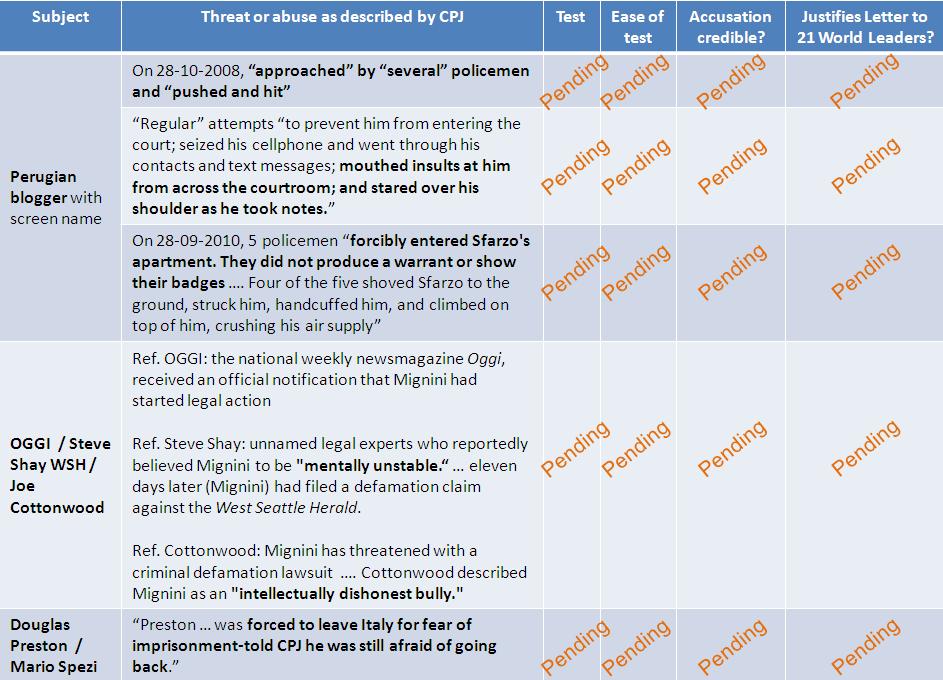
[Click above for a larger image]
Given the length of the indicative results that we have obtained, today we will post this letter, and shortly we will post the Annex with our findings with the complete Balance Sheet for Testing CPJ’s Anti-Mignini Accusations.
Please feel free to contact me if you require any further information or if I may be of assistance as you become more familiarized with the complex forces which are out to turn Mr. Mignini into an evil, rogue prosecutor.
However, what’s good for some people’s business is not good for yours.
I hope that with this second TJMK letter the CPJ will finally realize the delicate, weak state of your 19-04-2011 letter and will take the appropriate measures.
In your own words to the 21 World Leaders, “thank you for your attention to this urgent matter. We await your response.”
Sincerely,
Kermit
A Main Poster on TJMK (.(JavaScript must be enabled to view this email address))
Copied to:
His Excellency Giorgio Napolitano, President of the Italian Republic
Angelino Alfano, Ministro della Giustizia
José Manuel Barroso, Presidente della Commissione Europea
Herman Van Rompuy, Presidente del Consiglio Europeo
Baroness Catherine Ashton, Vice-Presidente della Commissione Europea e Alto Rappresentante dell’EU per gli
Affari Esteri e la Politica di Sicurezza
Viviane Reding, Vice-Presidente della Commissione Europea e Commissario per Giustizia, Diritti
Fondamentali e Cittadinanza
Neelie Kroes, Vice-Presidente della Commissione Europea e Commissario per la Digital Agenda
Jerzy Buzek, Presidente del Parlamento Europeo
Heidi Hautala, Presidenza del Sottocomitato sui Diritti Umani del Parlamento Europeo
Jean-Marie Cavada, Presidenza dell’Intergruppo per i Media del Parlamento Europeo
Thomas Hammarberg, Commissario del Consiglio d’Europa per i Diritti Umani
Ferdinando Nelli Feroci, Rappresentante Permanente dell’Italia presso l’EU
Hillary Rodham Clinton, U.S. Secretary of State
Michael Posner, U.S. Assistant Secretary of State for Democracy, Human Rights, and Labor
Philip H. Gordon, U.S. Assistant Secretary, Bureau of European and Eurasian Affairs
John Kerry, Chairman of the U.S. Senate Foreign Relations Committee
Richard Lugar, Ranking Member of the U.S. Senate Foreign Relations Committee
Ileana Ros-Lehtinen, Ranking Republican Member, U.S. House Committee on Foreign Affairs
Howard L. Berman, Ranking Democratic Member, U.S. House Committee on Foreign Affairs
Giulio Terzi di Sant’Agata, Ambasciatore Italiano presso gli Stati Uniti
David Thorne, U.S. Ambassador to Italy
Is Joel Simon Of CPJ Now In Hiding - And Pushing The Naive Nina Ognianova Out To Take The Hits?
Posted by Kermit
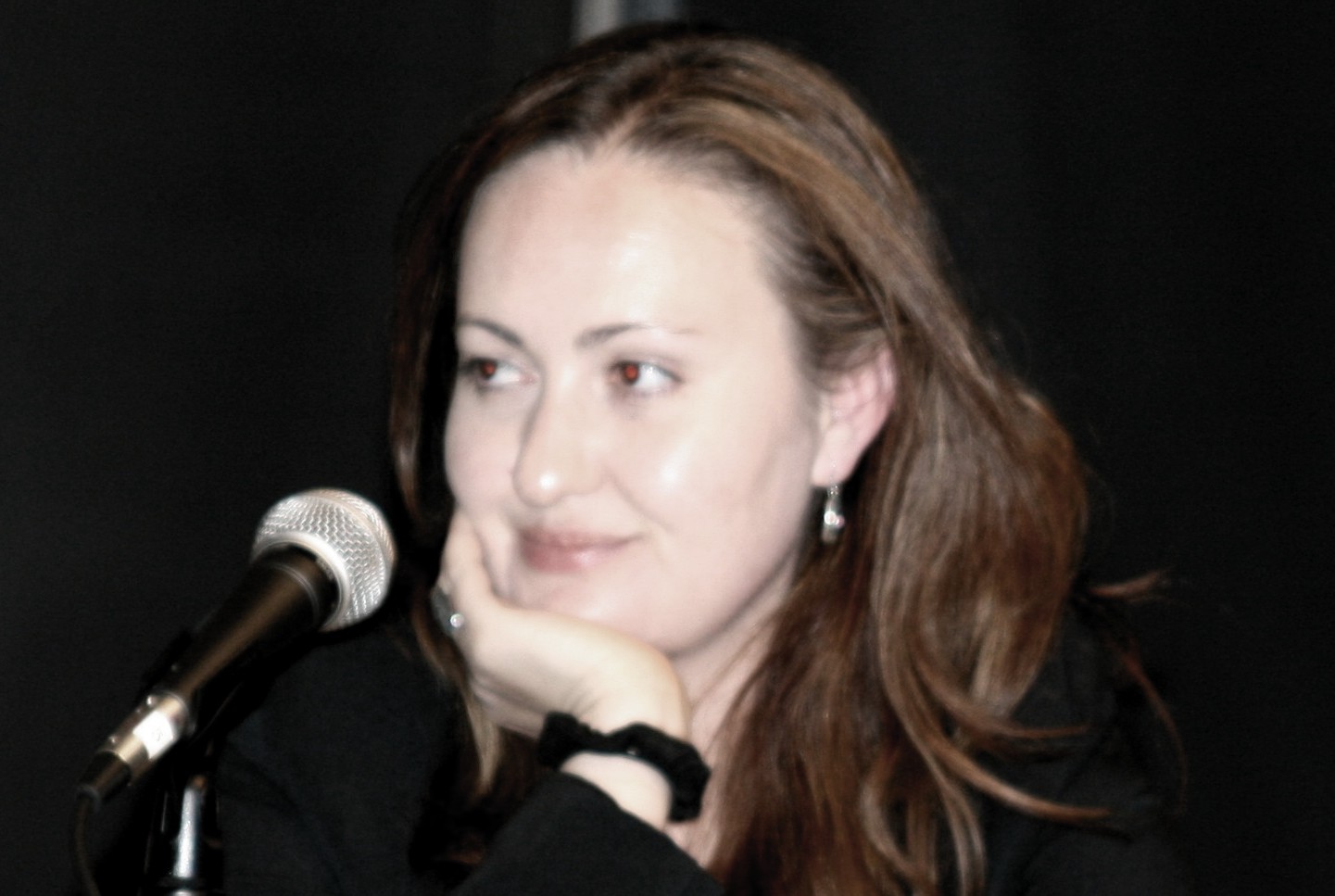
[Above: Nina Ognianova adds to CPJ’s abusive and unsubstantiated witchhunt of Giuliano Mignini]
“Frank Sfarzo” was running a low-traffic, low-impact blog which has long consisted of vague unsourced innuendo plus extensive defamation in the comments area
Every REAL reporter we have ever asked has said that in their eyes “Frank’s” site is a joke. His real name is Sforza. There are strong signs that Sforza is a paid flunky for the Knox PR campaign, and he is supported for blowing smoked and HIDING the grim and unmistakable truth.
Now, right at the mid-point between my Open Letter #2 to Joel Simon below and my posting of VOLUMINOUS evidence of his false claims to come, this misguided further attack on Miignini appears.
Unsubstantiated passages here are in bold.
New York, May 11, 2011—The Committee to Protect Journalists calls on Florence and Perugia authorities to drop the trumped-up defamation lawsuit against Perugia Shock...
Sfarzo (real name Sforza) told CPJ that he received an email from Google, which hosts the site, last night informing him that a court order has been issued for the “preventive closure” of his blog dedicated to the Kercher case.
It was from the court order, Sforza told CPJ, that he learned that Perugia Prosecutor Giuliano Mignini—who has a long-standing record of anti-press actions—has filed a lawsuit against Perugia Shock for “defamation, carried out by means of a website.”
The court order, which stemmed from Mignini’s claim, was issued on February 23 by Florentine Judge Paola Belsino. Mignini is the lead prosecutor on the Kercher case.
[ CPJ’s Nina Ognianova says] “This is hardly the first time Mignini has resorted to the law to silence his critics. It’s a heavy-handed tactic that is bound to have a chilling effect on journalists in Italy.”
CPJ has documented a history of official harassment, physical attack, and fabricated legal prosecution against Sforza.
Journalist Sabina Castelfranco of CBS in Rome (CBS is the most baised against the prosecution) has said: “Certainly it does appear that he is being vindictive, however maybe he did have a case to sue Frank Sforza for defamation.”
The MyNorthwest website describes the Perugian blogger as accusing “Mignini of having ties to drug dealers.” That is one pretty serious charge.
So. Some more hard questions for Nina Ognianova.
- On what basis can Ognianova call the charges “trumped up” if Ognianova as we suspect doesn’t even know what those charges are for? What will Ognianova say if they are genuine, serious, and provable?
- Does Ognianova understand what exactly are other charges against the Perugian blogger relating to a visit by police to his home last autumn? And what relation those other charges may have with the removal of his blog?
- Did Ognianova ever LOOK at the content of Frank’s blog and see the often-hallucinatory junk that regularly appeared there? Does Ognianova have any clue about the true state of reporting on Meredith’s case?
- Does Ognianova have any clue about the harrasment of real reporters, who have tried in face of REAL harrassment to report objectively and impartially from Italy and Seattle on the case?
- How does Ognianova associate Giuliano Mignini with the FLORENCE legal authorities? Does she know he is NOT now the lead prosecutor and is only tangentially involved with the appeal?
- Has Ognianova seen the three-month-old court order for “Frank” to take the website down? Has Ognianova seen Google’s note to “Frank” about taking his (free) blogger account down? Are they both for-real?
- Does Ognianova approve of the drug dealing accusations of this blogger who wants to be considered a freelance reporter even though his blog was simply the European outlet of the pro Amanda Knox campaign?
- Does Ognianova consider accusing Mignini of having drug dealing ties simply represent part of the free speech reporting on the Meredith Kercher case? Does she approve of the huge abuse directed at him?
- Does Ognianova know that throughout there was a co-prosecutor? Does Ognianova know that the case passed through the hands of nearly two dozen judges - and, already, the Supreme Court?
- Does Ognianova know of the rather brilliant assembly and presentation of the case by the two prosecutors? Does Ognianova know of the weak and lackluster defense component and their true desperation right now?
And where is the oversight over Simon’s and Ognianova’s runaway train here, by the (All-American) Board of Directors of the CPJ?
CPJ Talks As If Franks Blog Had A Core Audience Of Millions, While It Was Really One Or Two Dozen
Posted by Peter Quennell
This may be the REAL shock of Perugia Shock: most of its tiny core readership could probably fit in a Volkswagen bug.
The muddled Committee to Protect Journalists has been making out like Frank’s blog is a really, really, really big deal. Tens of thousands of Italians, Americans and Brits all hanging on his every mighty word.
Think again CPJ. For three years Perugia Shock had been a steadily failing blog. In early 2009 after Frank had abandoned the real victim, Meredith, and began to slobber eerily over Amanda Knox, his readership really began to plummet. Here is our report from May 2009.
According to the webtracker Alexa, readers have been departing Perugia-Shock in droves. Just a couple of months ago, Perugia-Shock was about the 4 millionth site in readership in the world….
It has since dropped an astounding 1.5 million places, and its three month average is now 5,492,938 in the world. (For comparison, TJMK’s three-month average is 1,953,715 place - and TJMK is less than half as old.)
Many vanity websites run by school-kids in the evenings see bigger numbers than Perugia-Shock. Many bloggers simply give up and go quiet when their numbers become so abysmally bad.
After that TJMK and PMF both broke into the top 100,000 (something the Knox cult sites have never come close to) while Frank’s blog dropped even further, to below 6 and 7 and even 8 millionth in readership in the world.
It has very rarely broken above 5 million since. Just a couple of months ago, way down below 5 millionth in readership is where it still was.
Now Perugia Shock is back in the top million. (TJMK today is at 421,738.) Gee thanks Committee for the Protection of Journalists. Just another example of the way you have been used.
CPJ Accusation #1 Against Italian Justice Officials : Was The Anon Blogger Pushed And Threatened?
Posted by Kermit
Overview. In our Second Open Letter to Joel Simon and world leaders we noted that NOT ONE of the accusations against Italian officials on close examination stands up. This is Attachment One to that letter. Click on the image above to see all the tests we carried out. More investigative posts are to come.
CPJ Accusation #1: In CPJ’s Open Letter To The President of Italy Joel Simon writes about a Perugian blogger who uses the screen name “Frank Sfarzo” (real name Sforza, presumably CPJ didnt bother to check his real name). His claimed troubles started on October 28, 2008, the day Knox and Sollecito were indicted and a third defendant was convicted of murdering Kercher. Several members of Squadra Mobile, Sforza told CPJ, approached him just outside the city court (Corte di Assise di Perugia) and started to push and hit him. “You are pissing us off!” they told him, referring to his coverage.)
Opening observation: If Frank Sforza was in October 2008 on the cops’ radar we would be incredibly surprised. His blog had run for only a few months, it was low- volume and objective, it was in English, and it was pro Meredith and pro prosecutors and cops at this time. WHY would cops be “pissed off”??? Zero reason we can see, based simply on what appeared on his blog. Okay, let’s continue on to the supposed evidence of his claim.
Line of Investigation for Test 1: In our first open letter to Joel Simon we already included the Perugian blogger’s own video of this alleged aggression. (His site is now temporarily taken down but we have the video.)
Since the alleged aggression occurred in the middle of a media scrum, I suggested in my prior letter that you study video sequences of other news organizations present to see if anyone had it in for the blogger (which is the essence of your accusation).
Based only on that video, most viewers would seriously doubt ““ no, directly throw out ““ the accusation that CPJ makes. You do not see “several” policemen approach him and “push and hit him”. However, you still don’t seem to have studied the video so here goes.
Test 1, Step 1: Google for video: 29 Oct 2008 “rudy guede” (enter)
This Google search made sense, since the aggression supposedly occurred when the Kercher family was exiting the courthouse in late October 2008 after Rudy Guede was sentenced for the murder of their daughter and sister Meredith. In October of 2008, the Perugian blogger had barely just switched sides from being pro-victim, to joining the pro-Amanda lobbying group.
In the sake of honesty and transparency (something that seems to be lacking from some media organizations these days) I should say that I repeated this test twice. The first time I googled for videos dated “28 Oct 2008” (the date of Guede’s sentencing), however, since it occurred well into the evening, most of the news videos are dated the next day.
Approximate time required to obtain material to be analysed: less than 1 second.
Analysis:
There are a number of videos which result from the Google search. I latched onto one from The Guardian.
The sequence which is of interest in The Guardian’s video goes from the 00:55 second mark to 1:11. You’ll need eagle eyes for this, but look out!!! Just a fraction of a second before the video cuts to the Kercher family’s news conference, we too are witnesses to the Perugian blogger suffering his aggression “¦ centimeters from Stephanie Kercher’s face!!!
Now if the Italian cops were the ones doing the beating up, you’ll have to admit that’s pretty cheeky of them, in front of the murder victim sister’s nose, under the blaring light of dozens of television cameras.
[Above: If it’s true that Mignini is responsible for this aggression, all I can say is that his hit squad is made up of undetectable aces. Closer scrutiny shows that Stephanie Kercher seems to be putting her hand up to protect herself, not from Mignini’s goon squad, but from the crush of reporters, with the blogger right there in her face.]
Now I can imagine that there will be persons out there who will need to believe that what appears to be jostling and media scrum etiquette is actually a planned conspiracy by Mignini, his private Italian national police force goon squad, and a series of judges who are complices to the abuse.
So, let’s do a more detailed review of the abundant information at hand. In fact, before we look more closely at the Perugian blogger’s aggression, let’s just watch The Guardian video a couple of times in order to get a feeling for those 16 seconds of movement. This is very important to understand the event.
At the beginning of the sequence, you only see the door of the courthouse which the Kercher family has exited in the first second. There are four or five plainclothes policemen or guards who escort the family as they approach the media crowd. They plunge into the media, which moves along with them a little. However, at the core of the crowd, the Kercher family and their escorts progressively move past each photographer and cameraman.
This is, I imagine, the exact same process as any courtroom departure covered by the Press, yet it is an important consideration in this test: for as much as individual members of the media try to advance along with the Kerchers, the Kerchers and their escorts press forward and “overtake” each member of the media.
The only people who don’t change position in a relative manner to one another are the members of the press: the colleagues that each reporter or cameraman has at his elbows change very little their position amongst each other (even if the whole body of the Press is shuffling along as they try to follow the Kerchers). One exception to that relativity we’ll see later, is the Perugian blogger.
Okay, now that we’ve seen The Guardian video a couple of times, we have a feeling for the setting and the non-stop movement of the Kerchers and their escorts. Let’s look at the “aggression”. As we said, it occurs just at the end of this sequence, at 1:10 and 1:11, right before The Guardian’s video cuts to the Kerchers’ press conference (in the following frames from the video, I’ve removed the irrelevant left and lower parts of the frames in order to enlarge and concentrate on “the aggression”)

Above image: Between the 1:10 and 1:11 marks of The Guardian video, we see the Perugian blogger appear (that’s the last second of the courthouse exit sequence). It’s not too clear in this frame, but if you have seen the video, you can see clearly that he has a couple of fixed or video newsmedia cameras just behind and to the right of him.
In that first frame, there is not yet any evidence of violence, he is slightly crouched (as evidenced also by the angle of his own video images which we will look at in a minute). I believe that is Stephanie Kercher’s right hand that is outstretched ““ in this frame it appears that it could be a left hand, however that doubt is removed in the next frames:
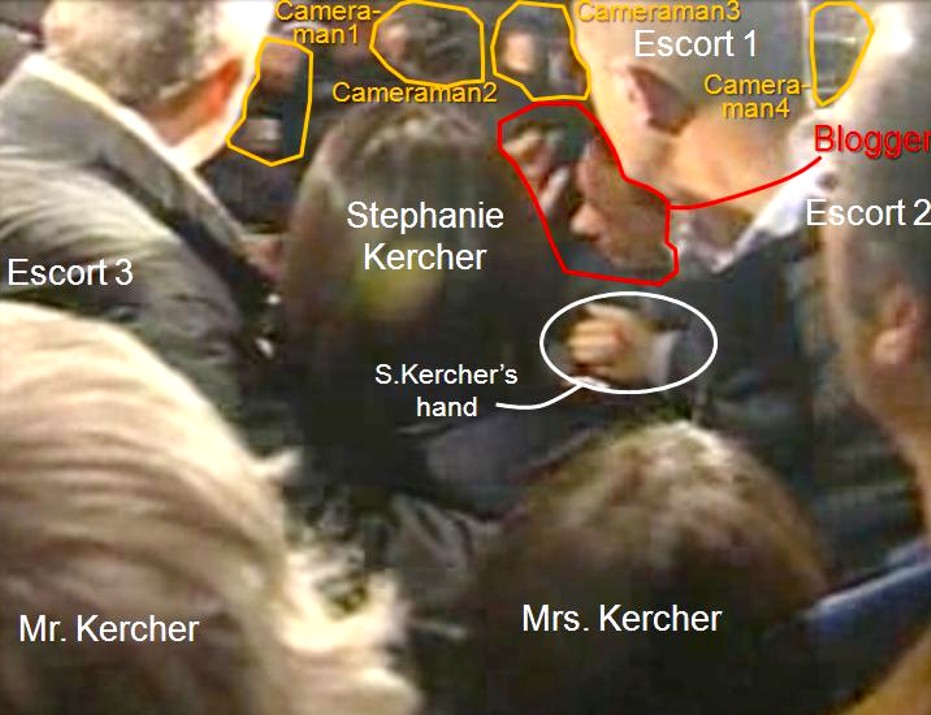
Above image: “The Aggression” has occurred! We don’t see exactly what provokes the Perugian blogger’s reaction, but he raises his right hand to his head. His hand is empty, so this is quite likely just at the moment when in the blogger’s own digital camera (or cellphone) drops, or hangs and dangles. Clearly, he is not filming his short digital video.
One suspect in “The Aggression” is the escort to the right of Stephanie Kercher (indicated as Escort 1 in my marked up image). The escort’s unseen right hand, right arm or right shoulder quite likely makes physical contact with the Perugian blogger ““ while the CPJ may believe that this contact was executed under the devious instructions of Mr. Mignini, I find a much more plausible explanation in that this escort was simply making way for the Kerchers.
Now, those who are fans of gymnastics may believe that said escort somehow wrapped his right arm around the Perugian blogger’s head and tapped / slapped / hit him there on the right side, although it doesn’t make sense that a person on the left side of someone hits that someone on the right side of their head.
Quite likely the best explanation is that someone or something to the right and behind the Perugian blogger hit him. We see emerging in this frame a total of four photographers or cameramen.
It’s entirely possible that the Perugian blogger got in the way of one of those members of the media, and that either he backed into them and their equipment (hitting his head), or that the advancing group of the Kerchers and their escorts pushed the blogger into the photographers and cameramen and their equipment, or that a cameraman got irate with the blogger for buzzing about and getting in the way and slapped him on the head.
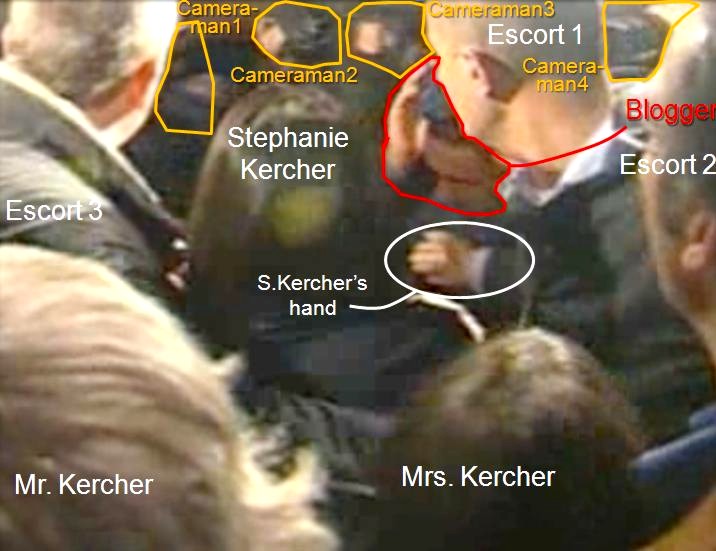
Above image: This is the marked up version of the first image we saw. It is just before The Guardian’s video cuts to the Kercher press conference. We see better the emerging cameras 3 and 4. What appears to be Stephanie Kercher’s right hand could actually now be touching the Perugian blogger (I hope that by trying to protect herself that the CPJ doesn’t call her an accessory to “The Aggression” and issue another accusatory Letter to the World!).
There’s a possibility that what I’m calling Stephanie Kercher’s right hand could be the right hand of her escort, although I think not, as it is at an unnatural angle for him. In addition, if you compare the size of her hand to the Perugian blogger’s hand, it seems more appropriate to assign it to her (it is true that women’s hands are smaller than men’s, and that relation is definitely what we see in this frame).
We’re not finished yet with “The Aggression” at the courthouse. However, just on the basis of what we’ve seen, does it seem like Mr. Mignini has directed “several members of Squadra Mobile” to approach the Perugian blogger and start “to push and hit him”?
Please, please Mr. Simon, don’t tell me that the CPJ still doesn’t have it clear, that you’re still thinking about it, that you’re not yet ready to withdraw your accusation against Mr. Mignini on this one ““ for the moment I’m only talking about this first example you gave of Mignini’s aggressions which justify for you sending a letter to 21 World Leaders.
[Above: The three video frames analysed from The Guardian video, with no markup or overlays. Click on each image if you want to see a larger version]
I mentioned that last night the Perugian blogger’s website was removed by Google’s Blogger service. However, trust me in the data I provide below on his video. If you would like to see the rest of the video, or consult alternative frames, do contact me.
Just for the record, the video used to be available at this link Here’s his own version of “The Aggression” outside the courthouse:
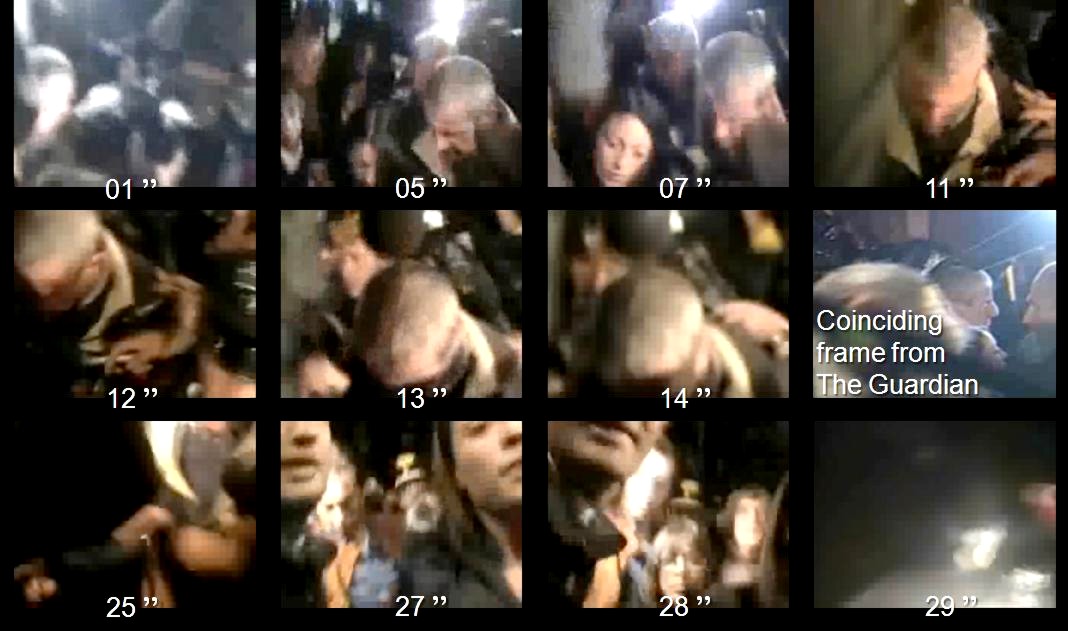
[Above: Although the CPJ has started to call the Perugian blogger a “local freelance reporter”, the quality of his video makes one repeat the question if he is anything more than the blogspot blogger that he is (er, used to be), allied through collaborator Jim Lovering with the Friends of Amanda lobby.]
Given the low resolution and the non-stop jumping in the blogger’s 36 second video, I’ve only extracted a handful of frames, which I won’t enlarge any more, otherwise they become pixellated and unviewable.
At 01”, you can just barely see the courthouse door in the background. In the foreground you can see the backs and equipment of the members of the press who are filming the Kercher family. The Kerchers and their escorts are not yet defined, given the low quality of the video, however, the brightness of the camera lights and flash bulbs situates them in the medium distance. In other words, they are some distance still from the Perugian blogger.
At 05” and 07”, the mass formed by the Kerchers and their escorts moves forward, getting closer to the Perugian blogger, however, he is still separated from them, as seen by heads and media equipment that continues to appear between them and him.
In the whole video you can hear noise, people complaining, other people asking to please make way, there is a lot of commotion. At 09” when listening to the video you can hear a swear word in Italian.
At 11” and 12” there is still at least one line of members of the press between the Perugian blogger and the Kerchers / escorts as they advance inexorably through the media scrum. In 11” you see someone and a dark shape (television video camera?) on the left, in 12” you see hands of reporters with microphones in front of Stephanie Kercher’s escort.
At 13” and 14” this same escort (Escort 3 in my marked up Guardian video, on Stephanie Kercher’s left) gets hit on the head or seems to almost get hit on the head by a boom mike (I include a frame from The Guardian video of this moment). The boom mike is connected to a camera or some over equipment to the left of the blogger, and this gets in his way.
The core group of the Kerchers and their escorts continues forwards. From 14” to 25”, the Perugian blogger seems to squirrel around, looking for a better position. He is changing his relative positioning to the other cameramen and reporters near him.
The cameraman (I assume he’s a cameraman) with the boom mike to his left keeps getting in front of the blogger, and the blogger can’t get a good shot. Up until now, the blogger has been taking his video from on high (holding his digital camera / cellphone above his head, and filming the foreheads and the tops of the heads of the Kerchers and their escorts.
Then he gets an idea. He burrows low and moves left behind the cumbersome cameraman with the boom mike, abandoning his attempt to position himself in front of Escort 3.
In 27”, he pops out of the dark mass of cameramen’s backs, just below Escort 1’s chin, looking up now at Stephanie from further to her right (you see his video is now from below, looking up, instead of aiming his camera from above on the right as he had done before).
A budding freelance reporter’s dream scoop: Right in front of Stephanie! Eye to eye! (Well, better said, eye-to-her chin.)
His exclusive images didn’t last for long. About two seconds to be exact.
At 29” the Perugia blogger’s camera shows the night sky, the ground, and the crowd. Did the escort and Stephanie plow into him? Probably.
Did he also hit his head on one of the cameras / boom mikes / other media equipment he had ducked under (because he got plowed into, or because he backed into the members of the media) and that were slightly behind and above him? Maybe.
Did a member of the media whose images or sound the blogger had been messing up get mad and slap him? Maybe.
Did a policeman unseen on the videos hit him? I doubt it, but maybe.
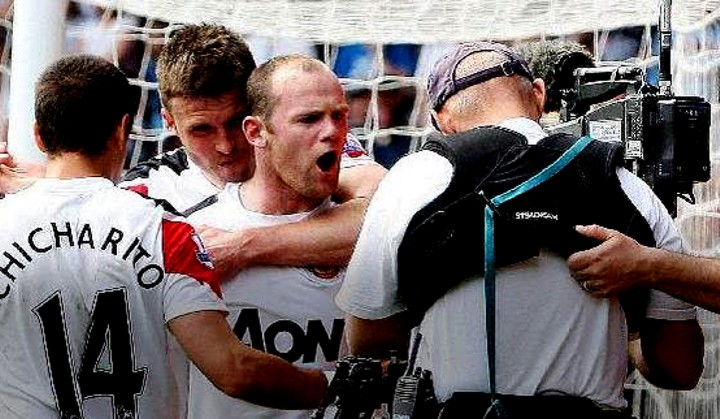
[Above: Television cameras, along with pitted olives, can be dangerous weapons, and provoke grievous international tensions, including hitting sportsmen on their heads with bulky cameras and their boom mikes. In a case of aggression like in Perugia, it’s almost better to set up Mignini as the fall guy, rather than a wealthy television broadcasting network.]
From 29” to 36” in his video we hear complaints and comments to the end of the tape when there is some comment about “The last 3 days “¦”.
Remember what we observed in The Guardian video? That the core group of the Kerchers and escorts was moving along, not stopping. By the time we get to the end of the blogger’s video, the Kerchers and their escorts will have been long gone.
At the very end of the video, in the commotion and exchange of angry comments ending with “The last 3 days “¦ ” , the voices aren’t separating, one or the other isn’t walking away. However, the seven seconds from 29” when the Perugian blogger bumps his head / gets his head bumped to the 36” mark are one fifth of the total video, which takes the Kerchers from the doors of the courthouse to well beyond the Perugian blogger.
I doubt that one of the police escorts stopped and waited until the crowd had cleared to insult the blogger. I also doubt that after bumping his head, “several members of Squadra Mobile “¦ approached him” and that that’s when the vicious attack mandated by Mr. Mignini started.
Who made that possibly insulting comment about “The last 3 days “¦”? An escort or other security official? A member of the media elbowing with this budding wants-to-be-a-freelance-reporter-but-is-still-a-blogger, and who was ticked off that the blogger hadn’t yet learned media scrum etiquette and that you simply can’t stand up in front of someone’s big fat camera lens (especially if you have an eensy-teeny weenie one, maybe only cellphone)?
Can this disparaging remark and elbowing be linked to a vengeance driven Mignini (vengeance for what? Some broken English comments on a blogspot page?) and his campaign to harass reporters? I doubt it.
Do either of these videos show the imagery that is explicitly described and further insinuated by the CPJ in its Letter to the World, namely that “several members of Squadra Mobile “¦ approached him just outside the city court “¦ and started to push and hit him.” ?
(Source: CPJ’s Letter to the World 19-04-2011)
[Above: For the moment, Joel Simon of the CPJ has not yet backed down from his description of the terrible incident that he feels the Perugian blogger suffered outside the local courthouse. I guess he’s still waiting on evidence that it didn’t happen.]
If the CPJ is going to continue to justify in the light of these two videos that a squad of goons directed by Mignini “pushed and hit” the Perugian blogger, and turn it into an event which should be informed to 21 World Leaders, well, I honestly think you’ve got it wrong.
Excuse the length of text I’m dedicating to this one test. I don’t want to be pedantic with my frame-by-frame analysis, but I did want to be thorough, just so that there is no doubt about what happened (or, better said, didn’t happen) outside the Perugia Courthouse on 28-10-2008.
Test 1, Step 2: Conclusion
I think that simply by watching the two videos once, even without the frame by frame analysis, it is more than evident that what you have stated in your letter of 19-04-2011 bears no relation to the Truth whatsoever.
Having finished the first test, let’s take a look at how things stand on our Balance Sheet for Testing CPJ’s Anti-Mignini Accusations:

Above: The first test of credibility in the anti-Mignini accusations was pretty easy to do, and it’s one of the hardest ones!
CPJ Accusation #2 Against Italian Justice Officials : Did Court Officials Hassle The Anon Blogger?
Posted by Kermit
Overview. In our Second Open Letter to Joel Simon and world leaders we noted that NOT ONE of the accusations against Italian officials on close examination stands up. This is Attachment Two to that letter. More investigative posts are to come.
CPJ Accusation #2: The CPJ letter makes a second accusation against Mr. Mignini concerning supposed (yet unsubstantiated) abuse that Mr. Mignini has organized against this blogger: “When the trial of Knox and Sollecito began that December, Squadra Mobile continued to harass him. They regularly tried to prevent him from entering the court; seized his cellphone and went through his contacts and text messages; mouthed insults at him from across the courtroom; and stared over his shoulder as he took notes. “This was done in the presence of the judge, the Carabinieri [the military police], and the court guards, but they would do nothing,” Sfarzo (real name Sforza) told CPJ.” (Source: CPJ’s Letter to the World 19-04-2011)
Line of Investigation for Test 2: For many of these cases of supposed abuse and threats, the best source for contrasting the grave accusations which the CPJ heaps rather flippantly on Mr. Mr. Mignini, are the words and images that the supposed victims themselves post on Internet.
The Perugian blogger didn’t take photos or video of the entrance controls to the courthouse. I can imagine that in this day and age of terrorism and security controls, it would have been normal for the guards to have asked the blogger’s purpose in entering the courthouse, and if he said he was a member of the press (promoted to “local freelance reporter” by the CPJ), it would have been normal for them to expect him to produce a press pass, accreditation, media business card, or any other professional identification.
And if he didn’t have press identification and if he wasn’t a member of the families of the defendants, or there as a guest of the Kerchers or the prosecution, I can imagine that he would have had some difficulty initially getting access to the courtroom.
Anyway, let’s assume that the credibility of the first part of this accusation (being hassled when entering the courthouse) has the same level of credibility of the second half of this accusation (being insulted and spied on within the courtroom).
If you agree, let’s first of all take a fast look at the general news agency photos of the courtroom which you saw in my first letter a couple of weeks ago. The test will be to contrast those photos with the blogger’s own photos from court sessions, in order to understand the possibility that such harassment occurred.
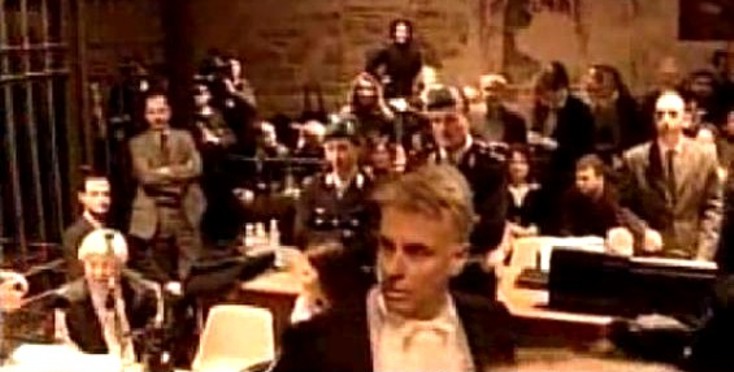
[At top and above: The Perugian courtroom where Amanda Knox and Raffaele Sollecito were tried, and where the CPJ claims that the Perugian blogger was yet a further victim of this trial.]
To the right of the upper photo, and at the back of the lower photo is the press pen, where members of the press are crammed in and must remain between a railing and a back wall.
In front of the press pen railing are the defendants’ family members and other authorized parties.
In front of family members, guards separate the defendants and their legal teams from their families. (To the left of the legal defence teams are the prosecution and private plaintiffs.)
Opposite the prosecution and defence legal teams, facing them at the front, are the judge and the members of the judicial jury.
Test 2, Step 1: Google: site:blogspot.com perugia shock court (enter)
(Please note that even though the Perugian blogger’s site has been removed, you can still get photos and text through Google caches.)
Approximate time required to obtain material to be analysed: less than 1 second
Analysis:
The pro-Amanda Knox lobbyist blogger’s blogspot lobby pages (or, if you prefer, the “local freelance reporter’s” news publishing page) are chock full of photos in the court sessions of the trial of Amanda Knox and Raffaele Sollecito.
Let’s make a collage of them:
[Above: A jammed pack collage of photos from the Perugian blogger’s blogspot “freelance reporting” page: http://perugia-shock.blogspot.com/ (I never knew that by having a blogspot page you became a freelance reporter. Neat.) Double click on the above image to see a larger resolution version. ]
I have indicated each individual photo with a letter. From my point of view, the Perugian blogger was where he should have been in all instances, which is behind the railing of the press pen, near the back wall of the courtroom. This is clearly the case in photos “B”, “C” and “D”, where you can actually see the railing which separates the press pen from the rest of the courtroom.
In the rest of the photos, especially when the zoom function is obviously in use, such as in photos “H”, “J” or ” K”, or simply by gauging perspective, such as in the case of photo “L”, it’s safe to say that the Perugian blogger in all cases was behind the railing of the press pen.
Let’s place on a sketch of the courtroom, the location from which the Perugian blogger took those photos in Amanda Knox court sessions he attended:
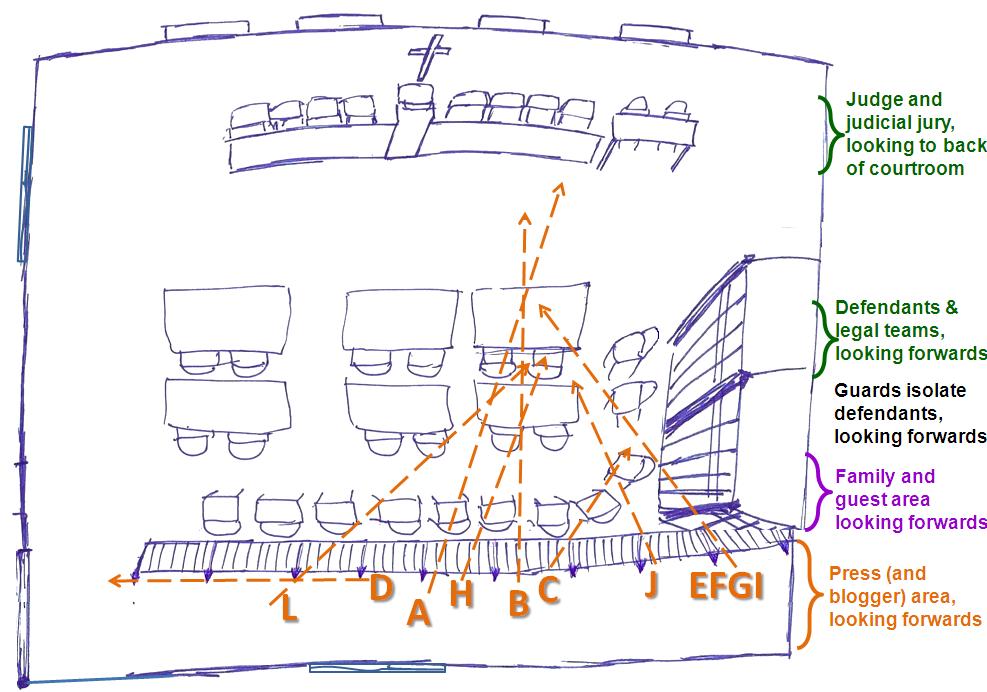
Now, if the blogger was in the press pen, any police officer who would have stepped into the crowded, fenced off area and wandered around behind the backs of the journalists, reporters, and blogger - especially making a noticeable attempt to look over shoulders - would have been noticed by the journalists in addition to the blogger who has accused Mignini of sending these spies out.
I realize that these photos may not represent all of the court sessions that the blogger attended. The possibility exists that in some other session he wasn’t in the press pen, but sitting with the Knox-Mellas family, with whom he has a personal relationship, or in some other non-press location in the courtroom.
Since the CPJ calls the Perugian blogger a freelance reporter, I would assume that the CPJ would also situate the blogger in the press pen and assume that if he wasn’t attending as a member of the press but as a friend of some defendant, then he shouldn’t be afforded the protection of the CPJ (in any case, I doubt this scenario occurred).
As for the “mouthing of insults”, in general, everybody faces forward in the courtroom, except for the judge and the members of the judicial jury. Any police officer or carabinieri agent or prison/court guard present would have been mouthing to the whole press corps plus the blogger, not just him.
[Above: As we see from this photo, everyone in the courtroom faces forwards, except the judge and the jury “¦ and the Perugian blogger (I think that’s him there on the left looking backwards). Golly, maybe he was spied on over his shoulder after all.]
It requires a Friends of Amanda Leap of Faith to imagine the alleged spying happening without anyone else detecting it, other than the blogger.
I won’t comment on the possibility that Judges Micheli, Massei or Hellman condone or are accomplices to such behavior. I honestly think that the CPJ should think twice before it spreads so much conspiracy around, on the basis of a verbal statement by a blogger whose real name the CPJ didn’t even know when they spoke to him (you did speak to him, right? Or did someone else do the phone interview on your behalf?).
If the CPJ honestly thinks that this behavior occurred, since the presiding judge has responsibility for what goes on in the courtroom, why didn’t the CPJ Letter to the World accusing Mignini not make nominal reference to the judges who pull rank over Mignini and include them in this specific accusation?
Test 2, Step 2: Conclusion
Having seen in a more detailed way the layout of the courtroom and the normal positioning of the Perugian blogger, it is difficult to imagine how he may have been spied upon by policemen looking over his shoulder.
As for the mouthing of insults, as a rule, the guards face forwards and are located in front of the family members and other invited persons. For a guard to turn towards the Perugian blogger and mouth an insult, not only the other journalists would have seen it, but also the guests and probably lawyers as well.
If any insults were mouthed at the Perugian blogger during the course of the Amanda Knox trial, or the start of the subsequent appeal, it is difficult to believe that this could have occurred with only the presiding judge (in addition, of course, to the ringleader Mignini) realizing what was going on.
It’s time to go back to the Balance Sheet for Testing CPJ’s Anti-Mignini Accusations and update it:
[Below: Click image for larger image.. The second test of credibility in the anti-Mignini accusations could only be passed if the person who formulated it took a giant Friends of Amanda Leap of Faith.]
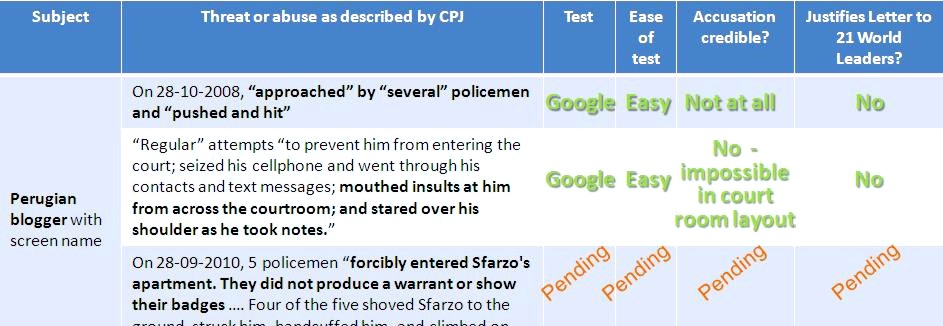
CPJ Accusation #3 Against Italian Justice Officials : Was Anon Blogger Arrested On MIGNINI’S Orders?
Posted by Kermit
Overview. In our Second Open Letter to Joel Simon and world leaders we noted that NOT ONE of the accusations against Italian officials on close examination stands up. This is Attachment Three to that letter. More investigative posts are to come.
Accusation 3: This anti-Mignini accusation is even more startling than numbers one and two. The harassment reached its peak on September 28, 2010, when five officers of Squadra Mobile forcibly entered “Sfarzo’s” apartment. They did not produce a warrant or show their badges, “Sfarzo” (real name Sforza) told CPJ. Four of the five shoved Sforza to the ground, struck him, handcuffed him, and climbed on top of him, crushing his air supply “¦ etc. etc. etc. The officers refused Sforza’s requests to call his lawyer or his relatives, and put him in a cell for the night.” (Source: CPJ Letter to 21 World Leaders )
Well, I’m still surprised that CPJ didn’t ask the Perugian blogger for his lawyer’s name, or for information about the hospital and the doctors who attended him.
I’m also surprised that CPJ didn’t ask both the blogger and the police headquarters about why the accused policemen (with or without a warrant) originally went to his home. It all sounds like a story that is extremely full of holes of information which should be filled (unless if you prefer not to fill them in).
I don’t know if the CPJ realized it, but with this accusation, the organisation has ratcheted up the grave accusations against Mignini. If up until now the anti-Mignini crowd’s accusations were limited to describing Mignini’s alleged bothersome provocations, the CPJ has now appeared on the anti-Mignini stage, and is claiming that he has opened a qualitatively higher level of menace: one of physical violence causing bodily harm. The only thing missing is for Mignini to be called a drug-dealer and a drifter.
Since the CPJ didn’t ask the blogger nor include in its Letter to the World why the police went to the blogger’s home, the CPJ’s insinuation is that Mignini’s goon squad simply went to the blogger’s home under that prosecutor’s orders, and with no justification.
I see no evidence that:
- Mignini sent anyone anywhere that day,
- the police weren’t there (if they were) on police business related to the Perugian blogger’s real-life persona,
- the altercation with the blogger (if there was one) had something to do with Mignini,
- the injuries suffered by the blogger were noticeable (if there were any),
- the blogger’s neighbour was contacted the CPJ, as a first hand eye-witness.
The CPJ letter quotes the Perugian blogger: “The next day, the officers brought Sfarzo (real name Sforza) before a local judge, who validated his arrest and indicted him on several articles of Italy’s penal code “¦. ‘The police can count on the complicity of judges,’ Sfarzo told CPJ”.
If Joel Simon of the CPJ ratcheted up the level of the attack on Mignini by claiming that physical bodily-damaging violence is now part of MIgnini’s media relations program, our astonishment is increased with the new and confusing element of the judges’ complicity. If Mignini is the ringleader, shouldn’t he be the one who has the complicity of the judges, instead of the national policemen, who up until now seem to be footsoldiers of Mignini?
You tell a tale in the Letter to 21 World leaders which is confusing. Please provide us with a believable link between Mignini, police officers and judges in this violence. Who’s the leader?
Well, we’re here to do a check on the third Anti-Mignini Accusation of the CPJ. There is no direct evidence of this strange supposed attack available for me to go on, so I think I’ll have to do a credibility check on the Perugian blogger’s words and photos in other situations where Mignini is present, such as regards the Meredith Kercher murder investigation.
Forensics Method for Test 3: Google, and reading up on the murder of Meredith Kercher
Line of Investigation for Test 3: Since the Perugian blogger’s blog is sometimes difficult to understand for me, due to English language expression issues, or due to his particular sense of humour, we need to contrast his credibility in a direct, visual and non-verbal manner.
Test 3, Step 1:
Step 1a: Talk with someone familiar with the online discussion of this case. Ask about situations where the Perugian blogger has undermined his own credibility in a obvious, relevant and conscious way, comparing these situations to the credibility he needs to support his colourful description of a Mignini directed police commando which storms into the house of the blogger for no reason whatsoever other than to beat him up (a qualitative change from the other accusations that the blogger has made against Mignini, and which haven’t stood up to scrutiny) and make it look like the blogger attacked them, all in order to try him and send him to jail.
I’m not looking for situations of the typical silly comments which we may make at one time or another due to human foible, but where a direct, explicit decision or affirmation is made which undermines one’s overall credibility.
Today we’ll look for just one situation to analyse. However, I’m open to examine other such events or declarations, especially if the CPJ finally decides to start to do basic checking behind the details of its recent attack on Mr. Mignini. We can hopefully work together on this in the future.
Step 1b: Take the key elements of the above situations commented on where the Perugian blogger is involved, and follow the development of the discussion.
Google: perugia shock via della Pergola from where raffaele amanda checking house (enter)
Approximate time required to obtain material to be analysed: minutes/few hours
Analysis:
Let’s go back in time to the end of November and start of December of 2008. There was an open debate then on a pro-Knox cooking blog based in Seattle which has since become dedicated to the Amanda Knox case. At that point one of the many Internet forum debating issues concerning the crime committed against Meredith Kercher was whether it is possible from Piazza Grimana to see the gate of the cottage where Meredith lived together with Amanda Knox, her now convicted murderer (pending appeal), and two other Italian girls.
Piazza Grimana is a park/pedestrian square with a basketball court, carved into a downhill slope just outside of Perugia’s ancient Etruscan Arch. The prosecution maintained a theory that following the murderous act for which they have been convicted, Knox and Sollecito could have waited in the Piazza Grimana, looking towards the access ramp of the cottage to see who might arrive (perhaps, for example, emergency vehicles).
Obviously, the cooking blog curator didn’t manage to clear up this debate in her favour, but the Perugian blogger, who was already on excellent terms with pro-Knox forces “came to the rescue” on his blogspot pages with this image which seems to demonstrate that the view of the cottage access ramp from Piazza Grimana is blocked by the building on the right:
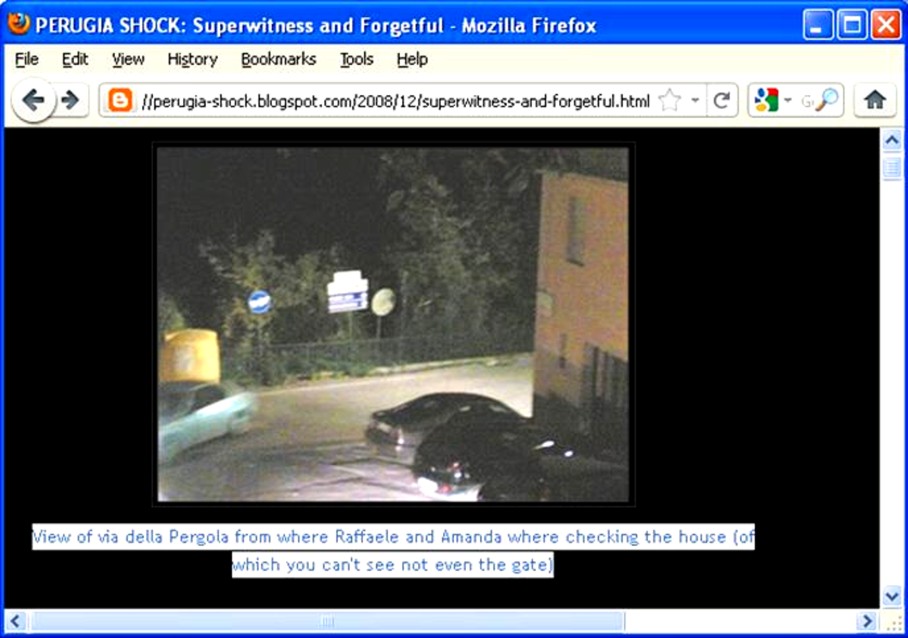
Above: The Perugian blogger provided momentary pressure release for the cooker, by posting this image with the accompanying text to emphasize that you can’t see the cottage gate from Amanda Knox’s and Raffaele Sollecito’s alleged perch on the raised edge of the Piazza Grimana. The logic of the argument is that if neither you nor I can see the cottage gate (in that photo), then neither could Knox nor Sollecito, and therefore the prosecution theory was not applicable.
The Perugian blogger’s photo from Piazza Grimana was perfect for the requirements of the cooking blogger, and a grateful post soon went up on her site:
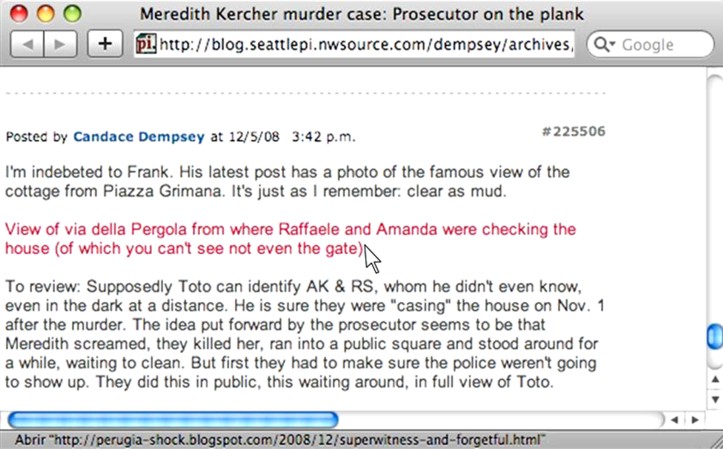
Above: A pro-Knox Seattle food blogger with a personal blog on the Seattle PI site was relieved to have visual support for her theory that the view of the cottage gate from Piazza Grimana is “clear as mud”. (Source: Seattle PI amateur blog Note: this comment and other followup ones were cleansed ““ erased ““ a long time ago. )
The online blog discussion could have drifted on to other topics if it weren’t for the fact that many of us knew perfectly well that you can see the cottage gate from Piazza Grimana. Even a person not familiar with this case, upon examining the apparent proof provided by the Perugian blogger that the building on the right might negate the possibility of two murderers staking out the cottage entrance ramp, could come up with an effective answer :
Above: It’s just a jump to left, that’s all that is required to gain the line of vision needed to watch the access to the cottage. (Source: Rocky Horror Picture Show)
Above: Let’s try something extremely obvious that the Perugian blogger seems to have avoided in evaluating whether you can see the cottage gate from Piazza Grimana “¦ what will happen if we move a little to the left?
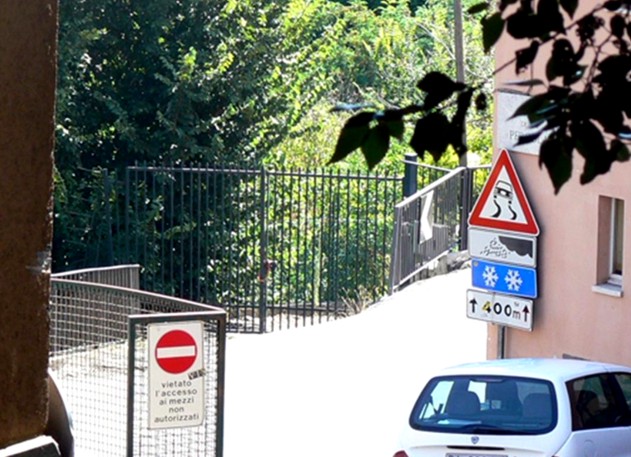
Above: Luckily, the TJMK editor had been in Perugia and came back with an extensive collection of photos of the things he had seen, including the view of the cottage access ramp from Piazza Grimana.
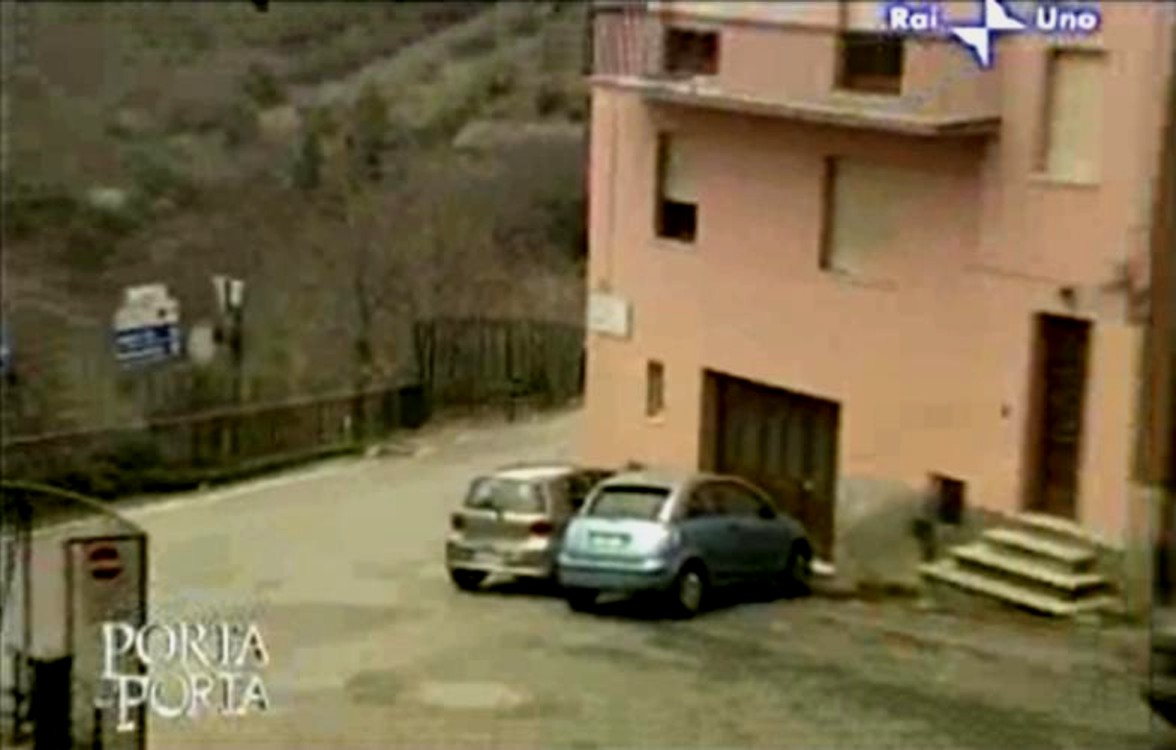
Above: Even Italian television was providing the view that Knox and Sollecito may have had from Piazza Grimana of the cottage gate. Why would the Perugian blogger and his pro-Knox lobby group associates want to deny this view from the English-language debate on the case?
If from just a couple of metres to the left you get a completely different story compared to the shadows to the right, and that makes plausible one element of a prosecution theory, I would have thought that a real freelance reporter would not avoid reporting on the obvious.
Test 3, Step 2: Conclusion
This test has been a credibility check. My opinion is that if the Perugian blogger applies the Jump-to-the-right book of extra-judicial lobby blogging, instead of the Jump-to-the-left book of journalistic reporting ““ to the detriment of the prosecution of a criminal case ““ then it is within the realm of reason that such a tendency toward misinformation / incomplete information about Mignini could also be applied by the blogger in describing to CPJ a Mignini-directed violent attack by rogue policemen loyal to Mignini and not their superiors, and who had no other reason to appear at the home of the real person behind the Perugian blogger’s screen-name other than to threaten him into not writing about a case that was already long out of the hands of said prosecutor.
Let’s update the Balance Sheet for Testing CPJ’s Anti-Mignini Accusations and see where things stand:
[below: The results of the third test of credibility in the anti-Mignini accusations only serve to worsen the state of the CPJ’s own credibility.]
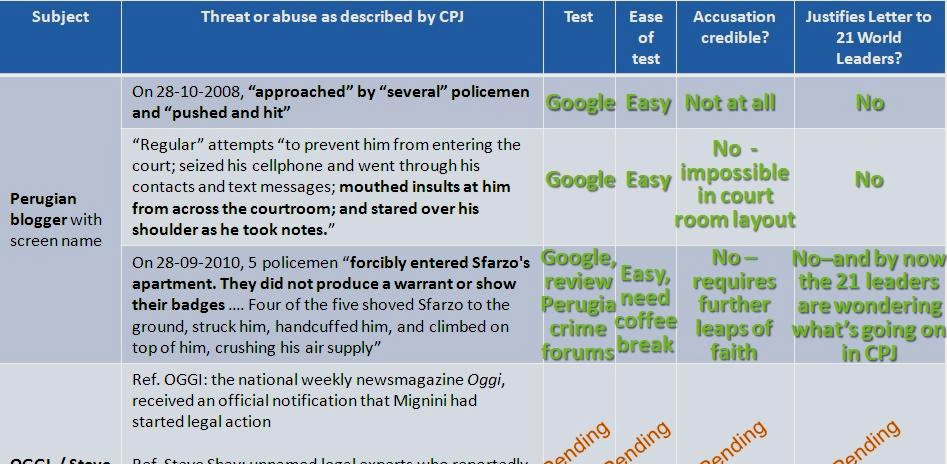
CPJ Accusation #4 Against Italian Justice Officials: Mr Mignini Sues For Defamation Without Cause?
Posted by Kermit
Overview. In our Second Open Letter to Joel Simon and world leaders we noted that NOT ONE of the accusations against Italian officials on close examination stands up. This is Attachment Four to that letter. More investigative posts are to come.
CPJ Accusation 4: “[CPJ] an independent, nonpartisan organization dedicated to defending the rights of journalists worldwide, is deeply concerned about local authorities’ harassment of journalists and media outlets “¦. CPJ is particularly troubled by the manifest intolerance to criticism displayed by Perugia Public Prosecutor Giuliano Mignini, who has filed or threatened to file criminal lawsuits against individual reporters, writers, and press outlets…. [Editor of] the national weekly newsmagazine Oggi, received an official notification that Mignini had started legal action against him in response to an Oggi article…. the U.S. weekly newspaper West Seattle Herald”¦ published an article that “¦ contained a reference to unnamed legal experts who reportedly believed Mignini to be “mentally unstable.” “¦. swift reaction by Mignini “¦ (who) file a defamation claim against the West Seattle Herald… Joe Cottonwood, another U.S. writer Mignini has threatened with a criminal defamation lawsuit ... the action stems from a “¦ comment (where) Cottonwood described Mignini as an “intellectually dishonest bully.” (Source: CPJ Letter to 21 World Leaders 19-04-2011 ) “What we are concerned about is that the press - domestic and international - is free to report and comment on the case without fear of reprisal.” (Source: CPJ followup explanatory note 28-04-2011. )
First a clarification. Joel Simon presumably means the press should be free to report accurately and without unfounded libelous smears. Let’s hope that he doesn’t really maintain reporters’ rights to defame without basis, to provoke unhinged ranters on the web who channel hate against the Perugia officials and those who support them day-in and day-out.
Forensics Method for Test 4: Common sense and a little Google
Line of Investigation for Test 4: Let’s get this straight: here the CPJ is concerned that reporters and news media will not freely report or express opinions in the case of the murder of Meredith Kercher. The CPJ believes that this is happening because of threats by Mr. Mignini.
I think that we should check to what extent the press actually feels threatened, and to what extent they are modifying their comportment due to Mr. Mignini’s supposed inappropriate actions which the CPJ considers go beyond what could be reasonably expected.
Test 4a, Step 1:
Google: judge sues newspaper defamation (enter)
You get 1,750,000 results, so it’s clear that the fact that members of the judiciary sue the press is not something that Mr. Mignini invented. You probably see where I’m going, so I’ll save us the effort of doing a few additional seconds of Googling different combinations like:
- Google: judge sues radio slander (enter)
- Google: judge sues media defamation (enter)
And so on. You end up with many, many millions of Google responses.
Since I’m trying to limit the execution of this test to a matter of seconds, let me take one of the mundane examples from the first page of Google results: this spring, the Voice of Richmond, a small local newspaper in Richmond, Virginia, was sued for the second time in two years, by the judge and a lawyer in the first case.
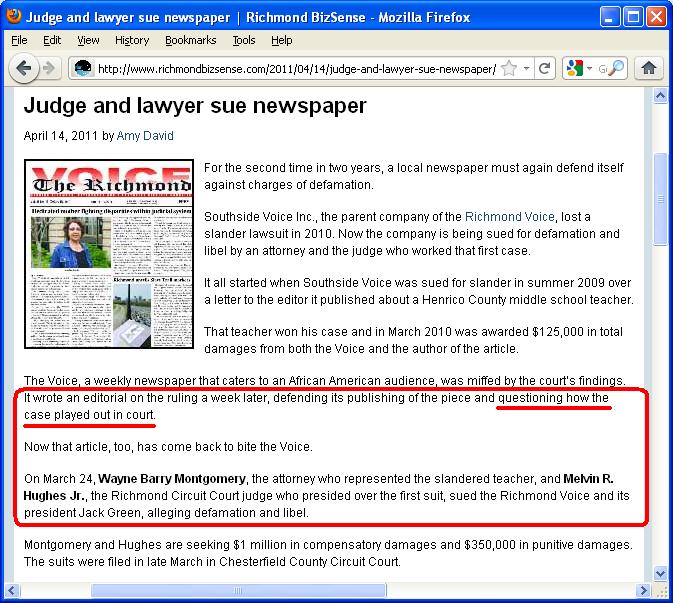
Above: A defamation suit by a member of the judiciary or any other citizen is the most normal thing in the world. Most examples ““ like this case involving the Voice of Richmond, which I selected simply because it was one of the first Google results ““ are related to questioning the appropriateness of courtroom procedures.
Other defamation suits, like Mignini’s claims against the West Seattle Herald’s reporter Steve Shay’s article (“mentally unstable”) or Joe Cottonwood (“intellectually dishonest bully”) are not against incursions limited to question the procedures in a legal case , but against open and baseless personal attacks, as seen from the point of view of the victim.
Is the CPJ concerned about the defamation suit against the Voice of Richmond? Has it published a letter to political leaders and pasted it prominently on its site, claiming that the judge in Richmond should just sit back and take criticism of his courtroom procedures?
If the Voice of Richmond newspaper, instead of being critical of courtroom procedures in a potentially defamatory manner, had associated the judge’s good name with the expression “mentally unstable”, or if the paper had called him an “intellectually dishonest bully”, only then would the CPJ have jumped in to defend the Voice of Richmond’s right to do such name calling?
The conclusions to this test, I must say, are pretty obvious.
My point is that while most people will agree with CPJ that public officials should put up with criticism of their work, we all agree that personal smears (or what the alleged defamation victim and the public could see as a personal smear) certainly should give way to the right to defend one’s honour.
This should be the case not only in the thousands of cases documented in Google that the CPJ doesn’t seem to get worried about (which is good news), but also in the case of Mr. Mignini, whom someone in or very close to the CPJ seems to be especially nervous about (which is disturbing news).
Test 4b, Step 1:
With just the results of Test 4a, I could already proceed to update the Balance Sheet for Testing CPJ’s Anti-Mignini Accusations as regards the example of Mignini suing certain persons or news outlets for personal attacks against his honour.
However, let’s take a fast look at each of those persons or news outlets to see if there are any factors which could change in one direction or another our conclusion that it’s perfectly normal for a person in the judiciary to sue for defamation, in particular when the alleged defamation does not concern his professional activity but his personal characteristics.
Without further ado, let’s carry out another search.
Google: site:oggi.it “oggi.it” amanda knox OR edda OR chris OR mellas (enter)
Each reporter, newspaper and magazine out there has their own view on the personalities in the Meredith Kercher murder case. There are a couple of outlets, like OGGI magazine which for some unknown reason have taken a particular liking to the Knox Mellas family, resulting in the members of this family and their travails getting special coverage, as the Google results show (use the Google translator if need be).
[Above: The Knox-Mellas clan find one corner of ongoing support and sympathetic coverage in Italy in OGGI magazine.]
The fact that this magazine takes a particular view to Amanda Knox’s family is a question of how they want to focus their coverage of this case. Quite another thing are their insinuations about certain elements of the prosecution’s case.
For example, in recent weeks there seems to be an all out attack on the hearing capacity and the mental faculties of Signora Nara Capezzali, a neighbour who on the night of Meredith Kercher’s murder heard the running of multiple persons near the cottage, just after a piercing scream (the danger of this testimony for pro-Knox forces is that it points to more than one person being involved in the crime, including Amanda Knox).
Just for interest’s sake, to see how Amanda Knox friendly voices have latched onto this issue, do another fast Google search: “amanda knox” “nara capezzali” deaf OR crazy OR psychiatric (enter)
OGGI and reporter Giangavino Sulas participated in the attack on Signora Capezzali, and by extension on prosecutor Mignini’s case:
“The witnesses “¦ suffer from sufficiently serious problems of deafness, of physical and also mental health, to be hospitalized in a psychiatric ward (as in the case of Nara Capezzali).” (Source: Giangavino Sulas , OGGI Magazine, April 2011)
This test and the ones that follow are not meant to prove anything in particular as regards Mr. Mignini’s right to defend his honour (which we saw clearly in Test 4a).
However, these additional tests do put some perspective on those who decry Mignini as threatening (or whom CPJ has dug up as “victims” of Mignini ““ I’m not aware that either OGGI, Steve Shay or Joe Cottonwood were searching for the CPJ to ask it to put together its Letter to 21 World Leaders, not even a junior reporter from the diminutive West Seattle Herald could have been able to dream that up).
In addition, if what CPJ is concerned about is “that the press—domestic and international—is free to report and comment on the case without fear of reprisal”, (Source: CPJ followup explanatory note 28-04-2011 ) it is more than evident by consulting recent reporting by OGGI and in particular by Giangavino Sulas, that that magazine and reporter are not holding back in examining and opining on all elements of the prosecution and conviction of the murderers (pending appeal) of Meredith Kercher.
Test 4c, Step 1:
Let’s go to a popular pro-victim discussion board concerning the murder of Meredith Kercher, such as TJMK or the Perugiamurderfile.org. Do a search for Steve Shay, and you will see references to examples on other sites which demonstrate how this reporter swims like a fish amongst pro-Knox social networking friends.
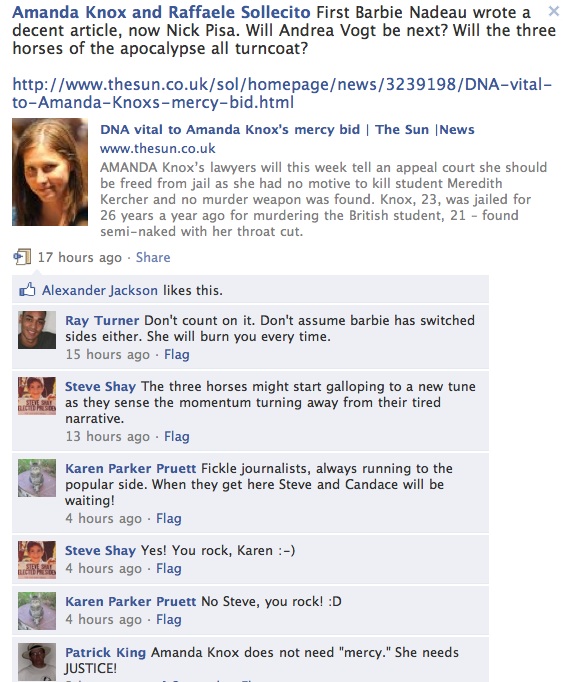
Above: When West Seattle Herald reporter Steve Shay infiltrates Internet social groups to gather information for his next story, he sure does a good job of appearing to be like-minded with his fellow posters, in this case, the Friends of Amanda lobby Facebook group.
(Source: Facebook, image on Perugiamurderfile.org)
Steve Shay’s own social networking postings and his ongoing reporting in the West Seattle Herald demonstrate that Mignini’s potential lawsuit has not made him or his newspaper wither (my personal opinion is that he takes it as a sort of medal that he wears proudly on pro-Knox discussion boards and at FOA money making events).
The CPJ itself states explicitly that “in an email interview with CPJ, West Seattle Herald Editor Ken Robinson said “¦ that the paper does not fear repercussions from Mignini “¦. he and his newspaper were not perturbed by the prosecutor’s actions”.
So why all the fuss in the CPJ Letter to the World about reporters and newspapers holding back in having a go at the Meredith Kercher murder case?
The CPJ itself shows that some reporters like Steve Shay can have their cake and eat it too.
Test 4d, Step 1:
I feel a little sorry for Joe Cottonwood, as he appears to have haplessly stepped into an international scene of attacks against Mr. Mignini. However, if the Italian law says that you can’t call someone an “intellectually dishonest bully”, then you should be careful.
Let’s do a fast test on Mr. Cottonwood.
Type Google: joe cottonwood (enter)
From the Google search results, you can take a look at Cottonwood’s own site, or see a summary of his activity in the Wikipedia page on him: “Joe Cottonwood is an American author of fiction and poetry for adults and children. He was born in 1947 and lives in La Honda, California.” (Source: Wikipedia )
Cottonwood not only doesn’t report on the Meredith Kercher murder case, he isn’t even a reporter, nor even calls himself a blogger or a freelancer or journalist.
You can hardly say that Mignini’s legal action to defend his personal honour will affect Cottonwood’s coverage of the case, which is what CPJ’s Letter to 21 World Leaders is all about as CPJ stated in its clarification commentary on its Open Letter..
The fact that Cottonwood is included in an international missive of a journalists’ sectorial association when that isn’t even his profession makes me think that CPJ (or whoever really prepared the Letter to the World) was scraping the barrel for examples.
Approximate time required to obtain material to be analysed: less than 1 second for Google searches, a few minutes to enter and search discussion forums.
Tests 4a, 4b, 4c, 4d Step 2: Conclusions
If American judges can sue for defamation in situations which are less personally insulting than what Mr. Mignini has had to put up with, and this defamation in America doesn’t provoke CPJ’s intervention, then Mr. Mignini’s personal legal actions can’t be worth a Letter to 21 World Leaders.
In addition, simple observation of your examples of three defamation suits shows that it is not true that Mignini’s legal actions to defend his personal honour have affected news reporters’ coverage of the Amanda Knox case.
It is strange and worrying that the Committee to Protect Journalists for some reason wants to deny Mr. Mignini his constitutional right as an Italian and European citizen to not be the subject of abusive attacks.
Let’s do one final exercise: search Google for Mignini and various hate terms like “mentally unstable” and you could conclude that reporters and anonymous bloggers have made Giuliano Mignini into the second most hated man on the planet after Bin Laden - who now, of course, is dead.
Hate remarks against Mignini are now up in the hundreds of thousands, possibly millions. The BBC looked into just some of the shrill claims made by reporters whom Joel Simon wants to keep supporting in their anti-Mignini drive and actually found nothing there.
We’re moving along, and as usual, the best is yet to come. Let’s update the Balance Sheet for Testing CPJ’s Anti-Mignini Accusations with our latest findings. I fear that the CPJ is not doing well:
[below::The results of the fourth set of credibility tests of the anti-Mignini accusations gives us the feeling that the CPJ has no basis whatsoever for the accusations, nor does it have justification for sending a Letter to 21 World Leaders.]
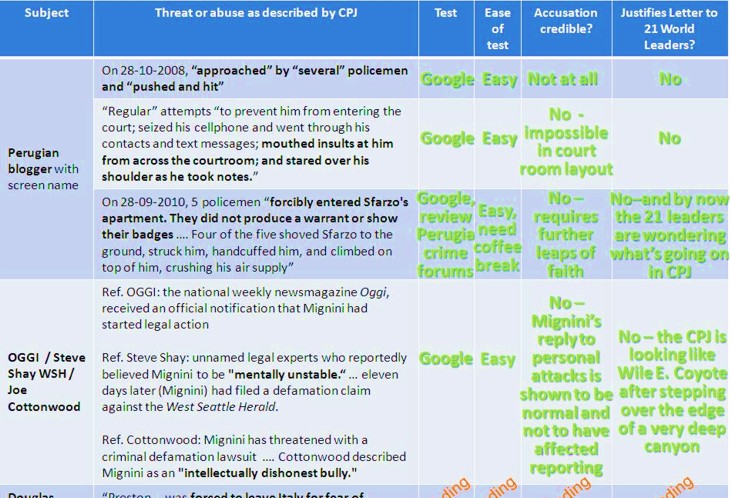
How America’s Premier Justice College Misrepresents Italian Justice - To Global Audience
Posted by brmull
Conflicts between Kassin’s academic and court personas
Saul Kassin is a psychologist with the John Jay College of Criminal Justice in New York. He tries to advance the notion academically and in court that many confessions are coerced by the police and thus false.
In writing about American cases of confessions, Kassin would normally be very sure to interview all the parties to the confession. Police would not simply be sidelined, and the confessor’s tale would not be the only narrative he pays attention to. His academic pieces would normally be peer-reviewed and any claims which were questionable would be examined by the academic peers or the readership. False claims by Kassin could result in criminal complaints and civil lawsuits.
It is quite clear from online postings that Saul Kassin was taken on as a hired gun for the Knox defense in the Knox/Sollecito trial in Perugia. He was being paid NOT to simply be academic and objective, he was being paid to give the police witnesses and prosecution as hard a time as possible.
Although he seems to have flown to Perugia at one point he definitely did not encounter let alone interview even one police officer, even one prosecutor or even one judge. He made no visit to the questura where the Knox questioning took place. He doesnt speak or read Italian so he would not be able to get to grip with original evidence.
He does not reveal if and when he interviewed Amanda Knox herself. She makes no mention of any meeting with Kassin in her book. Kassin was definitely not in court in mid-2009 when Amanda Knox was cross-examined for two days on the witness stand about her false allegations against Patrick Lumumba. Her stint on the stand was regarded as a disaster for her by most of those present.
Conflicts consequentially plaguing Kassin’s academic judgments
During the Hellmann appeal in 2011 [subsequently annulled by the Supreme Court in 2013] Kassin started to use his academic standing and ostensible objectivity to propagate to American and later global audiences his hired-gun take for the defense. He had still not interviewed anyone in the Perugia police or prosecution.
He never made clear that his description of Knox’s interrogation was already UNIVERSALLY discredited in Italy - and that even Knox had admitted that the police treated her fairly. He never explained what peer review process his many pieces went through. Not one police officer or prosecutor in Perugia was contacted by any peer reviewer seeking confirmations. This suggests either that there was no peer review or it was unethically cooked in some way.
Our own peer reviews of Kassins proliferating claims
One month ago my fellow poster the Machine took apart ten claims which Saul Kassin made last year in a Seattle radio interview. As the Machine showed, every one of those claims fall apart once one refers to official documents and the more objective case books and websites.
Another post one month ago by my fellow poster Fuji showed that Amanda Knox is NOT likely to issue false confessions in the heat of an interrogation moment.
That is Kassin’s key claim here, and in effect Fuji used Kassin’s own “science” against him.
Then we were warned by a John Jay colleague critical of Kassin that he had repeated these same spurious claims live on television - and that Kassin had made even more wrong claims in a keynote speech to a conference of the elite John Jay College in June in New York, in front of an influential international audience.
And he did so again in a paper, possibly peer-reviewed, which the respected journal American Psychologist has placed online. This post provides the truth on the Knox-related claims at the front and back ends of that American Psychologist paper.
Saul Kassin still appears to want to argue that Amanda Knox was convicted ONLY based on a false confession (as the Machine and numerous posts on TJMK show, she wasn’t - and in fact, Knox didn’t even confess) and he now makes almost 50 erroneous assertions about the case.
You can see highlighted in the first box-quote below those misleading and erroneous passages of PR shill Kassin which I correct in the second box-quote below.
(1) SAUL KASSIN’S ORIGINAL VERSION WITH WRONG STATEMENTS HIGHLIGHTED
As illustrated by the story of Amanda Knox and many others wrongfully convicted, false confessions often trump factual innocence. Focusing on consequences, recent research suggests that confessions are powerfully persuasive as a matter of logic and common sense; that many false confessions contain richly detailed narratives and accurate crime facts that appear to betray guilty knowledge; and that confessions in general can corrupt other evidence from lay witnesses and forensic experts””producing an illusion of false support. This latter phenomenon, termed “corroboration inflation,” suggests that pretrial corroboration requirements as well as the concept of “harmless error” on appeal are based on an erroneous presumption of independence among items of evidence. In addition to previously suggested reforms to police practices that are designed to curb the risk of false confessions, measures should be taken as well to minimize the rippling consequences of those confessions….Meredith Kercher was found raped and murdered in Perugia, Italy. Almost immediately, police suspected 20-year-old Amanda Knox, an American student and one of Kercher’s roommates””the only one who stayed in Perugia after the murder. Knox had no history of crime or violence and no motive. But something about her demeanor””such as an apparent lack of affect, an outburst of sobbing, or her girlish and immature behavior”” led police to believe she was involved and lying when she claimed she was with Raffaele Sollecito, her new Italian boyfriend, that night.
Armed with a prejudgment of Knox’s guilt, several police officials interrogated the girl on and off for four days. Her final interrogation started on November 5 at 10 p.m. and lasted until November 6 at 6 a.m., during which time she was alone, without an attorney, tag-teamed by a dozen police, and did not break for food or sleep. In many ways, Knox was a vulnerable suspect””young, far from home, without family, and forced to speak in a language in which she was not fluent. Knox says she was repeatedly threatened and called a liar. She was told, falsely, that Sollecito, her boyfriend, disavowed her alibi and that physical evidence placed her at the scene. She was encouraged to shut her eyes and imagine how the gruesome crime had occurred, a trauma, she was told, that she had obviously repressed. Eventually she broke down crying, screaming, and hitting herself in the head. Despite a law that mandates the recording of interrogations, police and prosecutors maintain that these sessions were not recorded.
Two “confessions” were produced in this last session, detailing what Knox called a dreamlike “vision.” Both were typed by police””one at 1:45 a.m., the second at 5:45 a.m. She retracted the statements in a handwritten letter as soon as she was left alone (“In regards to this “˜confession’ that I made last night, I want to make it clear that I’m very doubtful of the verity of my statements because they were made under the pressures of stress, shock, and extreme exhaustion.”). Notably, nothing in the confessions indicated that she had guilty knowledge. In fact, the statements attributed to Knox were factually incorrect on significant core details (e.g., she named as an accomplice a man whom police had suspected but who later proved to have an ironclad alibi; she failed to name another man, unknown to police at the time, whose DNA was later identified on the victim). Nevertheless, Knox, Sollecito, and the innocent man she implicated were all immediately arrested. In a media-filled room, the chief of police announced: Caso chiuso (case closed).
Police had failed to provide Knox with an attorney or record the interrogations, so the confessions attributed to her were ruled inadmissible in court. Still, the damage was done. The confession set into motion a hypothesis-confirming investigation, prosecution, and conviction. The man whose DNA was found on the victim, after specifically stating that Knox was not present, changed his story and implicated her while being prosecuted. Police forensic experts concluded that Knox’s DNA on the handle of a knife found in her boyfriend’s apartment also contained Kercher’s blood on the blade and that the boyfriend’s DNA was on the victim’s bra clasp. Several eyewitnesses came forward. An elderly woman said she was awakened by a scream followed by the sound of two people running; a homeless drug addict said he saw Knox and Sollecito in the vicinity that night; a convicted drug dealer said he saw all three suspects together; a grocery store owner said he saw Knox the next morning looking for cleaning products; one witness said he saw Knox wielding a knife.
On December 5, 2009, an eight-person jury convicted Amanda Knox and Raffaele Sollecito of murder. The two were sentenced to 26 and 25 years in prison, respectively. Finally, on October 3, 2011, after having been granted a new trial, they were acquitted. [Actually they still stand accused - and facing a tough fact-based prosecution appeal] Ten weeks later, the Italian appeals court released a strongly worded 143-page opinion in which it criticized the prosecution and concluded that there was no credible evidence, motive, or plausible theory of guilt. For the four years of their imprisonment, this story drew international attention (for comprehensive overviews of the case, see Dempsey, 2010, and Burleigh, 2011).1
It is now clear that the proverbial mountain of discredited evidence used to convict Amanda Knox and Raffaele Sollecito was nothing but a house of cards built upon a false confession. The question posed by this case, and so many others like it, is this: Why do confessions so often trump innocence? ...
Third, it is important to realize that not all evidence is equally malleable or subject to corroboration inflation. Paralleling classic research indicating that expectations can color judgments of people, objects, and other stimuli that are ambiguous as opposed to those that compel a particular perception, forensic research indicates that ambiguity is a moderating condition. Asked to report on an event or make an identification decision on the basis of a memory trace that cannot be recovered, eyewitnesses are particularly malleable when confronted with evidence of a confession (Hasel & Kassin, 2009). This phenomenon was illustrated in the case against Amanda Knox. When police first interviewed Knox’s British roommates, not one reported that there was bad blood between Knox and the victim. After Knox’s highly publicized confession, however, the girls brought forth new “memories,” telling police that Kercher was uncomfortable with Knox and the boys she would bring home (Burleigh, 2011). ...
In recent years, psychologists have been critical of the problems with accuracy, error, subjectivity, and bias in various types of criminal evidence””prominently including eyewitness identification procedures, police interrogation practices, and the so-called forensic identification sciences, all leading Saks and Koehler (2005) to predict a “coming paradigm shift.” With regard to confessions, it now appears that this shift should encompass not only reforms that serve to minimize the risk of false confessions but measures designed to minimize the rippling consequences of those confessions””as in the case of Amanda Knox and others who are wrongfully convicted.
(2) MY REPLACEMENT VERSION WITH CORRECT FACTS AND CONTEXT NOW INCLUDED
On November 2, 2007, British exchange student Meredith Kercher was found sexually attacked and murdered in Perugia, Italy. The next day, 20-year-old Amanda Knox, an American student and one of Kercher’s roommates, became a person of interest, along with Meredith’s downstairs neighbors and several of her other acquaintances. Interviewing close contacts is a cornerstone of police work. Two of Meredith’s close English friends, who were so scared they couldn’t sleep alone, left Perugia in the immediate aftermath of the murder. Everyone else stayed on.Months before arriving in Perugia, Knox received a citation for a noise violation when a going-away party she’d thrown for herself in Seattle got out of hand. One of the officers described it as a “scene from Baghdad.” Within about three weeks of moving into the cottage in Perugia, Knox was ejected from a nightclub for pouring her glass on the head of a disc jockey.
It’s often said that Knox had no motive to kill Meredith, but it was Knox’s claim of drug use which indicated a possible motive: a drug-fuelled assault. There are various others, though a motive is not actually required for conviction. In crime scene videos from the day Meredith’s body was discovered, Knox can be seen outside the cottage glancing furtively around. Still, it was not this and other odd behavior, but rather the many conflicting witness statements by Knox and her new Italian boyfriend, Raffaele Sollecito, that led police to believe Knox was involved and lying when she claimed she was with Sollecito at his home continuously on the night of November 1.
Police interviewed dozens of witnesses in the days after the murder, some more than once. All witness statements were written down and signed for, not recorded. The police interviewed Sollecito for the third time beginning at 10:40pm on November 5. Knox later testified that she voluntarily accompanied her boyfriend to the station, because she didn’t want to be alone. The police did not summon her. To the interviewers’ surprise, Sollecito repudiated his earlier alibi when shown phone records, and now said Knox had left his apartment for much of the evening. Some time after 11:00pm the police asked if they might interview Knox. An interpreter was called and by 1:45am Knox had given a signed statement that she had witnessed the sounds of her employer, bar owner Patrick Lumumba, murdering Meredith at the cottage.
In that statement she acknowledged that she had been given an interpreter, and that she herself was now officially a suspect. Knox later testified that she was treated well. She was offered snacks and drinks during the interview and afterward. Made aware that she could not be interrogated without a lawyer, but still anxious to put out as much information as possible, she then requested a chance to make a spontaneous statement without any questioning. Dr Mignini, the magistrate on duty, was called from his home, and she gave a statement in front of him very similar to her witness statement from hours earlier. He asked no questions.
Knox and the police gave different accounts of how the 11:00 to 1:45 am interview was conducted. Police said Knox was told Sollecito now no longer confirmed her alibi and he had called her a liar. She now had no alibi. Sympathetic to her because Knox was freaking out, the interpreter urged her to try to remember at least something. Shown a text she had sent to Lumumba at 8:35pm saying “See you later. Have a good evening!” she was asked to explain this. The police describe how Knox started to cry and burst out, “It’s him! It’s him!”
Both Knox’s witness statement at 1:45 a.m and her voluntary suspect statement at 5:45am were written out in Italian and translated back to her before she signed. After Knox was formally taken into custody at midday on November 6, she asked for paper and wrote a slight modification of her earlier statements, adding: “In regards to this “˜confession’ that I made last night, I want to make it clear that I’m very doubtful of the verity of my statements because they were made under the pressures of stress, shock, and extreme exhaustion.”
Lumumba was arrested along with Knox and Sollecito. Knox and her mother held out on his non-involvement for weeks, but he was eventually determined to have a solid alibi. Another man, Rudy Guede, was identified through a hand print in Meredith’s bedroom. Knox appeared to have substituted Lumumba for Guede in her statements, and several details of the crime in her so-called confession were later corroborated by witnesses.
Because police had not needed to provide Knox with an attorney at the impromptu witness interview after 11:00, the Supreme Court ruled that statement inadmissible in the murder case against her. However both statements were ruled admissible in court for the purpose of establishing the crime of defamation against Patrick Lumumba. Knox’s November 6 letter was also ruled admissible.
Guede, the man whose DNA was found on the victim, told a friend while he was still on the run that he had found Meredith stabbed and that Knox had nothing to do with the murder. However, in the same conversation, which was recorded by police, he speculated that Knox and Sollecito might have been at the cottage. In a letter dated March 7, 2010, while his sentence was awaiting final confirmation by the Supreme Court, Guede wrote that Knox and Sollecito murdered Meredith. He reiterated this claim as a witness during Knox and Sollecito’s appeal.
Forensic police from Rome concluded that a kitchen knife found in Sollecito’s apartment had Knox’s DNA on the handle and Meredith’s DNA on the blade. Sollecito’s DNA was on the victim’s bra clasp in Meredith’s locked bedroom.
Several eyewitnesses came forward. Three neighbors testified that they heard a disturbance around 11:30pm in the vicinity of the cottage. A homeless man who at appeal admitted heroin use was reading a newsmagazine at the basketball court near the cottage. He testified that he saw Knox and Sollecito four or five times that night. An Albanian, a possible drug dealer. who the Massei court deemed unreliable after the Micheli court accepted him, said he had seen all three suspects together, and that Knox had accosted him with a knife. A grocery store owner testified he saw Knox at his shop early on the morning after the murder.
The conflicting alibis of the two were never resolved during trial. On December 4, 2009, an eight-person panel consisting of two professional judges and six lay judges found Amanda Knox and Raffaele Sollecito guilty of murder aggravated by sexual assault, simulation of a burglary, unlawful carrying of a knife and, in Knox’s case, criminal defamation of Patrick Lumumba. The two were sentenced to 26 and 25 years in prison, respectively….
Knox’s mother later described her daughter as “oblivious to the dark side of the world.” Knox herself wrote that, on the night of the murder, she and Sollecito were talking about his mother’s suicide. She told him her philosophy was “life is full of choices and that these choices are not necessarily between good and evil, but between what’s better and what’s worse.”...
Results of our own peer-group analysis
Kassin asserted that the witnesses in this case imagined “new memories” unfavorable to Knox because of her highly-publicized confession. He referenced an experiment in which an unknown actor walked into a classroom and stole a laptop. The students were asked to try to identify the thief from a line-up. Two days later, the students were told which person in the line-up had confessed. Many changed their minds when told of the confession, although in truth the thief was never in the line-up at all.
Obviously this contrived scenario has nothing at all to do with Amanda Knox or people who had met her.
In his book, Meredith, the victim’s father John Kercher recalls his daughter complaining about Knox’s poor hygiene and how she brought home strange men several weeks before the murder. Numerous witnesses recounted specific anecdotes of Knox’s sharp-elbowed and offputting behavior. Her circle of friends quickly diminished only to Sollecito.
Really, could all these be “new memories”?
Psychologists studying eyewitness testimony, interrogation techniques and false confessions need to be circumspect. Even DNA testing, considered the best of the forensic sciences, requires a thorough understanding of circumstances in order to be interpreted correctly.
Kassin’s continued stonewalling and legal risks
I really wonder who agreed to publish him. I work in a science-based field. When I first learned Kassin had been recruited by Curt Knox’s hatchet men as a PR shill, had been put directly in touch with Knox herself, and had been provided with pre-selected reading materials, I wrote to ask him why he hadn’t disclosed all this to his readers.
Still no reply.
It’s true that numerous talking heads have exaggerated their qualifications and concealed their conflicts of interest and financial stakes when speaking in support of the defense. Judge Mike Heavey abused his oath of office to try to sway the process.
What’s different about Kassin is that, using his John Jay College aura, he has corrupted the scientific record with misinformation.
And he has done this, at least in part, with the goal of misleading an Italian court. These dirty tricks are especially dangerous because most people, including judges, expect that what’s stated as fact in prominent academic journals is objective and true.
Kassin looks to us nothing like an academic here. He looks instead like a defense hired gun who (only in English and only in America) has repeatedly falsely accused police officers of serious felonies in how they questioned Knox as a witness.
If even a single complaint is lodged in Italy and Kassin cannot prove his 50 or so seemingly-spurious and very damaging claims, he could find himself facing years in an Italian prison for attempted obstruction of justice.
Kassin’s peers need to press him for the truth once and for all, and to stop him using his academic mantle illegally and academically unethically as a cloak for a sleazy defense campaign.
[Everything in this post applies equally to the ludicrously inaccurate claims of ex FBI “mindhunter” John Douglas in his books and lobbying at the State Department.]
Why “Buyer Beware” Re Amanda Knox Could Be A Very Good Idea For The Innocence Project
Posted by Our Main Posters
1. Innocence Project Conference
The annual national conference of Barry Sheck’s Innocence Project is to take place on Friday and Saturday in Portland, Oregon.
Dozens of American who claim they were unfairly treated by the American justice system will share their stories and give pointers for measures that paid off for them.
We tend to believe them. We have long highlighted that in terms of fairness and carefulness the American system and Italian system are poles apart.
At this conference Amanda Knox will try to get the Project’s support.
However. Knox may be the least useful convicted perp on the planet for the Innocence Project to get behind or learn anything from.
- First, the Italian system is not remotely as she and her colleague Sollecito describe it. It is in fact a system the United States is starting to emulate. If widely adopted the Innocence Project would have a very light load and most of those at the conference would not even have had cause to be there.
- Second, the case against Knox and Sollecito is an overwhelming one with far more and far stronger evidence points than UK and US courts normally require for conviction. The 2011 appeal was automatic; in the US and UK grounds for allowing an appeal would have been considered lacking. (The Supreme Court ordered the 2013 appeal.)
- Third, the Knox-Mellases have run a despicable multi-million-dollar PR campaign. That has proved not only ineffectual but massively damaging to many good people, and a source of tension between two countries. The blood money Knox and Sollecito have achieved from their dishonest books and endless money-grubbing create a new world record for illegally profiting from a crime.
- Fourth, a drooling and irresponsible academic who represents the Innocence Project in Idaho, who may be beholden to the mafias, and who criminally inserted himself into the appeal process in Italy, claims to be beating the drum for Knox at the conference.
Barry Scheck and REAL victims everywhere would really be best served by taking these wise precautions
(1) kicking the foolish grandstanding mafia tool Greg Hampikian out of the Innocence Project,
(2) learning things from the very impressive Italian system, which could help many REAL victims,
(3) deny Knox yet another forum to frame Italians, mislead Americans, and make even more illegal blood-money .
For Barry Scheck and genuine justice and REAL victims everywhere, distancing themselves from Knox would be the smart outcome. Let her stick to autographing this in the lobby.
Innocence Project: Seven Years Clutching Knox And Trashing Italian Justice To Joy Of Mafias #1
Posted by Hopeful
1. Series Overview
Barry Scheck’s Innocence Project quite openly admits to bending the 2011 appeal via collaboration with the “independent” DNA consultants.
Anyone who thinks Idaho IP representative Greg Hampikian’s seemingly illegal involvement in the court-ordered DNA re-testing was somehow competent and truth-based should read KrissyG and James Raper for two blasts of reality.
Beginning early in 2014 (soon after the Florence Appeal Court reaffirmed Knox’s guilty verdict and a whole year prior to the Supreme Court outcome) the Innocence Project clutched Knox firmly and propelled her onto the elite speakers’ circuit. It has repeatedly used her since as a keynoter and potent draw for attendees and presumably for funding too.
Knox’s speaking career would have gone absolutely nowhere if Barry Scheck & Co had not promoted her with such manic enthusiasm. They still remain unencumbered by comprehensive due diligence or a fact-based narrative. Much simply seems unknown. Trashing Italy is apparently just fine.
Late next month at an Innocence Project “gala” in Kansas City Knox will yet again be an IP keynote speaker.
2. The Jason Flom Podcast
Jason Flom is a founding board member of the Innocence Project. As the sharp eyes of our main poster Guermantes picked up, Flom interviewed Knox in January 2017 for a podcast: The Wrongful Conviction of Amanda Knox.
Flom seems to have done little or no homework. Most of these posts predate this interview. So an open-minded interviewer not toeing the self-serving IP party line could have avoided the naivety and manipulation we can see here.
Knox tells Flom the Perugian investigators (actually the highly respected national elite) were like children pretending to process a crime scene but making major mistakes. Her tone of voice suggested mockery and ridicule of them playing at being forensic scientists.
Flom laps up this nonsense unquestioningly. However Knox’s lies to Flom were mainly of omission, so much that she didn’t want to speak of and that Flom could not even comprehend.
When he asked her why she was targeted when several other people were at the cottage the morning the police arrived (Filomena, her boyfriend, Raffaele) Knox explained that her behavior didn’t impress police as that of an innocent person because she was kissing Raffaele and being comforted in the yard of the cottage.
There is no special sign that she was targeted. And she omits a mountain of other behavior. She refuses to tell Mr. Flom of her highjinks in the Questura, her tongue sticking out, her cartwheels, or her thong-buying visit to Bubbles, nor of her skipping the memorial service for Meredith in the days after the death. None of that escapes her lips.
She does pretend some indignation about Rudy Guede the “real killer”. Mostly she talks of every single sad emotion she endured in the 8 months of incarceration before she was charged with murder.
She mentions Meredith throughout the interview very little. She seems to be mostly swept up in memories of how she was robbed of hope behind bars, and she revels (this was 2017) in how a few persons who first thought her guilty have been convinced by more recent media that she is innocent and have apologized to her. She ascends skyward on such thoughts.
Her main concern seems to be with her public image and her power to con the world. It becomes evident when she narrates to Flom her morning at the cottage in the hours before Meredith’s body was discovered, when she first entered the cottage saying the door was wide open and she was there alone to take a shower before proceeding to go to Gubbio for the weekend with loverboy, that she was in a deep mental quandary as to the meaning of the open door, the small bits of blood in the sink (she emphasized to Flom how small the specks were) and the dirty toilet in a nearby bathroom that she was so greatly alarmed enough to want to slow down her trip out of town and instead bring Raf back over to see about things at the cottage and give his opinion.
She was so worried, she pretends. So terribly worried, but not worried enough to walk a few feet down the hall and open a bedroom door to see if a roommate were present and hadn’t heard her “hello, is anybody there?” Ridiculous. She also mentions that her computer was safe in her own bedroom and hadn’t been stolen but not one word that her lamp was missing”¦ as if she wouldn’t have noticed that.
She talks much of her own humanity, that people who meet her will not judge her but will find her innocent, but if they haven’t met her in person they will assume guilt. She seems to feel that they need to be blinded by her “humanity” and give her a pass on having destroyed Meredith’s life. She says very little to Jason Flom about Raffaele, depicting him as a non-threatening puppy and their relationship before the murder as one of sweetness and a juvenile thing.
Mr. Flom suggests it was like a high school relationship between two college students, she half-way assents to his description. She said that the language barrier circumvented them from discussing deep issues, that it was mostly hand-holding and him wanting to give her perfume like Italian women wore and to show her some new store or market he had discovered.
Knox seems to hold her greatest anger and disdain (well-hidden of course unless you know this case backwards and forwards and have seen Knox’s wiles) toward Philomena. It was Philomena’s hysterics and shouts of “a foot, a foot” and the general screaming and shouting of spontaneous anguish and grief over knowing it was Meredith’s body in the bedroom, that seems to antagonize Knox the most. Imagine that, some people actually GRIEVED for Meredith and thought her worthy of a display of emotion and concern.
Knox tells Jason Flom that it was Philomena’s SIM card inside the cell phone that Meredith was using, that tied the phone to the cottage. It was Filomena’s SIM card that enabled the first police to rush to the cottage so fast, and who interrupted Knox in her little last minute cleaning scheme and that threw her out of her rhythm and almost tripped her up by arriving so quickly, perhaps that was why Knox despised Filomena so much. Also it was Filomena’s boyfriend who kicked open the door and thus sent Knox out of the cottage quickly and permanently. She seemed to show irritation with Flom when she spoke of being rousted from her house in Perugia.
She tells Flom that she believed the police when they said she was being sent to prison for her own protection, thinking she was a witness (untrue: grounds for arrest were fully explained by Dr Mignini). She said she should have realized when they put her in handcuffs that this was ludicrous, but she was naïve and idealistic.
She said she went to Japan and to Germany when she was 14 years old, and that her beloved Oma, her German grandmother, had wanted her to be an exchange student to Germany. She was taking German and Italian language classes before she went to Perugia, she said.
She seems to imply slightly that it was her father’s fault that she took the language courses rather her first love of creative writing. She said she felt she couldn’t have sold Dadddy on the usefulness of a creative writing degree, so she detoured and took the languages degree hoping to become a translator. She said that the University for Foreigners in Perugia was not demanding or rigorous at all and she was disappointed at that. (Hint hint, is she suggesting she had too much free time from studies and thus went wild due to “idle hands are the devil’s workshop”? She could easily have enrolled at the main university and gained course credits for her degree back in Seattle - as her parents believed she was doing.)
She bristles with rage at the thought of friends who suggested she change her name to deflect publicity. Never. Her ego is limitless and she wants to be herself, that is paramount. She said her biggest fear was that she would forever have to cower in a corner. She speaks of her determination to do the opposite now that she has her freedom back and is safe to speak.
She seems sincerely grateful to people who spent their energy and time in trying to get her free from prison, and feared she might have been forgotten and left to languish behind bars. She seems sincerely moved that people who didn’t have to care about her, did so. No doubt this is the natural reaction of anyone sprung from prison cells, whether guilty or innocent.
Her main beef behind bars was that she could not sway the entire world with her words alone. She talks a smooth line and certainly had Mr. Jason Flom in her sway. She also claimed that Meredith’s DNA had been thought to have been on the knife but that it was not (Carabinieri labs confirmed it was, so there’s another lie from Knox).
It irks me that people who question Knox won’t take time to read up on the case.
Why can’t they ask Knox about the 5 spots of her DNA mixed in Meredith’s blood throughout the cottage? Knox also laughs with Jason Flom about the impossibility of her cleaning up the crime scene, when it’s proven without question that a bloody footprint was erased that led to the footprint on the blue bathmat. Knox is lying about the cleanup.
And when Knox explained to Flom her discomfort at discovering the unflushed toilet, she tells him that Laura and Filomena were neat freaks (liked to keep a very clean house). She did not say the same for Meredith, but only mentioned Laura and Filomena being clean freaks. She did not tell Mr. Flom of her normal unflushed toilets that the long-suffering Meredith Kercher had to face daily.
Knox omits much of the truth, and twists the rest of the truth. Her best truth is whatever she can think up for the occasion. And the daffy Mr Flom swallows it.
3. Tip For IP Contributors
On Amanda Knox. Innocence Project Idaho rep Hampikian’s ONLY achievement was to be main cause of annulment of 2011 appeal, to anger of defense counsel. Thus he subjected Knox and RS to much tougher appeal, leading to desperate measures to bend Supreme Court. Thus Hampikian directly caused mafia involvement that Knox and RS must hide for life.
4. Next post in this series.
Click for Post: Innocence Project: Seven Years Clutching Knox And Trashing Italian Justice To Joy Of Mafias #2
Innocence Project: Seven Years Clutching Knox And Trashing Italian Justice To Joy Of Mafias #2
Posted by KrissyG
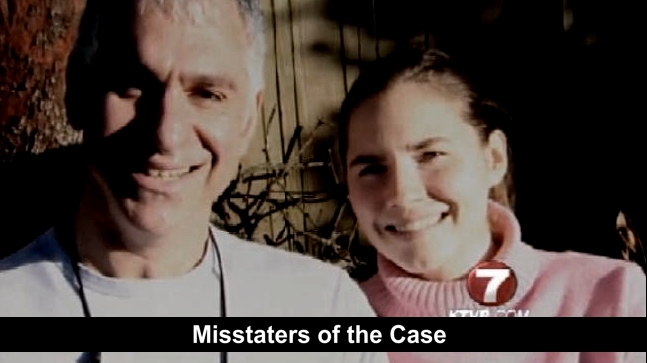
Long post. Click here to go straight to Comments
1. Post Overview
Previously main poster Hopeful showed up the intensely superficial grasp of the case by an Innocence Project founder who is a lusty huge booster of Knox.
We see no sign that anyone in the Innocence Project (IP) has ever done due diligence, or has any better grasp of the case than Jason Flom. We certainly don’t see any on video or in print. We see only appallingly misleading and illegal work…. and nothing else. As Hopeful said in that post:
Anyone who thinks Idaho IP representative Greg Hampikian’s seemingly illegal involvement in the court-ordered DNA re-testing was somehow competent and truth-based should read KrissyG and James Raper for two blasts of reality.
This may come as a surprise. In ten years nobody whatsoever has ever landed the slightest blow on the huge (though not pivotal) DNA component of the case.
The defenses and many others have seriously misrepresented it, yes, but that is something else.
2. Chief IP Misleader Hampikian
Nearly a year before Knox ever turned up at her first Innocence Project meeting in Oregon, we had highlighted IP Idaho rep Greg Hampikian’s very misleading work here.
Our main poster the Machine had acidly remarked about Greg Hampikian in that post:
- 1. He is ignorant of most of the basic facts of the case.
2. He hasn’t read the official court documents in their entirety, but has instead relied on Amanda Knox’s family and supporters for his information without bothering to do any fact-checking.
3. He incessantly downplays or misrepresents the hard evidence against Amanda Knox and Raffaele Sollecito and overstates that against Rudy Guede.
4. He doesn’t limit himself to his own narrow area of expertise, but speaks about other aspect of the case and gets basic facts wrong.
5. Like so many in the seedy defense operation he ridicules his counterparts in Italy, most of whom are much better qualified in criminal-case DNA than he is.
Do please read all of the Machine’s very damning post. Note that Hampikian has never ever tried to answer back, though he is still as much of a self-infatuated rooster as before. I would add to the Machine’s profile of Hampikian these further revealing points:
- 1. In an aura of personality cult he incessantly proclaims that he is the founder and director of the Idaho Innocence Project.
2. He took quite a shine to Amanda Knox and went white-water rafting with her. He broke with his wife, shortly after.
3. This absurd claim appears on his Wikipedia page - those are often written by the “celebrities” themselves:
During the high-profile case of Amanda Knox, on May 23, 2011, Greg Hampikian announced that, based on its independent investigation and review, DNA samples taken at the crime scene all pointed to African drifter Rudy Guede and excluded Knox and Sollecito. Upon reexamination of the DNA, he concluded that the evidence is unreliable and contaminated. Hampikian’s findings are one of the main reasons that Knox and Sollecito were set free.
Really?! The mafias had no role? Hard to believe from this that Hampikian was never an official witness put under cross-examination at the trial or appeals. He had zero official role, and the very extensive DNA evidence really proved nothing of the sort. More DNA samples of Knox than of Guede were at the scene. No contamination was ever proven. In fact, it was categorically ruled out by the courts.
4. He has appeared in numerous Youtube clips in especially prepared tv shows, in which he presents himself as “the objective scientist” not letting on that he is essentially only a PR shill.
5. Hampikian was claiming a government grant for his department at Boise State University. Journalist Andrea Vogt suspected he was using the funds to promote Amanda Knox’s marketing. Vogt applied for information under the Freedom of Information Act. Hampikian evaded the demand by claiming his work was a top trade secret. Academic scientists are supposed to be transparent and make their work replicable and peer-reviewed by other scientists. So Vogt’s instincts seem correct, given the unlikely reason.
6. He praises himself on his wiki page as “Prof. Hampikian is also an accomplished amateur folk singer and songwriter.” Indeed, he appears on a Youtube video, sounding like a hundred cats in pain singing about his d-i-v-o-r-c-e., after his rafting expedition with Knox. She appears grinning by his side in pictures.
7. He has given evidence under oath in court several times (though never in Italy) claiming he was THE expert who got Amanda Knox “exonerated”. Knox has never been exonerated, certainly not on the DNA evidence, and the mafias clearly had a role in springing the pair. So, Hampikian is not someone who takes solemn oaths seriously, although his illegal interference was real.
8. The defence lawyers for Paul Jenkins and Fred Lawrence are currently in court to try to pin the DNA evidence on another convict, David Wayne Nelson, with Hampikian as the “˜expert DNA witness’ claiming,
“˜“I do a lot of cases,” said Hampikian. “This is the second time I can remember one of my cases where it cleared two men and someone else is a hit to the database.”
He doesn’t say to whom he is referring in this absurd claim, but no doubt it is Knox and Sollecito with Guede as the “˜hit’. Hampikian, thus, is a stranger to the truth, as Knox and Sollecito’s DNA at the crime scene is legally sound.
Comment by Ergon
Examples of typical dishonesty from Greg Hampikian in this article
1. “We asked the Italian lab to supply validation of such a sensitive measurement, but they never complied”.
Yes they did, though maybe not to the professor from Idaho.
2. “a new study on the knife was then ordered in Italy. This failed to repeat the DNA finding”.
They didn’t retest the “˜DNA finding’.
3. “This finding was never repeated, despite many attempts”.
There was only one attempt, which the defense accepted as all that could be done.
4. “As DNA consultant for the defence in the Amanda Knox case”.
You weren’t hired “˜by the defense’ but inserted yourself in your personal capacity using public funds.
5. “but when fingerprints and DNA from the scene were analysed, only two profiles were identified: those of the victim and Rudy Guede”
Also Raffaele Sollecito’s, and Amanda Knox’s blood DNA mixed with Meredith Kercher’s.
6. “Calls followed for global standards on use of low copy number DNA”.
Raffaele Sollecito’s DNA profile on the bra clasp wasn’t LCN DNA, nor was contamination proven against any of Stefanoni’s findings.
7. “a kitchen knife at Sollecito’s house. It didn’t match many wounds on the body and tested negative for blood.”
Because there were two knives, and it tested negative for blood because it was rigorously washed in bleach.
3. Who Manages Or Crosschecks Hampikian?
Hampikian seems to have a pass to claim whatever he wants in the name of the Innocence Project. No quality control, no peer review, no reporting, no accountability at all. Just a near-endless stream of lies.
If Hampikian was to be checked out and made to stop lying and acting as a PR shill, and to stick only to the truth, whose job in the IP would be that? Presumably the man at the top. Barry Scheck.
Has Barry Scheck been asleep at the switch? If so, not for the first time. .
4. Ten Quick Facts About Barry Scheck
1. Born 1949, at Yale Scheck was a “˜fervent anti-war demonstrator’. In Los Angeles he was a key member of OJ Simpson’s “˜dream team’, which got OJ off a murder rap in 1995.
2. Barry Scheck, as a law professor at the Benjamin N. Cardozo School of Law in New York City, is a forensic and DNA evidence expert. He joined the “Dream Team” to help them “˜harness the power of forensic and DNA evidence’ to assist in Simpson’s defence.
3. Scheck is also known for his work as co-founder and co-director of the Innocence Project, a non-profit organization that uses DNA evidence to “˜clear the names of wrongfully convicted inmates’.
4. Scheck co-founded the Innocence Project in 1992 with Peter Neufeld, also his co-counsel on the O.J. Simpson defence team.
5. The Project claims it is “˜dedicated to the utilization of DNA evidence as a means to exculpate individuals of crimes for which they were wrongfully convicted’.
6. To date, it claims 343 wrongful convictions have been overturned by DNA testing “˜thanks to the Project and other legal organizations’.
7. The Innocence Project claims “˜it does not use legal technicalities to challenge convictions; the Project accepts only cases in which newly discovered scientific evidence can potentially prove that a convicted person is factually innocent’.
8. Scheck unsuccessfully defended British baby sitter Louise Woodward against a charge of killing a baby in her care, shortly after the OJ acquittal, leading some to perceive a “˜backlash’ against his defence methods.
9. Scheck and Neufield were heavily criticised in 1999 in a case where eight cops were charged with abusing Abner Louima or shooting dead Amadou Diallo-to benefit their own civil cases on behalf of those victims, putting the police at risk of an unfair trial.
10. Scheck and Neufield called a press conference before the criminal trial, revealing potentially incriminating evidence against the four policemen from an autopsy report, which revealed Diallo was shot in his foot and legs whilst already down. Their ethics were questioned. Outside the press conference, 1,000 Scheck supporters chanted, “˜“No justice, no peace, no more racist police.”
5. So The Bottom Line On Scheck Is?
Thus, we have a picture of someone who sees himself as a warrior for social justice, and anti-establishment. Scheck uses his privileged position as a lawyer and DNA expert to help the disadvantaged and oppressed.
However, after the OJ Simpson trial, which saw Scheck shoot to fame, and not necessarily in a good way, but as a silver-tongued crafty defence lawyer who could persuade a jury that night is day by any means at his disposal, regardless of ethics, there emerges a hint of a ruthless man driven by an urge to get the better of his perceived opponents.
So far so good, this is 100% of what we the public have cynically come to expect of a winning-at-all-costs lawyer. We want them to write our “˜strong letters’ for us, or to win our compensation; perhaps get us off a rap.
We want them to “˜be on our side’, and when you are poor, dispossessed and otherwise “˜invisible’ to the establishment, finding such a high-profile lawyer to champion your case, then fawning gratitude transforms into hero-worship and cult following.
Such is the effect of Scheck’s Innocence Project, thousands of prisoners in the USA claiming to be “˜wrongfully convicted’, whether they are or not, flock to sample the “˜exoneration’ he holds out as the prize for joining up.
Add to the pot US attorneys who as part of their standards are expected to devote a substantial part of their time towards “˜pro bono’ work (free representation), then the ready pool of the poor and deprived that make up the Innocence Projects are ready made clients for them.
6. IP Does Indeed Do Some Good Work
We have shown again and again that American law enforcement, justice and incarceration systems, not their Italian equivalents, are the systems where injustices are off the charts.
Read for example the series of three posts starting here. An estimated 200,000-plus sitting in prison because prosecutors scared them into a plea-bargain.
Barry Scheck’s target group and release rate is absolutely miniscule compared to this 200,000, but it is not a net negative on the whole. Every little bit of pushback can help. Scheck’s interviews and speeches are often good.
7. But Things Do Go Badly Wrong.
The Medill Innocence Project Case
There seems plenty of evidence that the Innocence Project is only loosely managed from the top. Other grandstanders and corner cutters and law-breakers like Hampikian are far from unknown.
And to IP host institutions like lawschools “mistakes” like this one below can bring major harm.
In the Medill Innocence project, a professor at Northwestern University’s Medill School of Journalism, David Protess, was picked to head this.
His work had overturned convictions in a number of high-profile cases that won freedom for the “˜wrongfully imprisoned’ and earned him fame and prestige that included a TV-movie deal and a new post. From the start, Protess got his law students to were acting as amateur gumshoes, Protess dispatched them to interview witnesses and dig up new evidence.
Protess was looking for wrongful convictions. He thought he had found one in Anthony Porter, who had narrowly escaped execution for a 1982 murder and had since served fifteen years, after winning a last minute reprieve.
Protess was keen to highlight that the State had been prepared to execute an innocent man, and he and his private eye students pinpointed an “˜alternative perpetrator’ in Alstory Simon.
“This investigation by David Protess and his team involved a series of alarming tactics,” the Cook County State’s Attorney, Anita Alvarez, said in her statement after Simon’s eventual release. The Medill Innocence Project’s tactics, “were not only coercive and absolutely unacceptable by law-enforcement standards, “they were potentially in violation of Mr. Simon’s constitutionally protected rights.”
Perhaps the worst of those alarming tactics were used by Paul Ciolino, a private investigator working with Protess who got Simon to confess to the murder. According to Alvarez’s findings, Ciolino threatened Simon, promised him a short sentence and financial rewards for cooperating, and used an actor to play a witness who accused Simon of the shooting.
Finally, Ciolino volunteered a lawyer, Jack Rimland, to represent Simon in court. Rimland, a personal acquaintance of Ciolino, may have had a conflict of interest defending a man that his associate was trying to prove guilty, but that didn’t stop him from taking the case.
At the time, it did the trick. Alstory Simon confessed to the murder on video and within days, after more than a decade on death row, Porter walked free.
The State prosecutors then had to spend time and money retrying Porter and reaffirming the seemingly overwhelming evidence of his guilt (six eye witnesses named him). However, the case against Porter was dropped a month later. Following on from this case, Illinois banned the death penalty, in 2011.
More from the report in the Daily Beast.
After initially defending the program, Medill launched an investigation of its own. In the end, it was found that students working under Protess had used false pretenses in trying to elicit witness statements.
More damningly, the professor’s claim that the records from his class’s work were protected by journalistic privilege was undermined by the discovery that he’d altered an email instructing that the project’s findings should be turned over directly to defense counsels without any copies retained.
When it was all over, Protess had negotiated his retirement and left the school. His reputation bruised but with legacy of his central victory””winning Anthony Porter’s freedom””still intact.
After Simon’s release last month and the accusation that Protess helped put an innocent man in prison for 15 years, possibly freeing a killer in the bargain, his legacy may be the least of his concerns.
The IP Role
This is a perfect illustration of what can happen when badly supervised lawyers try to solve a case outside of a courtroom. Delusion, fanaticism and a disregard for due process can blind an Innocence Project lawyer or law student to the truth of culpability. In other words, they find themselves fighting the establishment, whatever that is, rather than true injustice.
The State prosecutor, Alvarez, said at the time:
“The bottom line is, the investigation conducted by Protess and private investigator Ciolino as well as the subsequent legal representation of Mr. Simon were so flawed that it’s clear the constitutional rights of Mr. Simon were not scrupulously protected as our law requires.”
In 2016, Alstory Simon filed a $40m lawsuit From the Chicago Tribune.
A federal judge on Tuesday gave the green light to a $40 million lawsuit alleging Northwestern University and former star professor David Protess conspired to frame a man for an infamous double murder that became one of the most significant wrongful conviction cases in Illinois history.
The lawsuit brought by Alstory Simon alleges Protess and private investigator Paul Ciolino manufactured bogus evidence, coaxed false statements from witnesses, intimidated Simon into confessing and set him up with a lawyer, Jack Rimland, who coached him to plead guilty.
In denying a motion to dismiss the lawsuit, U.S. District Judge Robert Dow said that it was plausible the money and publicity Protess had brought to Northwestern had allowed a culture of lawlessness and unethical conduct at the university.
The Bombshell Twist
In June 2017 Chicago Tribune reported a “˜bombshell’ twist. It was revealed that in 2014 at the time of Simon’s release a 28-page internal report wherein the deputies of the then State Attorney Alvarez had concluded, “˜there is not sufficient evidence to seek to vacate Simon’s convictions’.
Many High-profile Innocence “˜Exonerees’ Earn $‘000’s
Simon is like so many prisoners released early, whether or not there is an “˜Alford’ deal ““ where release is on condition the prisoner accepts the State does not accept liability that the conviction was wrongful and no “˜certificate of innocence’ is provided.
This type of deal is true, for example, for “˜Sunny’ Jacobs, released from death row and finally prison for her role in the murder of two policemen in Florida, and the notorious WM3 which includes Damien Echols, who has since made millions from books and tours on the back of “˜innocence’.
Amanda Knox, Damien Echols and the other two WM3 are listed by All American Entertainment as exonerated “˜speakers’ charging up to $10,000 a time. Yet none have had a “˜certificate of innocence’. Thus, by Ciolino’s own words, they cannot be classed as ‘exonerated’.
Cook County “˜Wanted to Prosecute David Protess and Paul Ciolino’
The reason Cook County gives for refusing to vacate Simon’s conviction is because he failed to come clean on the deception a taking a rap for another man’s crimes in exchange for a shorter sentence. The reports states:
Simon was not a child or inexperienced at any relevant time. As of 1982 he had accumulated an extensive criminal history. He had been arrested for robberies or armed robberies five times between 1966 and 1977. He had three felony or armed robbery convictions. ... He was 47 when he (pleaded) guilty. This certainly complicates his claims regarding coercion and being misled.
The report criticises the “˜less than ideal circumstances’ in which Ciolino tricked Simon into confessing the first time, after which Simon continued the masquarade by spontaneously admitting to firing the fatal shots for some time after his conviction. For example, in a letter to his lawyers.
However, in spite of these reservations, Alvarez had called a news conference and announced there was “˜no other conclusion’ than that Simon should be freed. Pointedly, she indicated that if it were not for the statute of limitations (time limit for bringing a charge) she would have prosecuted Protess and Ciolino.
Subsequently she declined to send representatives to contest Simon’s effort to win a “certificate of innocence,” a document that allows wrongfully incarcerated, factually innocent persons to collect cash damages from the state. It was because whilst Simon probably did not commit the murders, he was part of the innocence fraud which put him in prison and which freed Porter.
Paul Ciolino Hits Back
The latest news, as of January 2018, leading on from the supposed “˜leaked’ document of 2014 which showed Simon’s convictions were merely “˜vacated’ is that Paul Cionlino is suing Simon, Alavarez, and a couple of the “˜Park’ filmmakers, a Chicago Tribune journalist and policemen for damages for “˜defamation’.
The 66-page petition mirrors the counterclaim Ciolino filed before and which was dismissed last year. He claims his reputation and career were destroyed by the allegations in the Simon case. Ciolino claims Simon was “˜paid thousands of dollars’ and witnesses interfered with by these anti-Innocent Project forces.
The Murder in the Park documentary, asserts there are many other cases where “˜the wrong man is imprisoned and the right one was freed, which Ciolino claims is defamatory. He highlights the letter to Simon’s lawyers in which he states he killed Hillard in self-defence and Green by accident. Ciolino’s new lawsuit is described as “˜frivolous and without merit’ (Prieb) and “˜so false as to be sanctionable’ (Ekl)
Simon had alleged Ciolino impersonated a police officer and used actors as fake eye witnesses. He claims Ciolino said if he confessed, he’d get a shortened sentence by claiming “˜self defence’ and avoid the death penalty. He was also “˜promised large sums of money from book and movie deals’ if he played along, the suit alleges.
Paul Ciolino Acknowledges a Vacated Conviction Does Not Mean “˜Exoneration’
If this illustrates anything, it’s that Innocence Projects running parallel to the US legal system can cause all sorts of chaos and confusion. In effect, Alvarez the State Prosecutor having freed Simon, is now refusing to vacate his conviction. The Innocence Project does not see a vacated conviction as an “˜exoneration’ as evidenced by Ciolino suing for defamation on the grounds that “˜Simon is guilty after all’.
If a vacated conviction does not mean exoneration to people like Ciolino, then people like Ryan Ferguson, the West Memphis Three and Amanda Knox, whom the Innocence Projects spearhead as their “˜Star Exonerees’ are gods with clay feet standing on a false pedestal.
It calls into question the integrity of Innocence Project lawyers, such as Kathleen Zellner, who is said to earn more than $12m per annum as a conservative figure. The last published Annual Report of the Innocence Project shows a turnover of $26m, with a surplus gain of >$3m in the “˜not-for-profit’ org in 2016. Zellner is famous for obtaining “˜death bed’ confessions from prisoners on Death Row taking the rap for the alleged crimes of her clients, thus securing their release.
8. My Conclusion About This Above
Given these pressures and these possibilities for mismanagement, what of the IP’s illegal intervention into the case in Italy? What of the false touting of an “innocent” Knox? What of the trashing of Italian justice, in witting or unwitting harmony with the mafias?
Another IP trainwreck waiting to happen. And happen it did.
9. Tip For IP Contributors
On Amanda Knox. Innocence Project Idaho rep Hampikian’s ONLY achievement was to be main cause of annulment of 2011 appeal, to anger of defense counsel. Thus he subjected Knox and RS to much tougher appeal, leading to desperate measures to bend Supreme Court. Thus Hampikian directly caused mafia involvement that Knox and RS must hide for life.
10. Next post in this series.
Click for Post: Innocence Project: Seven Years Clutching Knox And Trashing Italian Justice To Joy Of Mafias #3
Innocence Project: Seven Years Clutching Knox And Trashing Italian Justice To Joy Of Mafias #3
Posted by Peter Quennell
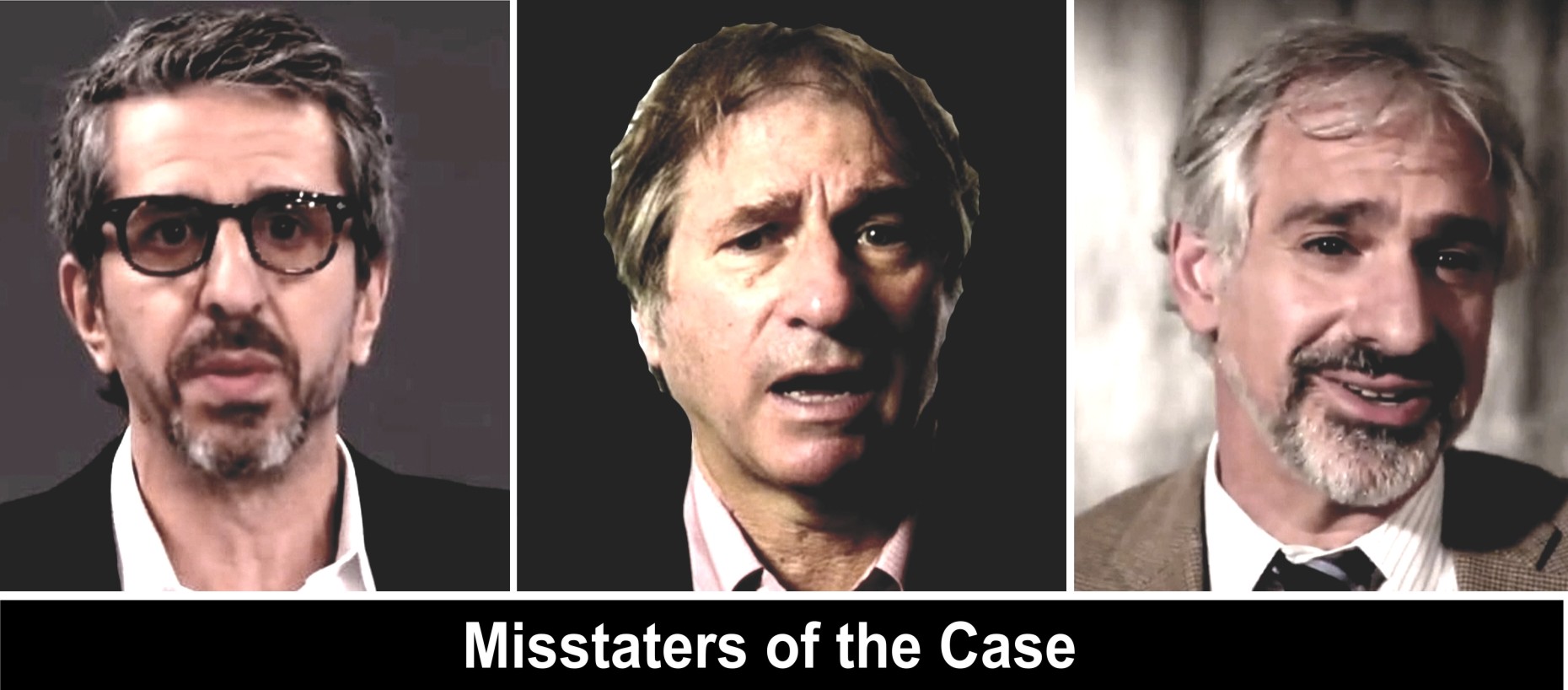
Knox enablers Jason Flom, Barry Scheck, Greg Hampikian
(Click here to go straight to Comments. Long post.)
1. What Hampikian Omits In Misleading The American Audience (1)
Think of the evidence in the case as a giant jigsaw puzzle. Say it consists of 1000 pieces.
We at TJMK and PMF and the Wiki are finally on top of nearly all of them. Thanks especially to Italy’s amazing habit of documenting and its open-process juries and our fine translators.
In the US and UK there would be few such documents. And no reasoning at all from any black-box jury. No surprise really that the Innocence Project has many cases here - and none in Italy.
Hampikian in his frenetic marketing of Knox, in sharp contrast to our full picture, leaves out pretty well everything. The previous post by KrissyG showed this for us first.
Amazingly, Hampikian revealed he is not even clued up on the full extent of the DNA.
Now in the prosecution phases of the trial back in 2009 the judges and lay-judges were presented with all 1000 pieces of the puzzle, in 20 day-long sessions (a quarter in closed court and not reported by media in detail). Also they did voluminous side-reading of the case files.
Plus of course staring at the telling Knox and Sollecito reactions for hours and hours.
Knox obviously preferred to be daffy and her version of likable, and to try to warm up a hostile Sollecito. He was obviously sulky and angry at Knox, refusing to look at her or to speak in favor of any of her alibis. Both grimly sat through the hard-to-take closed sessions.
For us and many in Italy, the case came to be a convincingly strong one about midpoint in the trial.
That was when a defiant Knox was on the stand for two days, doing herself no good, incessantly contradicting herself and causing this typical reaction and this one.
Knocked back by this, the defenses used up only a very few court days to attempt rebuttals and attempt to squeeze nice opinions out of character witnesses. Pretty well all Italy could see the defenses were outgunned, listless, and demoralized.
Back in 2008 there had been talk of RS and AK admitting to heavy drug use or psychological issues but the parents would have none of it.
So other than incessantly beating up on Guede (an easy “out” as he was not present to defend himself) it was hard for them to find things to talk about. Some court days were cancelled because of this and Sollecito lawyer Bongiorno skipped several sessions.
This all matters. It explains things. But Hampikian omits all of it in his simplistic and ridiculous bid for glory.
He misrepresents a small fraction of the DNA evidence, reveals himself ignorant of a much bigger and equally damning fraction, and ignores all other evidence as if everything other than DNA is of lower importance.
So here below from the Wiki Evidence Masterlist is all of the forensic evidence made public by the end of 2009. (Although very extensive, this is still only about 50% of all the evidence items on the Masterlist. Hampikian hid that half also.)
Again, this was all known to the jury as of the end of trial - which like any jury anywhere can convict on ONE item if it speaks guilt to them. This was the only jury to hear the whole case. The one that voted for guilt unanimously. As any American or British jury would have done.
Part 3 at bottom summarizes the damning court take and the Knox shills’ spin.
2. Forensic Evidence In The Public Realm By Late 2009
Area 1: The Wounds
11-01 Meredith Kercher sustained 43 wounds during the assault that killed her. (Perna closing arguments 2009)
1-02 She had 10 knife wounds and 33 other wounds. (Lalli 2009)
1-03 She had at least 15 bruises: on her mouth, nose, cheeks, jaw, neck, elbows, right forearm, small of her back, left thigh, and right lower leg. The bruises indicate she was not only restrained, but also kept from screaming for help. (Lalli 2009)
1-04 Some of the bruising on Ms. Kercher was in the shape of fingertips, with some fingertips being smaller, of a woman’s size. There were no ligature marks. (Lalli, Marchionni, Codispoti 2009)
1-05 Some of the neck bruises indicate Ms. Kercher was being choked at some point during the assault. (Liviero 2009)
1-06 The internal vaginal bruising suffered by Ms. Kercher happened before her death and was violent. (Lalli, Marchionni 2009)
1-07 She had only 2 major knife wounds, one on each side of her neck. The remaining knife wounds were minor. (Lalli 2009)
1-08 The wound on the right side of her neck was narrow and deep. The wound on the left side of her neck was wide, large, gaping and fatal. These two wounds were likely made with two different knives. (Bacci, Politi, Codispoti, Mignini 2009)
1-09 She had another knife cut just below the gaping wound on the left side of her neck. (Lalli 2009)
1-10 She had 3 other glancing knife wounds on her neck and cheeks. (Lalli 2009)
1-11 She had 3 small cuts on her right hand and one small cut on her left hand. (Lalli 2009)
1-12 Her defensive wounds were virtually non-existent, especially when compared with other single-attacker knife attacks, where knife wounds on the hands and arms are prevalent. (Cingolani, Codispoti 2009)
1-13 The wounds were compatible with an assault by multiple persons (Cingolani, Codispoti, Lalli, Liviero 2009).
1-14 Bacci, Lalli and Liviero testified that the wounds could not be ascribed with 100% certainty to a single person or multiple person assault. However Lalli and Liviero preferred the multiple person assault scenario, given the quantity and different types of wounds. (Bacci, Lalli, Liviero 2009)
1-15 Lalli confirmed under questioning by Judge Massei that if the rape happened during the assault, then the assault had to be carried out by more than one person. (Lalli 2009)
Area 2: The Blood traces
2-01 Blood traces were found all around Ms. Kercher’s bedroom, not in one specific area. (crime scene photos)
2-02 In Ms. Kercher’s bedroom, blood was found by the far wall, on and inside the closet, under the desk, by and under the bed, on the walls above the bed, on the mattress cover, on the floor in large quantities and on the door into the bedroom. (crime scene photos)
2-03 Blood was also found on the floor in the form of partial shoeprints leading out of the cottage. Blood traces were also found on the small bathroom door, in the small bathroom (on the light switch, sink, bidet, bathroom floor mat, etc.), possibly on a few items in Knox’s bedroom, and also in Luminol-revealed traces found on the floor in the corridor, in Knox’s bedroom and in Romanelli’s bedroom. (crime scene photos, Codispoti 2009)
2-04 No blood traces were found near, leading to or in the large bathroom where Guede defecated. (crime scene photos, Dr. Stefanoni Genetic Test report)
2-05 Blood pattern analysis indicates Ms. Kercher was fatally stabbed around 40 cm above the ground, near to the closet door. (Camana 2009)
2-06 Blood traces on the floor indicate objects were shifted or removed after Ms. Kercher had started bleeding from the fatal wound. (crime scene photos)
2-07 Ms. Kercher’s body was moved after she was stabbed, as can be seen from the blood smears on the floor. (crime scene photos)
2-08 Blood traces on the mattress cover indicate that one or more knives used in the assault were placed on the mattress cover. (Politi 2009)
2-09 Blood traces under the bed indicate someone was likely searching under the bed for something after the assault. (Codispoti 2009)
Area 3. Clothing traces
3-01 Blood was found on her sweat jacket, bra, jeans and socks. (crime scene photos)
3-02 Ms. Kercher’s bra and sweat jacket indicate she bled on the right side, likely from the knife wound on the right side of her neck, for some time before these were removed. (evidence item photos in Dr. Stefanoni’s slide presentation)
3-03 The sleeves on her sweat jacket were pulled inside-out. (Stefanoni 2009)
3-04 Blood stains on her sweat jacket and shirt indicate these were pulled up around her neck after she had been wounded. (Codispoti 2009)
3-05 Her jeans were also inside out, with blood spots inside her jeans. (Stefanoni 2009)
3-06 Her panties were found near her body, and had no blood stains. (Stefanoni 2009)
3-07 Ms. Kercher’s bra was removed after she was dead, as can be seen from blood speckles on the bra that were not found on her chest. (Micheli Motivation report, Codispoti 2009
3-08 Her body was covered with a duvet, and she only had an undershirt on. (Micheli Motivation report)
3-09 Police found a pillow, a bed sheet, a sock and two towels under her body. (Nencini Motivation Report- citing Lalli’s site report)
3-10 Guede’s bloody handprint was found on the pillow. (Sbardella 2009)
3-11 Guede’s bloody shoeprint was found on the pillow right under Ms. Kercher’s leg. (Sbardella 2009)
3-12 Police found Ms Kercher’s bra clasp under the pillow, and then later found it again under a carpet in the bedroom, 46 days after initial discovery. (Cantagalli, Codispoti, Stefanoni 2009, crime scene photos)
3-13 A sock was found around one of Ms. Kercher’s purse handles on the bed. (crime scene photos)
3-14 Ms. Kercher’s purse was found on the mattress cover, indicating it had been placed there after the duvet had been used to cover her body. (crime scene photos)
Area 4. Ms. Kercher’s room
4-01 Only the mattress cover remained on the bed. After the assault, someone removed the duvet, pillow and bed sheet from the bed, and placed Ms. Kercher on the bed sheet, two towels and pillow on the floor, then covered her body with the duvet. (Codispoti 2009, crime scene photos)
4-02 Someone took Ms. Kercher’s wallet and credit cards from her purse and placed the purse on the mattress cover on the bed. (Profazio 2009, Nencini Motivations report, crime scene photos)
4-03 Someone left receipts on the duvet covering Ms. Kercher’s body. (Codispoti 2009, crime scene photos)
4-04 Someone took Ms. Kercher’s cell phones and tossed them over a roadside wall, inadvertently into the garden of another villa, some 950 meters from the cottage. (Nencini Motivations report)
4-05 Someone took Ms. Kercher’s room and house keys. (Napoleoni 2009)
4-06 An empty jar of Vaseline was found on her desk. (crime scene photos, Napoleoni 2009)
4-07 The wall shelf by her closet had been knocked around, and objects on the shelf were tipped over. (crime scene photos, Codispoti 2009)
4-08 Ms. Kercher’s nightstand lamp and Knox’s nightstand lamp were both on the floor next to the bed. (crime scene photos)
4-09 Knox’s lamp was partially under Ms. Kercher’s bed, and it was the only functioning light Knox had in her room. (crime scene photos, Nencini Motivations report)
4-10 Someone closed and locked Ms. Kercher’s bedroom door, and took her bedroom door key. (Battistelli, Romanelli, Altieri, Zaroli, Napoleoni 2009)
4-11 Romanelli testified Ms. Kercher rarely closed and locked her own bedroom door, while Knox claimed Ms. Kercher normally locked her door. (Battistelli, Zaroli, Altieri, Romanelli 2009)
4-12 Ms. Kercher’s bedroom door had a small crack in it before it was broken down. (Altieri 2009).
Area 5: Shoeprints
5-01 Guede’s bloody left shoeprints were found in Ms. Kercher’s room.
5-02 Guede’s bloody left shoeprints were also found leading down the corridor, into the kitchen/dining room and out the front door, without any trace of prints indicating he turned to close and lock Ms. Kercher’s bedroom door.
5-03 Five different papers and cards, most smudged with blood, were found on the floor in Ms. Kercher’s room. These papers and cards had at least two different types of shoeprints which did not match any of Ms. Kercher’s shoes.
5-04 A similar card was found in Romanelli’s room, with a shoeprint not matching those on the cards and papers in Ms. Kercher’s room.
5-05 A smaller shoeprint similar to Guede’s shoe type was found on the pillow found under Ms. Kercher. Police consultants estimate this was a female sized shoe.
Area 6: Footprints
6-01 Half of a bloody footprint was found on the bathmat. The heel of this footprint, which should have been on the floor, was missing, suggesting it was cleaned away. (crime scene photos, report)
6-02 The bloody footprint matches Sollecito’s right foot size and characteristics.
6-03 Five Luminol-revealed footprints were found on the floor in the corridor and in Knox’s bedroom.
6-04 One of these Luminol-revealed footprints was compatible with Sollecito’s right foot.
6-05 Two others were compatible with Knox’s right foot.
6-06 None of the Luminol-revealed footprints were compatible with Guede’s feet.
Area 7: Fingerprints
7-01 Ms. Kercher’s fingerprints were found on Knox’s closet door.
7-02 Knox’s fingerprints were only found on a glass in the kitchen. None of her fingerprints were found in her own bedroom, or elsewhere in the cottage.
7-03 Sollecito’s fingerprints were on Ms. Kercher’s bedroom door and on the inside face of Laura Mezzetti’s door.
7-04 Guede’s fingerprint was found in Ms. Kercher’s bedroom.
Area 8: DNA testing general
8-01 227 evidence items were sampled or bagged. 30 of these were not analyzed.
8-02 From the remaining 197 evidence items, over 480 DNA and Y haplotype tests were prepared from liquids, solids or hairs. Many objects were sampled in multiple places.
8-03 Out of the over 480 DNA and Y haplotype tests, only 193 of these tests actually yielded DNA useful for comparison. (40%)
8-04 24 tests were from samples taken from Ms. Kercher’s body. Of these, 1 test yielded DNA compatible with Guede’s Y haplotype, 17 tests yielded DNA compatible with Ms. Kercher’s, and the remaining did not yield DNA useful for comparison.
8-05 11 tests were from samples taken from the exterior of the cottage. Of these, 2 tests yielded DNA compatible with an unknown female, 2 tests yielded cat DNA and the remainder did not yield useful DNA.
8-06 21 tests were from samples taken from the basement apartment at the cottage. Of these, 16 tests yielded cat blood, 2 tests yielded DNA compatible with an unknown male and the remaining did not yield DNA useful for comparison.
8-07 221 tests were from samples or items taken from the upper apartment at the cottage. Of these, 6 tests yielded DNA compatible with Guede’s DNA or Y haplotype, 82 tests yielded DNA compatible with Ms. Kercher’s DNA, 2 tests yielded DNA compatible with a mixture of Ms. Kercher’s and Guede’s DNA or Y haplotype (both tests from the same sample), 5 tests from 5 different samples yielded DNA compatible with a mixture of Ms. Kercher’s and Knox’s DNA, 2 tests yielded DNA compatible with a mixture of Ms. Kercher’s and Sollecito’s DNA or Y haplotype (both tests from the same sample), 4 tests yielded DNA compatible with Knox’s DNA, 1 test yielded DNA compatible with a mixture of Knox’s and Sollecito’s DNA, 2 tests yielded DNA compatible with an unknown female, 3 tests yielded DNA compatible with an unknown male and the remaining did not yield DNA useful for comparison.
8-08 4 tests were from samples taken (from bloodied tissue papers) found in the vicinity of the cottage, yielding DNA compatible with an unknown male or an unknown female.
8-09 16 tests were from samples taken from Sollecito’s car and no DNA useful for comparison was found.
8-10 102 tests were from samples taken from Sollecito’s apartment. Of these, 1 test yielded DNA compatible with Ms. Kercher’s DNA, 6 tests yielded DNA compatible only with Knox’s DNA, 7 tests yielded DNA compatible with a combination of Knox and Sollecito’s DNA, 7 tests yielded DNA compatible only with Sollecito’s DNA, 3 tests yielded DNA of 3 unknown males and the remaining did not yield DNA useful for comparison.
8-11 29 tests were from samples taken from Guede’s apartment. Of these, 14 tests yielded DNA compatible with Guede’s DNA and the remaining did not yield DNA useful for comparison.
8-12 6 tests were from samples taken from the pub Le Chic and no DNA useful for comparison was found.
8-13 50 tests were from samples taken from the defendants or defendant’s items during arrests or likely at the police station. Of these, 6 tests yielded DNA compatible only with Guede’s DNA, 8 tests yielded DNA compatible only with Knox’s DNA, 1 test yielded DNA compatible with a combination of Knox and Sollecito’s DNA, 2 tests yielded DNA compatible only with Lumumba’s DNA, 4 tests yielded DNA compatible only with Sollecito’s DNA, 1 test yielded DNA of an unknown male and the remaining did not yield DNA useful for comparison.
8-14 Of the 82 tests yielding DNA compatible with Ms. Kercher’s DNA at the cottage, 4 samples were taken from the corridor floor, 5 were taken from the kitchen/dining floor, 66 were taken from Ms. Kercher’s room and clothing, 1 was taken from the floor in Romanelli’s room and 6 were taken from the small bathroom.
8-15 17 tests yielded unmatchable DNA, with 6 tests yielding DNA compatible with 3 different females and 11 tests yielded DNA compatible with 7 different males. 13 of these samples were found in tissue paper outside the cottage and on cigarette butts in the ashtray in the cottage kitchen.
Area 9: DNA testing- specific
9-01 Ms. Kercher’s DNA was found on the kitchen knife at Sollecito’s apartment. Her DNA was found in a groove towards the cutting edge of the blade. The grove is part of a series of noticeable scratches running parallel along the blade.
9-02 Knox’s DNA was found on the top of the handle of the same knife.
9-03 A second sample of Knox’s DNA was also found on the same knife, where the blade goes into the handle. This second sample was an LCN sample of mixed DNA, and was statistically determined to be Knox’s DNA. (RIS Berti & Barni 2013 report)
9-04 DNA mixture compatible with Knox’s and Sollecito’s DNA was found on another stained pocket knife that Sollecito had.
9-05 DNA mixture compatible with Knox’s and Sollecito’s DNA was found on a cigarette butt in the cottage kitchen. Except for the bra clasp, no other samples at the cottage yielded Sollecito’s DNA.
9-06 7 samples yielded DNA mixtures compatible with Ms. Kercher’s DNA mixed with either Knox’s DNA, Sollecito’s DNA or Guede’s DNA.
9-07 DNA mixture compatible with Ms. Kercher’s DNA and Sollecito’s DNA was found on the metal bra clasp. Sollecito’s Y haplotype was also on the metal bra clasp.
9-08 DNA mixture compatible with Ms. Kercher’s DNA and Guede’s DNA was found on Ms. Kercher’s purse near the zipper.
9-09 DNA mixture compatible with Ms. Kercher’s DNA and Knox’s DNA was found in three blood traces in the bathroom- on the bidet drain plate, in the sink and on a plastic container containing cotton swabs.
9-10 DNA mixture compatible with Ms. Kercher’s DNA and Knox’s DNA was also found in a Luminol-revealed blood stain on the floor of Romanelli’s room, and in a Luminol-revealed bloody footprint in the corridor.
9-11 A second Luminol-revealed blood stain in Romanelli’s room yielded Ms. Kercher’s DNA.
9-12 A sample of blood from the small bathroom faucet yielded ONLY Knox’s DNA.
9-13 Guede’s DNA was found on Ms. Kercher’s purse, the left sleeve of her sweat jacket, her bra strap, in Ms. Kercher and on the toilet paper in the large bathroom.
Area 10. Other biological traces
10-01 3 samples of presumed blood traces were found in Knox’s bedroom, on a pillow, on the night stand and on the wall by the head of the bed.
10-02 No semen was found in Ms. Kercher.
10-03 Guede left his feces in the toilet in the large bathroom.
10-04 3 fragments of toilet paper were found on Ms. Kercher’s desk; all three yielded DNA compatible with Ms. Kercher’s DNA.
10-05 2 tissue papers were found in Sollecito’s bedroom; both had blood that yielded DNA compatible with Sollecito’s DNA.
10-06 A glass on Ms. Kercher’s night stand yielded DNA compatible with Ms. Kercher’s DNA.
10-07 A strand of hair and a trace of blood were found on Romanelli’s window frame. The blood trace did not yield human DNA; the hair color was dark chestnut.
10-08 5 samples of blood traces on a towel and faucet in Guede’s bathroom all yielded Guede’s DNA.
10-09 4 samples of blood stains on Guede’s jeans and a museum ticket in his jeans also yielded Guede’s DNA.
10-10 The range of digestive timing is, under normal circumstances, 3-5 hours. This range could easily be expanded depending on any number of factors, including stress and alcohol, both of which slow digestion. (Ronchi 2009)
10-11 Based on body temperatures and the digestive process, the time of death range was estimated between 20:00 of November 1st and 04:00 of November 2nd, with the probability that the time of death occurred around 23:00 of November 1st. (Lalli 2009)
Area 11. Luminol traces
11-01 1 sample of a Luminol-revealed blood trace was taken from Guede’s apartment.
11-02 9 samples of Luminol-revealed blood traces were taken from the cottage, including Knox’s room, the corridor and Romanelli’s room.
11-03 Knox’s and Ms. Kercher’s DNA was found on the Luminol-revealed blood stain in Romanelli’s room.
11-04 Knox’s and Ms. Kercher’s DNA was found mixed in a Luminol-revealed bloody right footprint in the corridor.
11-05 14 samples of Luminol-revealed blood traces were taken from Sollecito’s apartment.
11-06 6 samples were taken from Sollecito’s bathroom, including the door, floor and shower basin.
11-07 3 samples were taken from Sollecito’s bedroom, including the door and floor.
11-08 5 samples were taken from the floor of Sollecito’s kitchen.
11-09 2 of the Luminol-revealed samples taken from Sollecito’s apartment yielded DNA compatible with a mixture of Sollecito’s and Knox’s DNA. 1 sample yielded DNA compatible with Knox’s DNA.
11-10 1 sample yielded an unknown male’s DNA (unmatchable).
Area 12: Hairs
12-01 Of the over 480 tests prepared on samples, 93 of these constituted hairs or fibers. 86 were human hairs of varying length, in varying colors. The most significant colors noted were black, blonde, chestnut, light chestnut and red chestnut.
12-02 Only 3 hairs yielded DNA; all 3 hairs yielded DNA compatible with Ms. Kercher’s DNA. All 3 hairs were chestnut colored and over 15 cm long.
12-03 35 hairs were chestnut in color; the vast majority of these were found in Ms. Kercher’s room. 2 were also found on a kitchen sponge at Sollecito’s apartment.
12-04 7 hairs were black in color. 6 of these were 4 cm long or less, and so likely Guede’s hair. 4 of these were on the duvet and 1 was on the mattress cover, both in Ms. Kercher’s room. 1 was also on a sponge at Sollecito’s apartment.
12-05 21 blonde hairs were analyzed, and were likely Knox’s hairs. Most were found at Sollecito’s apartment, 10 on a sponge in the kitchen and 5 on a sweater.
12-06 Of the 6 blonde hairs found at the cottage, 2 were on the duvet, 1 was inside the small bathroom sink, 1 was on Ms. Kercher’s purse and 1 was on her mattress cover.
12-07 4 light chestnut hairs were found. 3 of these were 9 cm long or less. 1 was found on the kitchen sponge; 1 was found on the bra and one was found on Ms. Kercher’s sweat jacket. Sollecito had light chestnut colored hair.
3. Court Assessment & Knox Spin
Judge Micheli was the first judge to make something of all this evidence, late in 2008. Unsurprisingly, if one has actually studied it, one of his major findings was this.
The pack attack, and the crime-scene rearrangement. Led by Knox. She could have escaped trial right there by rebutting it. But she and her team had pretty well zero comeback.
Oh, Hampikian, you didn’t know that?!
The “counter-case” of Hampikian, and other such shills of the PR campaign as Heavey, Fischer, Douglas, and Moore, is like a three-legged stool, with all the rest of the case simply ignored.
- One leg is the Interrogation Hoax and we have shown in 20 posts that Knox always lied about that.
- One leg is the supposedly “flawed” DNA analysis that actually wasn’t, which KrissyG took first new whack at last week.
- The third leg is that there was no pack attack and that Guede somehow did all of the above on his own.
Including taking off a shoe to make ONE imprint in blood on the bathmat in a footprint several sizes smaller than his own…
On Planet Earth, nobody has ever come close to making all of the above fit a Lone Wolf. The defenses only listlessly went through the motions when they tried. Then they seized on Alessi and Aviello when they came along.
That was the defenses proving a pack attack!!
4. Tip for IP contributors
On Amanda Knox. Innocence Project Idaho rep Hampikian’s ONLY achievement was to be main cause of annulment of 2011 appeal, to anger of defense counsel. Thus he subjected Knox and RS to much tougher appeal, leading to desperate measures to bend Supreme Court. Thus Hampikian directly caused mafia involvement that Knox and RS must hide for life.
5. Next post in this series.
Click for Post: Innocence Project: Seven Years Clutching Knox And Trashing Italian Justice To Joy Of Mafias #4
Innocence Project: Seven Years Clutching Knox And Trashing Italian Justice To Joy Of Mafias #4
Posted by Our Main Posters

One of two Sollecito footprints matching in EXACT dimensions
1. What Hampikian Omits In Misleading The American Audience (2)
Hampikian’s illegal nonsense on the DNA in the case is quite obviously worse than useless.
It actually came to HURT the defenses rather than helped them, and drew the mafias in (see Part 2 below). Do please feel free to purge your mind of it, and take in our forensic Powerpoints.
Click each image below, and keep clicking.
1. DNA: A Very Clear Intro To A Vital Subject By Nicki
2. DNA Evidence May Be A Tough Mole To Whack By Nicki
3 Telling Forensic Evidence Against Sollecito By Kermit
4. How Pro-Knox Mafia Tools Doctored A Sollecito Footprint By Kermit
5. Total Evidence Suggests AK & RS Guilty By James Raper w/Kermit
2. Tip For IP Contributors
On Amanda Knox. Innocence Project Idaho rep Hampikian’s ONLY achievement was to be main cause of annulment of 2011 appeal, to anger of defense counsel. Thus he subjected Knox and RS to much tougher appeal, leading to desperate measures to bend Supreme Court. Thus Hampikian directly caused mafia involvement that Knox and RS must hide for life.
5. Next post in this series.
Click for Post: Innocence Project: Seven Years Clutching Knox And Trashing Italian Justice To Joy Of Mafias #5
Innocence Project: Seven Years Clutching Knox And Trashing Italian Justice To Joy Of Mafias #5
Posted by Our Main Posters
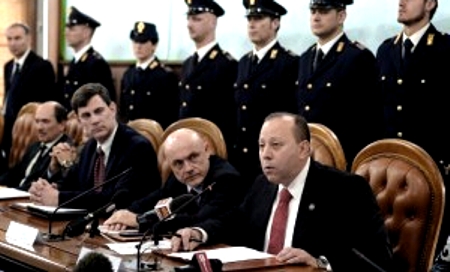
Joint press conference of American and Italian prosecutors
1. Perverse Denigration Of Italian Justice
The stance of Barry Scheck’s Innocence Project on Amanda Knox is not only opportunistic and dishonest. It is perverse in terms of their main mission.
We don’t approve of their broad-brush undermining of forensic science. Statistics show that forensic science has made quantum advances since most of their cases were sent to prison, and these days very few new cases of bent science are showing up. The CSI Effect is a defense device not based on current reality.
But we do approve of any highlighting of how the American system rains massive unfairness, such as the huge tilt toward plea-bargaining by hard-line and mostly elected prosecutors (in Italy only highly-trained career judges can enter into their restrained form of plea-bargaining) and to push for much-needed reforms. And of any learning from other, better, justice systems.
They are not too far down the road on the latter, but seem sincere about it - and there is a great deal that they could learn from Italy.
So the Innocence Project’s incessant use of Amanda Knox, a FAKE exoneree who for big bucks is demonizing perhaps the world’s FAIREST system, is not helpful to either the Italian or American situations.
Here below from our numerous comparison posts are some that highlight the many pluses and several minuses of the Italian justice system.
In essence: it is an extremely effective system. it is widely respected by competent counterparts (as contrasted with the wildly incompetent Steve Moore, Michael Heavey, and so on), it works very closely with the FBI and exchanges officers, it keeps Italian crime at a very low level, it very bravely takes on the mafias despite over 100 assasinations, and it gives an exceptional list of breaks to perpetrators. Recidivisms - repeat crimes - are among the world’s lowest.
2. Main Pluses And Minuses Of The Italian Justice System
1. Plus: Italy Has Little Crime, Few Murders, Small Prison Population
Click for Post: Compared To Italy, Say, Precisely How Wicked Is The United States?
2. Plus: The Well-Trained Well-Equipped Italian Police Are Also Well-Liked
Click for Post: Italian Police Long Known As Among Europe’s Coolest, Now Also Being Remarked Upon As”¦
3. Plus: Italian Cops, Judges, Labs Work Exceptionally Closely With US’s FBI
Click for Post: FBI Reporting Close Co-operation With Italy In Arresting And Soon Extraditing A Fugitive Swindler
4. Plus: Italy And United States Cooperate Daily On Effecting Extraditions
Click for Post: Italian Justice & The Telling Status Of Extraditions To And From Italy
5. Plus: Italy Has Implemented Perhaps World’s Best Anti-Terrorism System
Click for Post: Counterterrorism: Another Way Italian Law Enforcement Is An Effective Model For Everywhere Else
6. Plus: The Career Prosecutors Are Well-Trained, Straight, Very Hard to Bend
Click for Post: Why The Italian Judiciary’s Probably Less Prone to Pressure Than Any Other In The World
7. Plus: Those Charged Get Repeated Chances To Walk Free Before Trial
Click for Post: “They Were Held For A Year Without Even Being Charged!!” How Italian Justice REALLY Works
8. Plus: The Courts Take Reasonable Doubt At Trials Very, Very Seriously
Click for Post: Reasonable Doubt In Italian Law: How Sollecito, Hellmann, And Zanetti Seriously Garbled It.
9. Plus: The Appeal System Is Ponderous But Its Fairness Exceptional
Click for Post: How The Italian Appeals Process Works And Why It Consumes So Much Time
10. Plus: The Italian System Learns Fast And Seeks Incessantly To Improve
Click for Post: Meredith May Not See Justice (Yet) But She Will Leave At Least Three Legacies
11. Minus: Mafias And Corrupt Politicians Have Somewhat Bent a Good System
Click for Post: Trashing Of Italian Justice To Bend Trial Outcomes And How The Republic Pushes Back
12. Minus: The System Is So Fair To Perps, Victim’s Families Can Suffer Terribly
Click for Post: The Terrible Weight On The Victim’s Family Because The Italian System Is So Very, Very Pro Defendant
13. Plus: Still, A Fine System Continuously Improving, Already Good As A Global Model
Click for Post: Italian Justice: Describing A Fine System And How To Improve It
14. Plus: And The System Really Has Gone The Extra Mile In Meredith’s Case
Click for Post: From Shortly Before Last December’s Verdict: Our Poster Hopeful’s Moving Tribute To Italian Justice
3. Final post in this series.
Click for Post: Innocence Project: Seven Years Clutching Knox And Trashing Italian Justice To Joy Of Mafias #6
Innocence Project: Seven Years Clutching Knox And Trashing Italian Justice To Joy Of Mafias #6
Posted by Our Main Posters

Right: Ryan Ferguson, a REAL exoneree, to present at IP Kansas City fundraiser
1. Innocence Project Dishonesties Posts #1 To #6
1. Click for Post: #1 Jason From’s Absurdly Ill-Informed Interview With Knox.
2. Click for Post: #2 Hampikian Illegally & Incompetently Interfered On DNA
3. Click for Post: #3 Overwhelming Forensic Evidence Against Knox #1
4. Click for Post: #4 Overwhelming Forensic Evidence Against Knox #2
5. Click for Post: #5 Stop Knocking Italian Justice, And Learn From It
6. Click for Post: #6 REAL Exonerees: Knox Falsely Claims To Be One Too
2. To REAL Exonerees: Knox Falsely Claims She Is One Of You
At this week’s gala the Midwest Innocence Project is seriously misleading its sponsors and real exonerees about Amanda Knox.
Amazing that Tricia Bushnell and her Midwest staff are having Knox present yet more dangerous anti-Italy trashing in the keynote speech. For starters, Knox is not even an exoneree! That was NOT her final status.
And there’s more. We previously explained how Knox is walking free when she should not be, and how the Innocence Project and the mafias illegally interfered in the judicial process.
And how the Innocence Project has been ferociously touting Knox with zero serious questioning for seven years now.
3. What Knox Will Seek To Convince You
If Knox is true to form, she will attempt to convince you that she is one of you, for two reasons, both of them untrue: (1) that her four years in prison should not have been; and (2) that her conditions in prison were at least as nasty as yours were.
Out of a possible 200-plus reports here that go toward disproving these claims, we are linking below to 25 of the most telling.
4. Knox’s Four Year In Prison? Fully Justified
Knox’s four years in Capanne Prison outside Perugia (for which tellingly she is not suing for compensation) consisted of:
(1) a year in 2007-08 during which she was repeatedly given chances to convince courts, up to and including the Supreme Court, in the face of ever-mounting evidence described in previous posts, that she should make bail or house arrest or be released entirely. She failed at all of them (oh, she didn’t tell you?)
(2) a three-year sentence for spontaneously and without provocation framing an innocent man for murder; the Supreme Court has ruled that her appeals are all exhausted, the European Court of Human Rights will therefore not touch it, and so Knox is a convicted felon for life (oh, she didnt tell you?).
5. Knox’s Nasty Experiences In Prison? All Mythical
1. First, note conditions in American prisons.
We have posted most recently on the extraordinary fact that an estimated 200,000-plus are there only because they were frightened into a plea-bargain. (Despite the hullaballoo, those released with Innocence Project help are only a small fraction of one percent of that.)
1. Click for Post: Why Italy Doesnt Look For Foreign Guidance On Its Justice System.
2. Click for Post: The Vital Context Of A Genuine, Huge US Justice Problem.
3. Click for Post: More On A Genuine, Huge Justice Problem In The US
4. Click for Post: Yet More On A Genuine US Justice Problem.
2. Now note the contrast of Italian prisons.
The prisons Knox and IP maliciously trash include some of the most modern and humane in the world - Knox even had a bathroom, kitchen and TV in her cell, she was able to wander around the prison pretty freely, and she was given a job and attended concerts.
5. Click for Post: A Famous Black Widow Confirms Italian Prisons Are Pretty Nice
6. Click for Post: NY Times Describes How Italy Leads The World In Rehabilitation
7. Click for Post: With Not Many Prisons Italy Decides To Build More
8. Click for Post: “Human Rights Watch” Gives An Approving Nod To Italy
9. Click for Post: Italy’s Advanced, Effective System Adopted By City Of New York
3. Knox had numerous ways to complain
Knox had direct access to the media, and Sollecito actually ran a blog from prison. She could write letters and make phone calls. Her family visited her at least weekly when they were in Perugia. Her lawyers visited her at least weekly.
Also an Italian MP, Rocco Girlanda, made several dozen visits to “monitor her conditions”. And an American Embassy staffer checked upon her conditions every month and reported them to the State Department.
What actually happened? Knox reported NO complaints. Nor did her parents. Nor her lawyers. Nor the Italian MP. Nor the US Rome Embassy staffers. Italian lawyers under law MUST pass on complaints of ill-treatment from clients, so the fact that they didn’t is very telling.
10. Click for Post: State Department Monitored Knox 2007-11; Reported Fine
4. The HIV complaint? A defense trick
Knox was checked out medically on arrival in prison. An HIV test returned a false positive. She was told not to worry as this is not uncommon, and a second test was negative. There was nothing malicious about this and neither prosecution nor prison staff leaked to media.
11. Click for Post: Felony Charge Of HIV Leak Was From Knox Defense-Team.
5. Knox herself did raise eyebrows in prison
Media were essentially benign while Knox was inside and she used them often to seek support. They actually showed her having good times. But staff and cellmates saw a darker aspect suggesting all was not well. Her hygiene issues came up again. She was under incessant pressure from Sollecito, who never confirmed any of her alibis in court.
12. Click for Post: Much-Admired Feminist On Knox As Ice-Cold In Capanne.
13. Click for Post: The Hands Of Time Video With Screenplay By Amanda Knox.
14. Click for Post: The Milestone Book By Dr Hodges On Knox’s Driving Psychology.
6. Knox’s 2013 book explodes with surprise charges
Knox’s book was published after the Nencini appeal court confirmed her guilt. Desperation was setting in. It was her first blast against Italy for her prison term and it sure conned a lot of Americans. As Knox finds it harder and harder to maintain the interrogation hoax and the false-confession hoax, she falls back on the nasty-prison hoax more and more despite strong proof she was treated well.
15. Click for Post: Knox’s Smear-All Revenge Book #3
16. Click for Post: Knox’s Smear-All Revenge Book #4
17. Click for Post: Knox’s Smear-All Revenge Book #6
18. Click for Post: Knox’s Smear-All Revenge Book #9
19. Click for Post: Knox’s Smear-All Revenge Book #11
Plus many shown to be stabbed in the back by Knox in the demonization series were in Capanne.
7. Italy reacts to Knox’s malicious claims negatively
The book was withdrawn at the last moment from publication in Italian in Italy in 2013. Why? Because the publishers’ lawyers considered it highly defamatory. Italian reactions are to the English language version and to long excerpts in the weekly Oggi (see part 8 below).
20. Click for Post: In Italy Knox’s Malicious Demonizations Spark Anger
21. Click for Post: Book Claims About Prison Contradicted By Many Sources
22. Click for Post: Good Reporters Surface Amanda Knox’s False Claims In Droves
23. Click for Post: Callous Attacker Who Smirked At Trial Turns Into A Whiny Victim
8. Oggi lost in court for republishing Knox claims
The Italian weekly tabloid has a kind of a pro-mafia anti-justice slant and delights in showing justice officials up. It was the only publication in Italy to translate lurid passages from Knox’s book and it lost in court for this. The passages are rebutted in the second post.
24. Click for Post: (1) The Knox Article Oggi Is Now Charged For 1
25. Click for Post: (2) The Oggi Article: Our Claim By Claim Rebuttal
26. Click for Post: Diffamazione Complaint Against False Claims In Oggi Article
6. And Knox’s Biggest Hoax Of Real Exonerees?
Fake exoneree Knox is not out of the woods on this matter. Recently Sollecito faced charges in a Florence court for defamations in his book - and he lost. The Statute of Limitations on the myriad defamations in Knox’s book has several years to run still.
27. Click for Post: Sollecito Loses Supreme Court Appeal On $0.55M Damages Claim
7. Afterthought
Knox may have gained backing from a foolish IP but at a high price and a great risk for both. Many despise her, especially those dozens she has defamed. She would be given no peace if she visited Italy. She has lost all prospect of any reversal via the ECHR “appeal” and all prospect of any compensation for “false” imprisonment. And the black mafia cloud over her grows larger. Thanks not least to Sollecito’s dead uncle.
For those still in the process of clicking through, this is the Breaking News box that sat at the top for the past several days.
8 Breaking News Box Of Past Few Days
Breaking news. There seems deliberate intent to make Thursday night IP fundraiser in Kansas City with Amanda Knox all but invisible to the press. This might explain that. Quick reads: (1) On why Knox was rightly in prison and was not exonerated. (2) On Knox’s real experiences in prison, by witnesses and Knox herself. (3) And much more.
Heads-up to Innocence Project Attendees In Modena Italy
Posted by Our Main Posters
Please be aware that Amanda Knox
(1) does immense damage INFLAMING BIGOTRY against Italy,
(2) is a CONVICTED FELON for criminal slander, and was rightly imprisoned for 3 years,
(3) was NOT EXONERATED by Cassazione for murder,
(4) LIED ON GRAND SCALE to media, who ROLLED OVER for her,
(5) may be ARRESTED for contempt of Cassazione as E100,000 damages to Lumumba is STILL NOT PAID.
WHY Are The Corrupt Innocence Project & The Serial Italy Defamer Knox Associating? Explained.
Posted by Our Main Posters

The organizer mafia poodle Martina Cagossi seems to be in love with a false Knox
1. The Corrupt US Innocence Project
Watch out, Italy. In the US the Innocence Project (IP) has long been controversial.
It costs taxpayers many millions of dollars, it has been involved in a number of scandals, it undermines correct public perceptions of justice, it lowers law enforcement morale, and so naturally it is the mafias’ dream puppet.
The American IP has really become a huge and greedy cash-cow. Innocence and justice and other noble aims (except for its deliberately addled donors) are not really what it is about.
We looked at the IP deeply last year (see Part 4 below) because for the fourth or fifth time Amanda Knox was made a main keynote speaker and a big draw at the annual meeting.
Knox is in fact brought in to lie about Italy and her case, to generate a lot of heat, and to addle the IP donors into contributing big-time.
Are American pro-justice donors being asked by the IP to do the best for the US prison population as a whole? It seems quite the opposite.
We have long shown here that, contrary to Italy’s, the US’s justice system really is quite broken. One appalling result is that its prison population is proportionally six times that of Italy.
There are many aspects to why this is so, including the elections or political appointments of most judges and prosecutors (Italy’s are almost all career-path) which tends “justice” toward a very hard line for the accused in police handling, plea-bargains, and court (very few cases even make it to court).
Get this. There are an estimated 200,000 innocents now in American prisons who are there because they had the living daylights scared out of them by police and prosecutors. And so they accepted a plea bargain (meaning no expensive trial) in exchange for a lighter sentence than was threatened.
Some effort now goes into winding this back, but it is a long slow job - and the controversial Innocence Project (IP) is of no help at all. Instead the IP concentrates on freeing prisoners whose innocence can now be proved via modern methods for analysing DNA.
In 25 or so years the Innocence Project has freed a mere 360 or so prisoners! This is a drop in the bucket compared to the 200,000 prisoners we mentioned above.
The IP teams then go on to sue the government (meaning taxpayers) for false imprisonment. These suits often result in huge payouts (usually millions of dollars) out of which the lawyers and DNA experts associated with the Innocence Project take large cuts.
This shakedown is very, very expensive for American taxpayers - who instead could be given a huge financial benefit and vastly better justice if the costly prison system could be made to release those 200,000.
Could Italy, with its extremely careful justice system and humane prisons, really need this giant shakedown system at all?
Forever putting a black cloud over Italian police and prosecutors and judges and making their tough work even more-so?
Do think about it, Italy!
2. Overviews Of Italian Justice
1. Click for Post: How Italian Justice REALLY Works
2. Click for Post: Italian Judiciary’s Probably Less Prone to Pressure Than Any In World
3. Click for Post: Italy’s Advanced, Humane Law & Order System Adopted By New York
4. Click for Post: Unpopular Politicians & Mafia Poodles Versus Popular Justice System
5. Click for Post: Why Italy Doesnt Look For Guidance On Justice From Smartasses Abroad
3. Overviews Of American Justice
1. Click for Post: Compared To Italy, Say, Precisely How Wicked Is The United States?
2. Click for Post: Why Numerous American JUDGES Favor Italy’s Kind Of System
3. Click for Post: US Justice System Reform Is Suddenly Everywhere On The Front Burner
4. Click for Post: Where Are Heavey, Moore & Fischer When US Justice Has REAL Issues?
5. Click for Post: So Where Would YOU Want To Go On Trial? In Italy Or In The U.S.?
4. The Corrupt American IP and Knox
1. Click for Post: Seven Years Of IP Trashing Italian Justice To Joy Of Mafias #1
2. Click for Post: Seven Years Of IP Trashing Italian Justice To Joy Of Mafias #2
3. Click for Post: Seven Years Of IP Trashing Italian Justice To Joy Of Mafias #3
4. Click for Post: Seven Years Of IP Trashing Italian Justice To Joy Of Mafias #4
5. Click for Post: Seven Years Of IP Trashing Italian Justice To Joy Of Mafias #5
6. Click for Post: Seven Years Of IP Trashing Italian Justice To Joy Of Mafias #6
Hoax: To Modena’s La Pressa Innocence Project - Knox NOT An “Exoneree”
Posted by Machiavelli
1. Knox Definitely Not Exonerated By Cassazione
Knox again and again claims “exoneration” and blames the media for getting it wrong.
But few in the US and UK realise the final written Supreme Court judgment left a huge black cloud over her head.
Duped organizer Professor Luparia claims to reporters to have read the entire report - and that Knox came out fine.
Untrue. In fact, Luparia lies. Knox rightly served three years. And even Cassazione’s Fifth Chambers managed to get in many digs against Knox.
Commendably Modena’s paper “La Pressa” has today tried to at least set some Italians right.
We have translated in full their excellent report.
La Pressa, Modena
Knox returns as ‘heroine’ to Italy
But here’s what the Marasca/Bruno motivation report says
Date: 12 June 2019 - 22:38 / Category: La Nera
Author: Editorial La Pressa
This is the first time Amanda Knox returns to Italy after acquittal of murder for lack of evidence.
We are reporting here very controversial but not widely known passages of the 2015 Cassazione sentence
Tomorrow the long-awaited Criminal Justice Festival begins in Modena. A festival promoted by the Criminal Chamber of Modena together with the Italy Innocence Project and which has had national and international importance for the Saturday presence of Amanda Knox who will address the topic of the ‘Media And Criminal Trials’ together with the lawyer Guido Sola, Raffaella Calandra, Andrea Mascherin, Vinicio Nardo and Martina Cogossi.
This is the first time after 8 years that Amanda Knox returns to Italy after being acquitted in 2015 for the murder of Meredith Kercher with the sentence of the Fifth Criminal Chambers of Cassation signed by the Court president Gennaro Marasca and by the rapporteur Paolo Antonio Bruno. With that declaration the sentences of Raffaele Sollecito and Knox were canceled without referral [back down to Florence, the correct legal path], absolving them for not having committed the crime due to a lack of certain evidence and the presence of numerous errors in the investigations.
As an acquittal sentence that closed the case, so, on the eve of Knox’s return to Italy, we wanted to reread in its entirety and it deserves to be included in the conversation, however controversial the 52 pages of motivation are. Here are seven passages that we want to reproduce in full with the original pages of the sentence, perhaps never published in its entirety before.
1. It is an established fact, in the [2010] trial motivation report, that Knox was in Meredith’s home at the time of the murder.
9.4.1 Given this, we now note, with respect to Amanda Knox, that her presence inside the house, the location of the murder, is a proven fact in the trial, in accord with her own admissions, also contained in the memoriale with her signature, in the part where she tells that, as she was in the kitchen, while the young English woman had retired inside the room of same Ms. Kercher together with another person for a sexual intercourse, she heard a harrowing scream from her friend, so piercing and unbearable that she let herself down squatting on the floor, covering her ears tight with her hands in order not to hear more of it. About this, the judgment of reliability expressed by the lower [a quo] judge [Nencini, ed.] with reference to this part of the suspect’s narrative, [and] about the plausible implication from the fact herself was the first person mentioning for the first time a possible sexual motive for the murder,
2. Knox was present, because she was aware of details of the murder that the police did not yet know, and she was also aware of the non-presence of Lumumba.
[continues] a possible sexual motive for the murder, at the time when the detectives still did not have the results from the cadaver examination, nor the autopsy report, nor the witnesses’ information, which was collected only subsequently, about the victim’s terrible scream and about the time when it was heard (witnesses Nara Capezzali, Antonella Monacchia and others), is certainly to be subscribed to. We make reference in particular to those declarations that the current appellant [Knox] produced on 11. 6. 2007 (p.96) inside the State Police headquarters. On the other hand, in the slanderous declarations against Lumumba, which earned her a conviction, the status of which is now protected as final judgement [giudicato], [they] had themselves exactly that premise in the narrative, that is: the presence of the young American woman inside the house in via della Pergola, a circumstance which nobody at that time – except obviously the other people present inside the house – could have known (quote p. 96).
According to the slanderous statements of Ms. Knox, she had returned home in the company of Lumumba, who she had met by chance in Piazza Grimana, and when Ms. Kercher arrived in the house, Knox’s companion directed sexual attentions toward the young English woman, then he went together with her in her room, from which the harrowing scream came. So, it was Lumumba who killed Meredith and she could affirm this since she was on the scene of crime herself, albeit in another room.
Another element against her is the mixed DNA traces, her and the victim’s one, in the “small bathroom”, an eloquent proof that anyway she had come into contact with the blood of the latter, which she tried to wash away from herself (it was, it seems, diluted blood, while the biological traces belonging to her would be the consequence of epithelial rubbing).
The fact is very suspicious, but it’s not decisive, besides the known considerations about the sure nature and attribution of the traces in question.
Nonetheless, even if we deem the attribution certain, the trial element would not be unequivocal, since it may show also a posthumous touching of that blood, during the probable attempt of removing the most visible traces of what had happened, maybe to help cover up for someone or to steer away suspicion from herself, but not contributing to full certainty about her direct involvement in the murderous action. Any further and more pertaining interpretation in fact would be anyway resisted by the circumstance – this is decisive indeed – that no trace linkable to her was found on the scene of crime or on the victim’s body, so it follows – if we concede everything – that her contact with the victim’s blood happened in a subsequent moment and in another room of the house.
Another element against her is certainly constituted by the false accusations [calunnia] against Mr. Lumumba, afore-mentioned above.
It is not understandable, in fact, what reason could have driven the young woman to produce such serious accusations. The theory that she did so in order to escape psychological pressure from detectives seems extremely fragile, given that the woman…
3. In the [2010] trial motivation it is ‘incontrovertible’ that other people participated in the murder besides Guede (we recollect the condemned man with the abbreviated trial route). And this derives not only from the final judgment on Guede but from ‘other evidence that confirms its reliability’.
Based on such provision “(…) the verdicts [p. 26] that have become irrevocable can be accepted [acquired] by courts as pieces of evidence of facts that were ascertained within them and evaluated based on articles 187 and 192 par 3”.
Well, so the “fact” that was ascertained within that verdict, indisputably, is Guede’s participation in the murder “concurring with other people, who remain unknown”. The invoking of the procedural norms indicated means that the usability of such fact-finding is subordinate to [depends on] the double conditions [possibility] to reconcile such fact within the scope of the “object of proof” which is relevant to the current judgement, and on the existence of further pieces of evidence to confirm its reliability.
Such double verification, in the current case, has an abundantly positive outcome. In fact it is manifestly evident that such fact, which was ascertained elsewhere [aliunde], relates to the object of cognition of the current judgement. The [court’s] assessment of it, in accord with other trial findings which are valuable to confirm its reliability, is equally correct. We refer to the multiple elements, linked to the overall reconstruction of events, which rule out that Guede could have acted alone. Firstly, testifying in this direction are the two main wounds (actually three) observed on the victim’s neck, on each side, with a diversified path and features, attributable most likely (even if the data is contested by the defense) to two different cutting weapons. And also, the lack of signs of resistance by the young woman, since no traces of the assailant were found under her nails, and there is no evidence elsewhere [aliunde] of any desperate attempt to oppose the aggressor; the bruises on her upper limbs and those on mandibular area and lips (likely the result of forcible hand action of constraint meant to keep the victim’s mouth shut) found during the cadaver examination, and above all, the appalling modalities of the murder, which were not adequately pointed out in the appealed ruling.
And in fact, the same ruling (p. 323 and 325) reports of abundant blood spatters found on the right door of the wardrobe located inside Kercher’s room, about 50 cm above the floor. Such occurrence, given the location and direction of the drops, could probably lead to the conclusion that the young woman had her throat literally “slashed” likely as she was kneeling, while her head was being forcibly held [hold] tilted towards the floor, at a close distance from the wardrobe, when she was hit by multiple stab wounds at her neck, one of which – the one inflicted on the left side of her neck – caused her death, due to asphyxia following [to] the massive bleeding, which also filled the breathing ways preventing breathing activity, a situation aggravated by the rupture of the hyoid bone – this also linkable to the blade action – with consequent dyspnoea” (p. 48).
Such a mechanical action is hardly attributable to the conduct of one person alone.
On the other hand such factual finding, when adequately valued, could have been not devoid of meaning as for researching the motive, given that [27] the extreme violence of the criminal action could have been seen…
The motivation certifies that the alleged burglary in the home is in fact a “staging”. It should therefore be noted that these are judicial truths present in the motivations of the final sentence of acquittal: that is, the fact that Knox was certainly present and that Meredith was physically killed by other people besides Guede.
4. The sentence certifies that Knox has washed her hands of the victim’s blood, which is called an “eloquent proof”; for this reason the Court envisages only two possibilities: either Knox was directly involved in the homicidal action, or the contact with the blood occurred at a later time in the ‘probable attempt to remove the traces’ in order to ‘cover someone’ and “Remove suspicion from oneself”. The Fifth Section says this.
And moreover, the staging of a theft in Romanelli’s room, which she is accused of, is also a relevant point within an incriminating picture, considering the elements of strong suspicion (location of glass shards – apparently resulting from the breaking of a glass window pane caused by the throwing of a rock from the outside – on top of, but also under clothes and furniture), a staging, which can be linked to someone who – as an author of the murder and a flatmate [titolare] with a formal [“qualified”] connection to the dwelling – had an interest to steer suspicion away from himself/herself, while a third murderer in contrast would be motivated by a very different urge after the killing, that is to leave the apartment as quickly as possible. But also this element is substantially ambiguous, especially if we consider the fact that when the postal police arrived – they arrived in Via della Pergola for another reason: to search for Ms. Romanelli, the owner of the telephone SIM card found inside one of the phones retrieved in via Sperandio – the current appellants themselves, Sollecito specifically, were the ones who pointed out the anomalous situation to the officers, as nothing appeared to be stolen from Ms. Romanelli’s room.
5. The motivation certifies that Knox washed her hands of the victim’s blood, which is called an “eloquent proof”; for this reason the Court envisages only two possibilities: either Knox was directly involved in the homicidal action, or the contact with the blood occurred at a later time in the ‘probable attempt to remove the traces’ in order to ‘cover someone’ and “remove suspicion from oneself”. The Fifth Section says this.
Another element against her is the mixed DNA traces, her and the victim’s one, in the “small bathroom”, an eloquent proof that anyway she had come into contact with the blood of the latter, which she tried to wash away from herself (it was, it seems, diluted blood, while the biological traces belonging to her would be the consequence of epithelial rubbing). The fact is very suspicious, but it’s not decisive, besides the known considerations about the sure nature and attribution of the traces in question. Nonetheless, even if we deem the attribution certain, the trial element would not be unequivocal, since it may show also a posthumous touching of that blood, during the probable attempt of removing the most visible traces of what had happened, maybe to help cover up for someone or to steer away suspicion from herself, but not contributing to full certainty about her direct involvement in the murderous action. Any further and more pertaining interpretation in fact would be anyway resisted by the circumstance – this is decisive indeed – that no trace linkable to her was found on the scene of crime or on the victim’s body, so it follows – if we concede everything – that her contact with the victim’s blood happened in a subsequent moment and in another room of the house.
6. During the interrogation [it wasnt but however] of 6 November 2007 to Knox, who did not speak Italian well, an interpreter or lawyer was not made present. This is why in January of this year the Court of Strasbourg (ECHR) condemned Italy to compensate her. [Italy has appealed.] Well, stated in the 2015 motivation report is that a possible ruling in favor of Knox by the European Court could not ‘in any way tarnish’ Knox’s conviction of guilt for criminal slander for her false accusations against Lumumba.
And also, a possible decision of the European Court in favor of Ms. Knox, in the sense of a desired recognition of non-orthodox treatment of her by investigators, could not in any way affect the final verdict, not even in the event of a possible review of the verdict, considering the slanderous accusations that the accused produced against Lumumba consequent to the asserted coercions, and confirmed by her before the Public Prosecutor during the subsequent session, in a context which, institutionally, is immune from anomalous psychological pressures; and also confirmed in her memoriale, at a moment when the same accuser was alone with herself and her conscience in conditions of objective peacefulness, sheltered from environmental influence; and were even restated, after some time, during the validation of the arrest of Lumumba, before the investigating judge in charge.
7. The motivation report defines as ‘simply not credible’ the idea that Sollecito was not also present. As mentioned, the presence of Knox is quite certain.
9.4.2 Also the evidential picture about Mr. Sollecito, emerging from the impugned verdict, appears marked by intrinsic and irreducible contradictions.
His presence on the murder scene, and specifically inside the room where the murder was committed, is linked to only the biological trace found on the bra fastener hook (item 165/b), the attribution of which, however, cannot have any certainty, since such trace is insusceptible of a second amplification, given its scarce amount, for that it is – as we said – an element lacking of circumstantial evidentiary value.
It remains anyway strong the suspicion that he was actually in the Via della Pergola house the night of the murder, in a moment that, however, it was impossible to determine.
On the other hand, since the presence of Ms. Knox inside the house is sure, it is hardly credible that he was not with her.
And even following one of the versions released by the woman, that is the one in accord to which, returning home in the morning of November 2. after a night spent at her boyfriend’s place, she reports of having immediately noticed that something strange had happened (open door, blood traces everywhere); or even the other one, that she reports in her memorial, in accord to which she was present in the house at the time of the murder, but in a different room, not the one in which the violent aggression on Ms. Kercher was being committed, it is very strange that she did not call her boyfriend, since there is no record about a phone call from her, based on the phone records within the file.

Duped Organizer and Modena lawyer Guido Sola
2. How Were Lupária, Sola, And Cagossi Duped?
In addition to obviously not reading the final ruling, consider these many red flags they ignored.
1. Knox’s disastrous 2009 stint on the stand
Click for Post: Italy Shrugs: Why Amanda Knox’s Testimony Seems To Have Been A Real Flop
She had repeatedly failed opportunties made available to free her in the 20 months before that.
2. Knox is a felon for life
Knox emerged from court in 2009 with a criminal-libel prison sentence that eventually amounted to three years.
NOT ONE COURT ever believed she was forced to finger Patrick - and by the way, she did NOT confess, she blamed another, so the ECHR was wrong (and Italy is appealing Knox’s award) it was not a “must” she have a lawyer.
3. Massive evidence ignored
The real case against Knox was enormous as the dummies should have found out. Watch this.
Click for Post: Why The Totality of Evidence Suggests Knox And Sollecito Are Guilty Just As Charged
4. Knox serially defames Italy
There’s probably nobody alive in the whole world who has done Italy’s image more harm. She works at it full-time.
Thus American tourism has dropped and American exchange students have dropped more. Addicted to stalking and blood-money, Knox has worked to make everybody scared. Encouraging her act comes at a real cost.
Google “amanda knox” and “kangaroo court” and see what shows up. Try “amanda knox” and anything “medieval” or “third world” and you will get some hits.
Click for Post: Amanda Knox Case Prompts U.S. Students To Shy Away From Italian Study Abroad Programs
5. Other lawlessness by US students
There’s much evidence they could have found that Americans, not Italians, were at fault.
In fact American universities took a wave of actions in light of this case - to protect themselves from lawsuits and make their exchange students behave.
Click for Post: In Perugia Why Some Students Tend To Run Wild
Click for Post: Report Students Studying Abroad on Average Double Or Triple Their Alcoholic Intake
Click for Post: Could One Good Outcome Of This Sad Case Be That Italy Sees Less Foreign Student Druggies?
Click for Post: An Excellent Report By Andrea Vogt On The University Of Washington Reforms

